Expanding Views: Charles Harrison’s Redesign of the View-Master

View-Master Standard Stereo Viewer, Model G, 1958-1962 / THF371561
Generations of Americans have memories of peering through a View-Master lens and being transported through the images shown in the cardboard reel — to Yosemite National Park, the streets of Bangkok, or even the set of a Batman movie. The wonders of the world became accessible anywhere, in an era before the internet made that experience commonplace. For many, including this author, the View-Master seemed like pure magic.
The View-Master model that made the device omnipresent in American society was the Model G. The View-Master Model G was introduced in 1962 and designed by Chicago-based industrial designer Charles Harrison for Sawyer’s Inc., the company that released the first handheld stereoscope 3D viewer at the 1939 New York World’s Fair. Although the View-Master was far from a new device when Harrison was tasked with its redesign, Harrison’s Model G viewer was the first to use injection-molded thermoplastics. Prior versions used Bakelite, a type of synthetic plastic which was costlier, heavier, and brittle. As Harrison later recalled, “My contribution was to design it for a different process, injection molding, that could produce units 10 times faster and would reduce cost considerably. The projected volume was high enough to support the tooling costs, while keeping the amortization costs low for each piece part. This made it possible to get the finished product to the consumer at the target selling price.” Harrison also redesigned the form of the View-Master, modernizing its appearance. The View-Master was a relatively minor project for Harrison (it took him less than two weeks!) but it is the object for which he is most well known today.
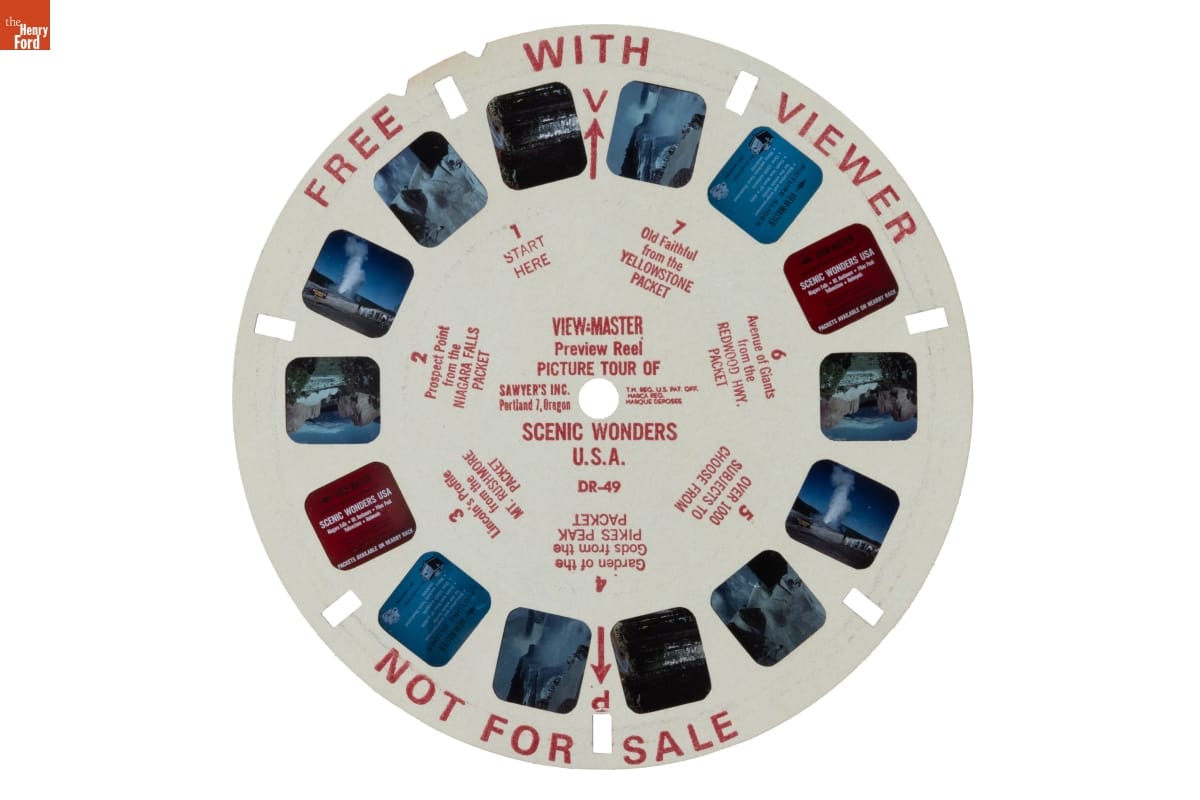
"Picture Tour of Scenic Wonders U.S.A." View-Master Reel, 1960-1966 / THF371614
Charles “Chuck” Alfred Harrison Jr. was born in Shreveport, Louisiana, in 1931. His family moved around frequently when Harrison was a child, from Louisiana to Texas to Arizona. He became interested in industrial design while studying at the City College of San Francisco and, after graduation, applied to all the accredited industrial design programs in the United States. He was accepted to the School of the Art Institute of Chicago (SAIC) on a four-year tuition and travel scholarship.
Although he was the only Black student in his classes at SAIC, Harrison felt that “in the arts, racism seemed to be less intense than other places.” He graduated from SAIC in 1954, but then was drafted into the U.S. Army, where he learned to be a mapmaker and was stationed in Germany for nearly two years. Harrison was discharged from the Army in May of 1956, and he returned to the SAIC. After a semester though, he transferred to the Illinois Institute of Technology and completed a master’s degree in art education because it was the only program with night classes and he needed to work during the day.
Harrison began to look for design work, but repeatedly faced racist companies and hiring managers. In the fall of 1956, he applied for an industrial design job at Sears. The company’s manager of design, Carl Bjorncrantz, told Harrison that he would like to hire him but that “Sears has an unwritten policy against hiring Black people.” Instead, Bjorncrantz hired him as a freelance designer, which was allowed. Harrison freelanced for numerous Chicago-based design companies in the following years, completing work for RCA, Grinnell Brothers Piano, Davis Sweeper Company, Williams Electric Company, Victory Manufacturing Company, Montgomery Ward, Allied Radio, and many others. Harrison began to work with injection molded plastics in 1957 — with butter dishes, his first mass-produced product, and later, with measuring cups, sweepers, and plastic pails. It was around the same time that Harrison, then freelancing under Robert Podall Associates, received the assignment to redesign the View-Master.
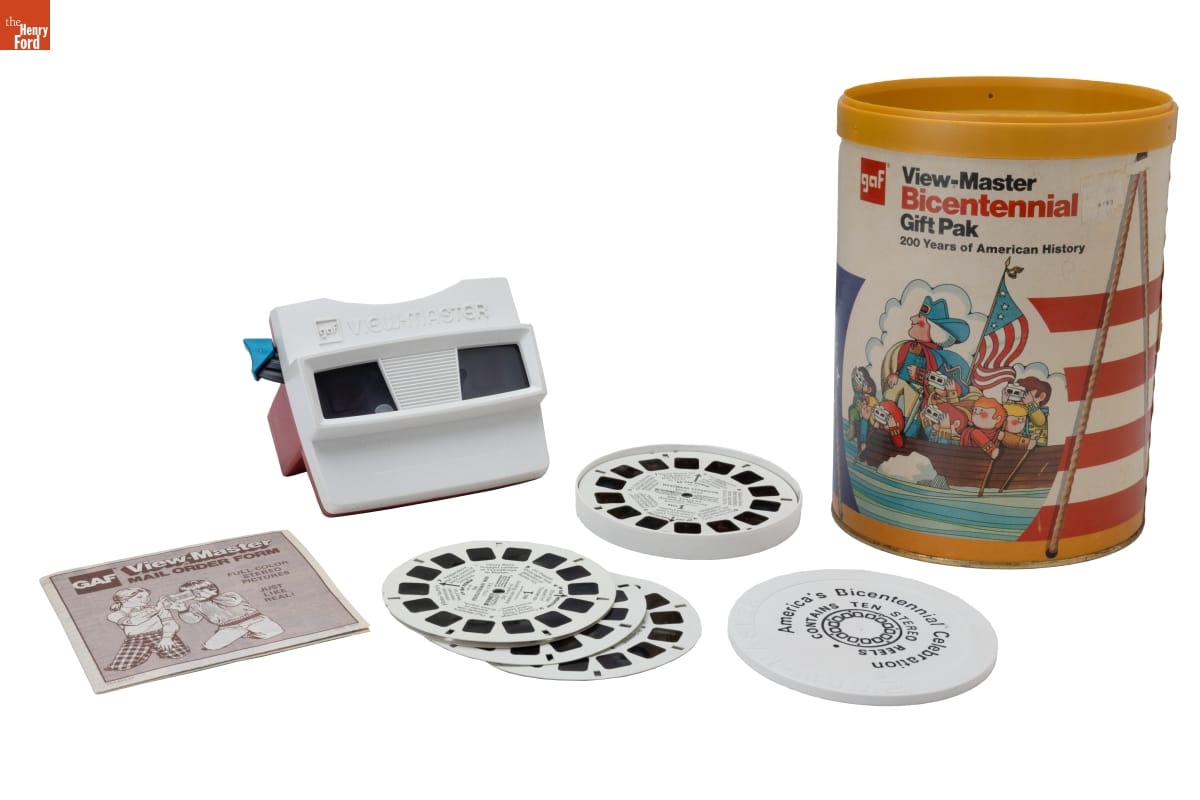
In 1966, General Aniline & Film (GAF) acquired Sawyer’s and began to produce View-Master. For the 1976 American Bicentennial, they produced a special Bicentennial Gift Pak with a special red, white, and blue version of Harrison’s Model G View-Master / THF371564
In 1961, Carl Bjorncrantz from Sears called Harrison, saying, “Well, Chuck, we can hire you now.” Harrison declined at first. But after a conversation, he took the job and became the first Black executive at Sears headquarters. Harrison rose through the ranks to eventually lead the design group at Sears. He designed hundreds of manufactured products in his career — lawn mowers and power tools, pots and stoves, and the very first plastic trash can. He retired in 1993, when the company closed its in-house design department.
After his retirement, Harrison taught at his alma mater, the School of the Art Institute of Chicago, as well as a few other Chicago-area colleges.
He was president of the Chicago chapter of the International Designers Society of America and involved with the Organization of Black Designers. In recognition of his impactful and groundbreaking career, Harrison received a lifetime achievement award from the Smithsonian’s Cooper Hewitt National Design Museum in 2008 and an honorary doctorate from SAIC in 2009. Harrison passed away in 2018.
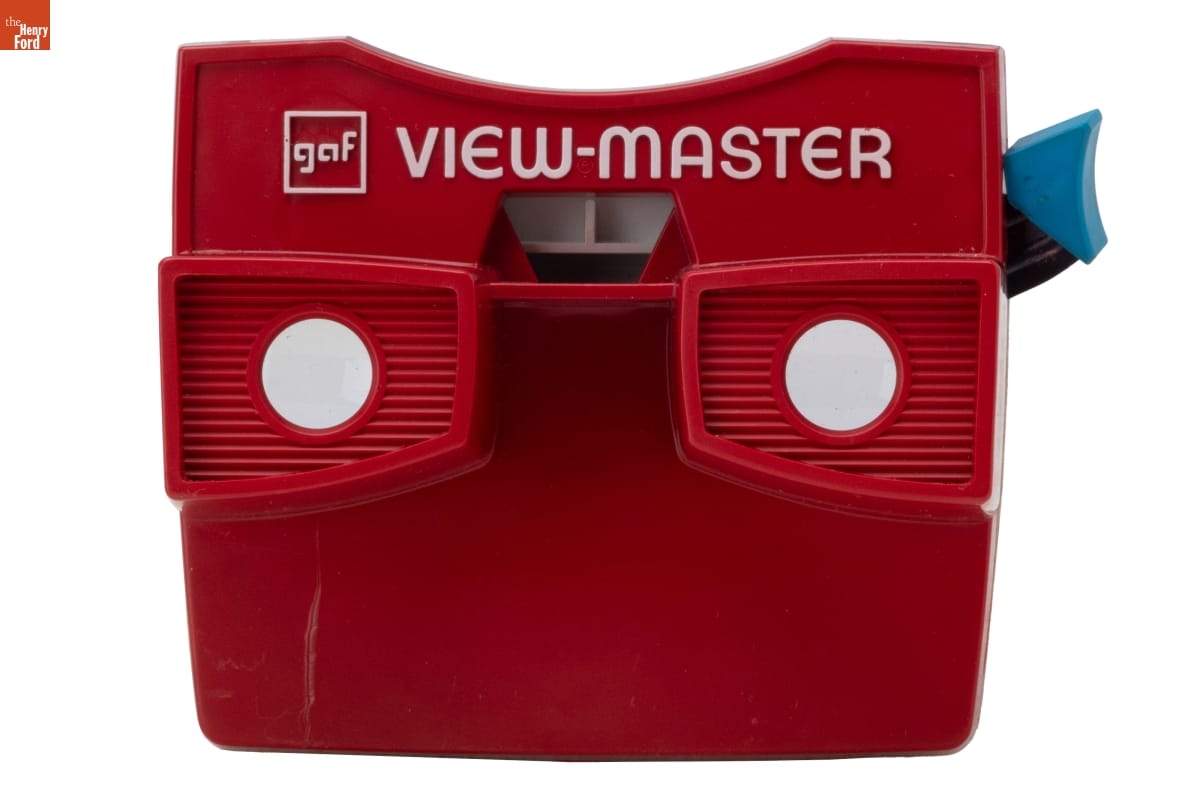
Red Model G View-Master, 1976 / THF371568
Katherine White is Curator of Design at The Henry Ford. She has fond memories of playing with a Charles Harrison-designed bright red Model G View-Master as a child. All quotes were excerpted from the book Charles Harrison published in 2005, A Life’s Design: The Life and Work of Industrial Designer Charles Harrison.
More Lessons to Share: The Preservation of the Dr. Sullivan and Richie Jean Sherrod Jackson Home
Voting is the most important right of American citizens. It is a foundational tenet of American-style democracy. Dating back to the basics of the country's Revolution, our ability as Americans to decide how our country will be governed and represent our interests, across the human spectrum, has always been a practice and challenge to the status quo. Across our history, access to our civil rights reflects the deepest of American beliefs. As we reflect on 60 years of the Voting Rights Act in 2025, The Henry Ford also approaches the opportunity to re-present the story behind the Act. A story of collaboration, rooted in community, family, and justice.

The Jackson Home at its location at 1416 Lapsley Street, Selma. / Image from the THF collections.
The Dr. Sullivan and Richie Jean Sherrod Jackson Home is pivotal as one of several key locations to the Selma Voting Rights Movement, a cornerstone of the long struggle for civil and human rights in the United States. You might be familiar with some aspects of the voting movement in Selma, a city in the heart of Alabama’s Black Belt. It is here that several organizations including the Dallas County Voters League, the Student Nonviolent Coordinating Committee, and the Southern Christian Leadership Conference all worked together between 1963 and 1965 to demand the rights promised to African Americans under the 14th and 15th Amendments: full citizenship under law to cast our vote without fear of repercussions or violence.

Campaign card, James E. Gildersleeve for City Council In the Democratic Primary, Selma, Alabama, March 17, 1964. The Dallas County Voters League, of which James Gildersleeve was a leading member, led local organizing in Selma./ THF721746
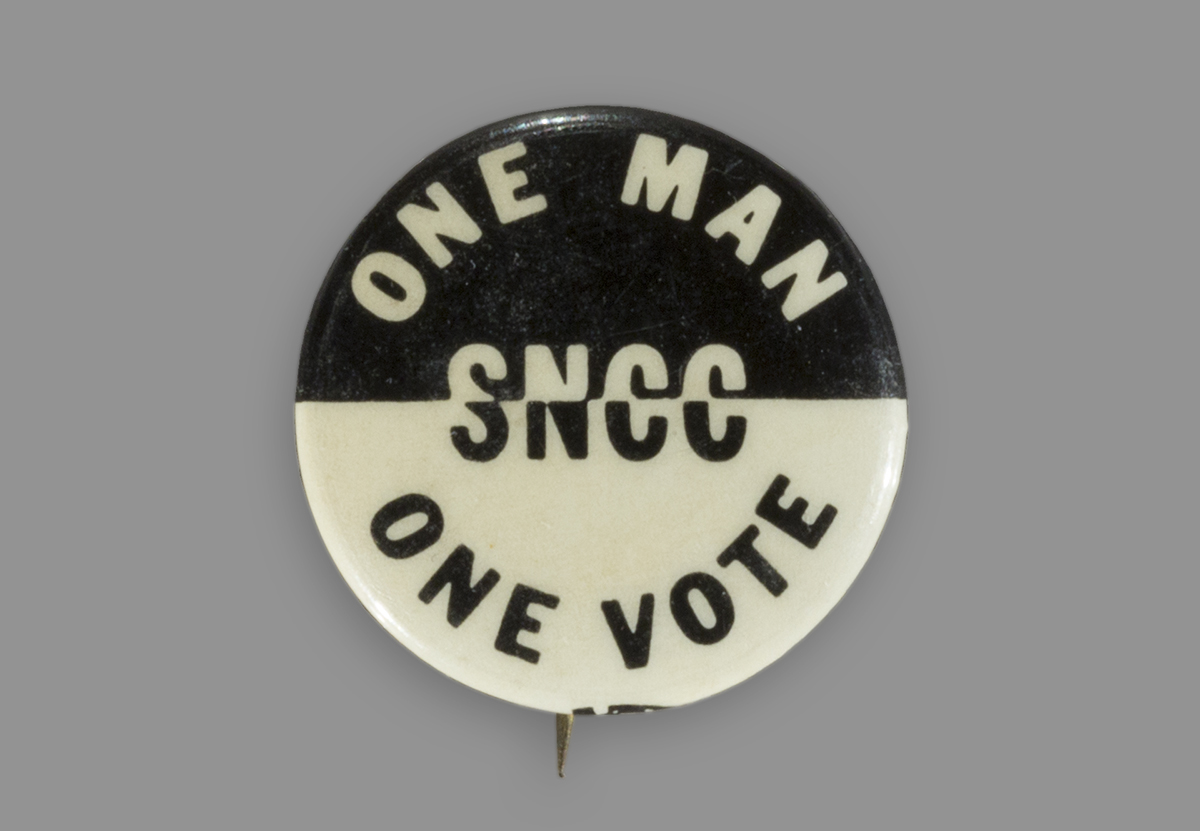
Button, "One Man One Vote SNCC," 1960-1967. / THF166834
People like Congressman John Lewis, Diane Nash, Bernard Lafayette, Amelia Boynton, Marie Foster, the Reverend Dr. Martin Luther King Jr, Andrew Young, Hosea Williams, and the Reverend Ralph Abernathy among dozens of others, supported by foot soldiers and community members on the local, state, and national levels moved to do what seemed impossible. People from across the country, with support from all over the world — all backgrounds, beliefs, and abilities — demanded that the white supremacist, legal practices of voter suppression end throughout the United States.
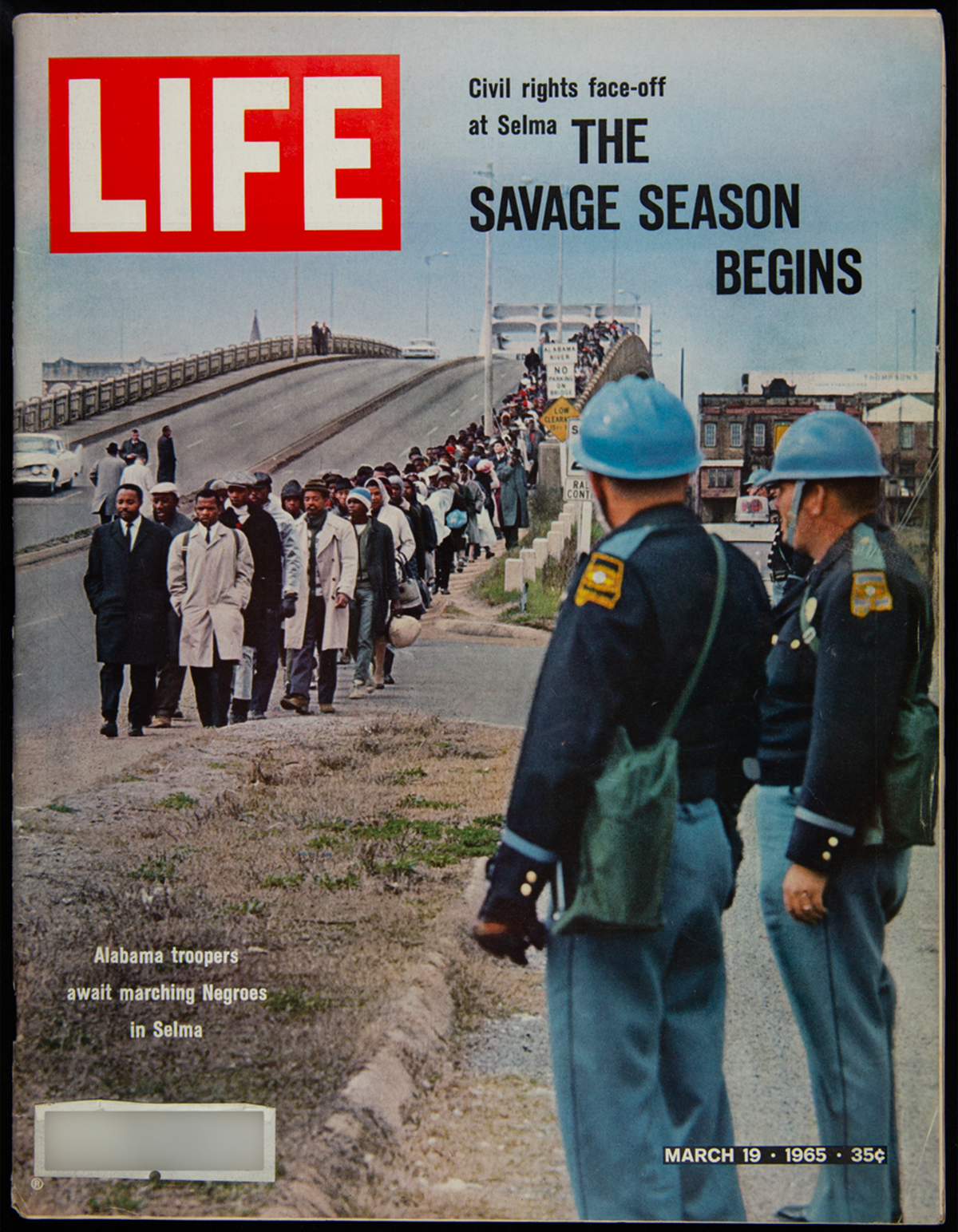
"Life" Magazine, March 19, 1965 – Cover. The “Bloody Sunday” march was captured on film, leading to hundreds coming to Selma to support protesters. / THF715919
Between January and June 1965, the Jacksons’ home became a haven for Dr. King and the headquarters for the Southern Christian Leadership Conference in Selma — with Dr. King's presence bringing the media and international attention that would be game-changing for the Selma movement. As the world looked at the violent acts that welcomed protesters on March 7, 1965 — Bloody Sunday — in shock and disgust, the calls for accountability and change reached the White House. On March 15 President Lyndon B. Johnson, in an address to the nation, declared that “we shall overcome” — his pivotal acknowledgment of the work that had been done and his willingness to move towards what would become the Voting Rights Act, signed in August 1965.
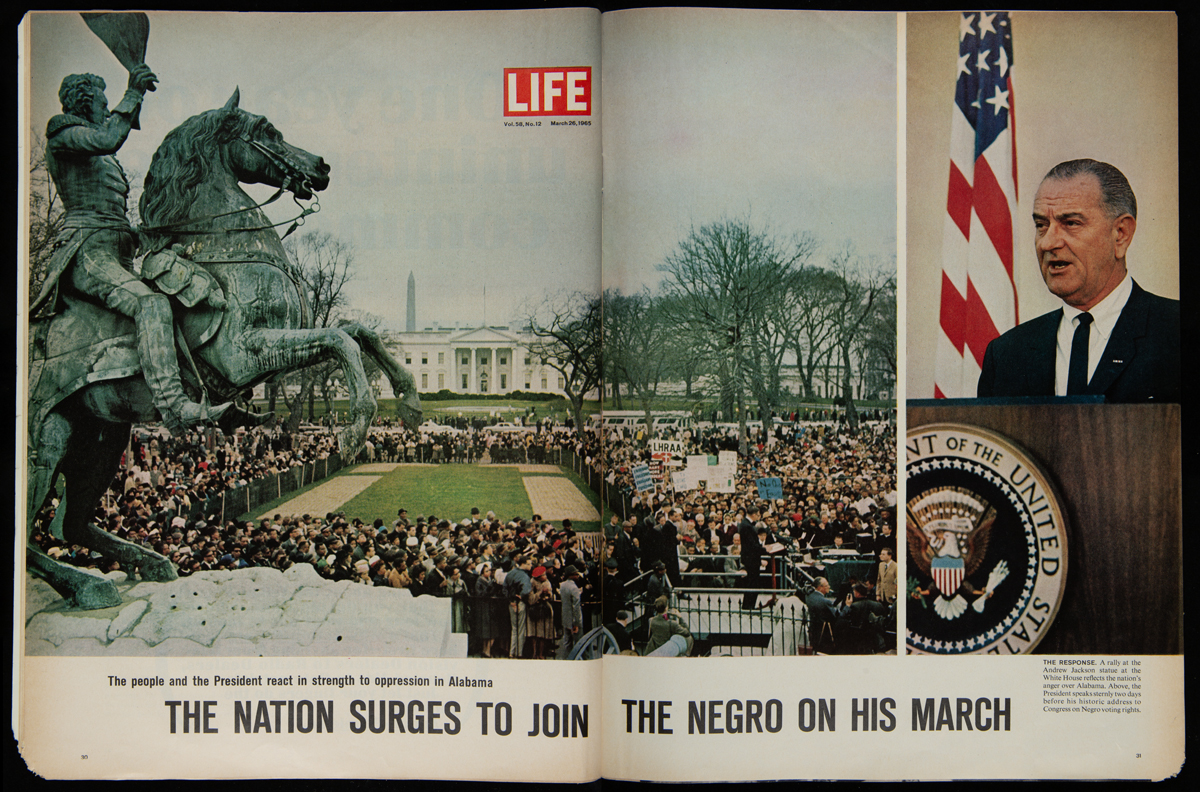
"Life" Magazine, March 26, 1965 – pg 30-31. / THF715929
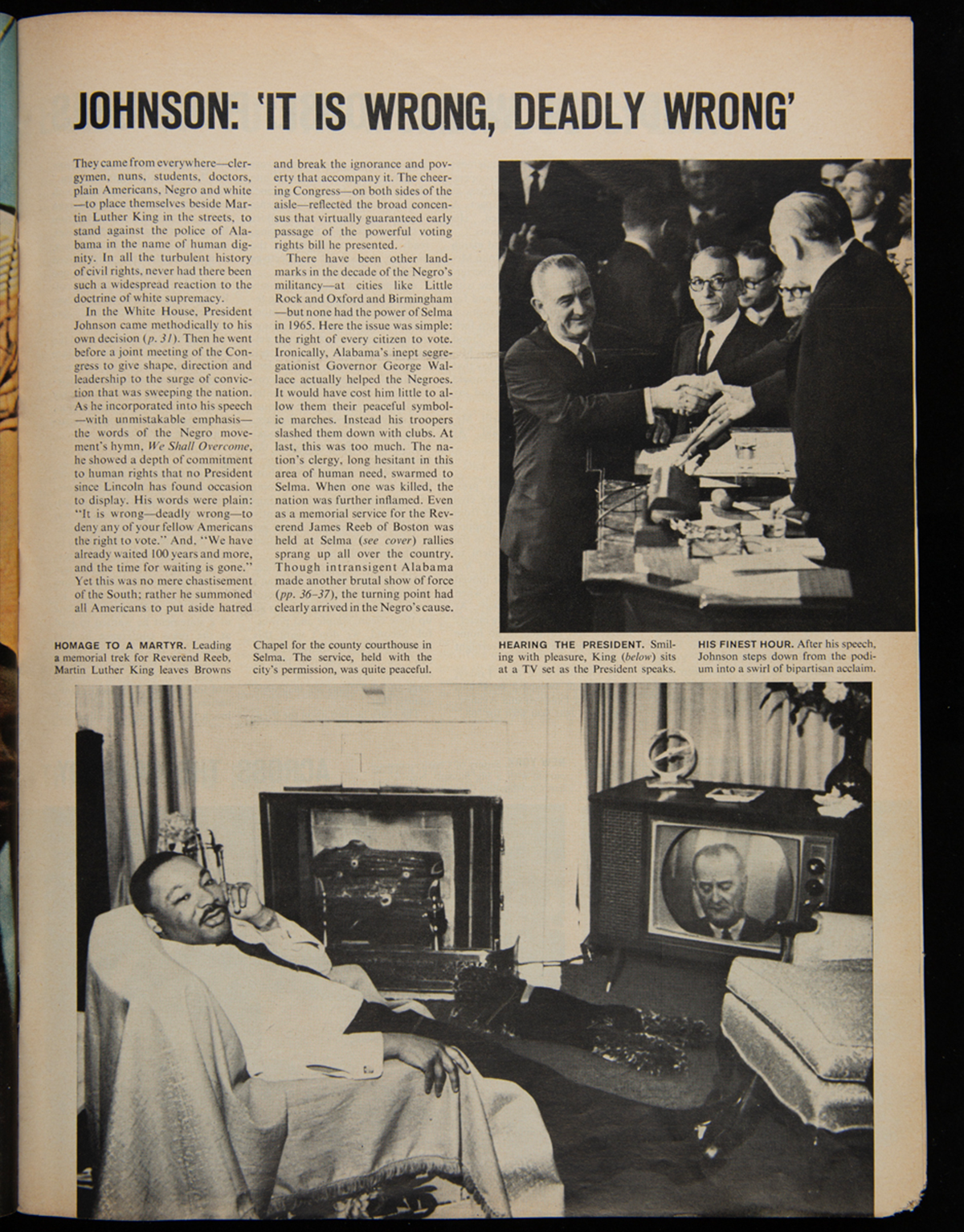
"Life" Magazine, March 26, 1965 – pg 33. Dr. King watched President Johnson deliver his speech from the living room of the Jacksons' home. / THF715931
As the first building preserved and moved to Greenfield Village in over four decades, the Jackson home presents several unique opportunities and challenges that bring together historic preservation, interpretation, and Black American history in the 21st century. Surprisingly, the easiest part in the process has been placing the Jacksons within the historical record of the Selma Voting Rights Movement — a well-documented collection being the linchpin. Sullivan and Richie Jean, knowing too well how important the event they took part in was, held on to many of the items that made their home a refuge in 1965. From the chair that Dr. King sat in to watch President Johnson address the nation, to the many cooking utensils and tools used to craft meals for movement makers and dreamers, to sentimental things like photos of family and friends in their Lapsley Street home, to the baby clothes for their one and only child. Now, these materials are helping us to bring life to the home, now on Maple Lane, as we restore the building to its 1960s appearance. The materials are also helping us shed light on a family whose connections run deep in the foundations of the Black professional and middle class in Selma and beyond.

The Jackson Home was bisected and driven in two parts to its final location in Greenfield Village. / Image from the THF collections.
What's most exciting for me is to be able to share with each of you the story of not just the Selma movement, and not just Dr. King's role — but the dozens to hundreds of everyday local people who opened their doors to ensure that those who were organizing on our behalf had places to stay, food to eat, and time to rest and to recharge for the next day's battle. Dr. Sullivan and Richie Jean Jackson, through their decision to open their door for their dear friend Dr. King, opened the door to new possibilities for our collective future. It's written all throughout Mrs. Richie Jean's book The House by the Side of the Road. In its pages you will see just how dedicated this community was to not only making things better for themselves, long before the 1960s, but also transforming the world for all of us, and the many generations to come.
It is my extreme pleasure to re-introduce the world to the story of the Jacksons — which comes to us in a moment when voting matters more than ever. Reminding us that there is so much more that this old home from Lapsley Street in Selma has left to teach us. Over the next year, the story of the Jacksons and the Selma movement will be shared by the Henry Ford team in multiple ways from preservation and collections to outreach and education and of course historic preservation — all in preparation for our opening in late spring 2026. There's much work to do but I hope all of you will open your ears, hearts, and minds to the lessons still left to be taught by the House by the Side of the Road.
Amber N. Mitchell is Curator of Black History at The Henry Ford.
Over the Hills and Far Away: The American Committee for Devastated France Good Will Delegation Tour
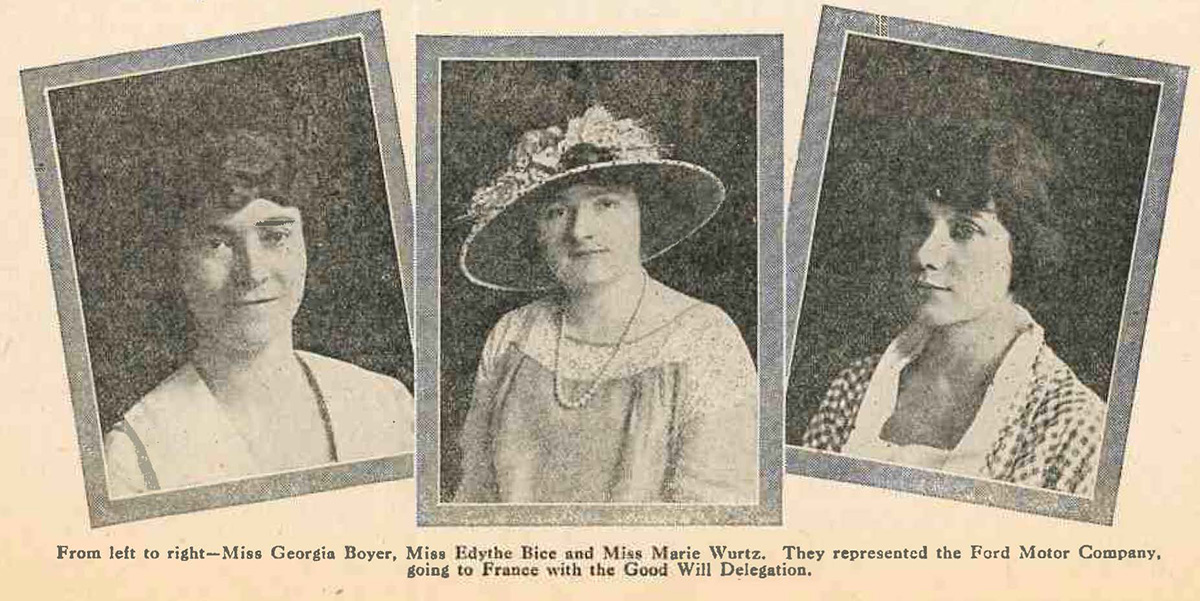
Ford delegates Georgia Boyer, Edythe Bice, and Marie Wurtz. Ford News, October 8, 1922 / Image by Kathy Makas
In 1922, three Ford Motor Company employees were sent to France as part of the American Committee for Devastated France Good Will Delegation Tour to raise awareness of the challenges and needs of the people there. The committee itself was formed during WWI by philanthropist Anne Morgan and physician Anne Murray Dike. Before the war had ended, the committee was soliciting funds and donations and in response, Ford Motor Company sent cars, tractors, and crates of car repair parts to the organization to help relieve war torn France. After the war, while Americans were moving on from the Great War, the committee wanted to remind them that France was still reeling from the years of fighting it had seen. To this end, the Good Will Tour was formed consisting of young female delegates contributing $10,000 each from major American companies. To raise the money, candidates were chosen from within their company by popular vote, with each vote costing $0.10; the only requirements were that they were women engaged in paid work and over 18 years of age.
Ford Motor Company jumped into the fundraising role, placing voting boxes with signs that read "Have you voted today?" in every department and placed publicity in newspapers and special announcements. The company raised enough money to send three delegates, two chosen by popular vote, Edythe Bice and Marie Wurtz, and one as the longest female employee at Ford, Georgia Boyer.
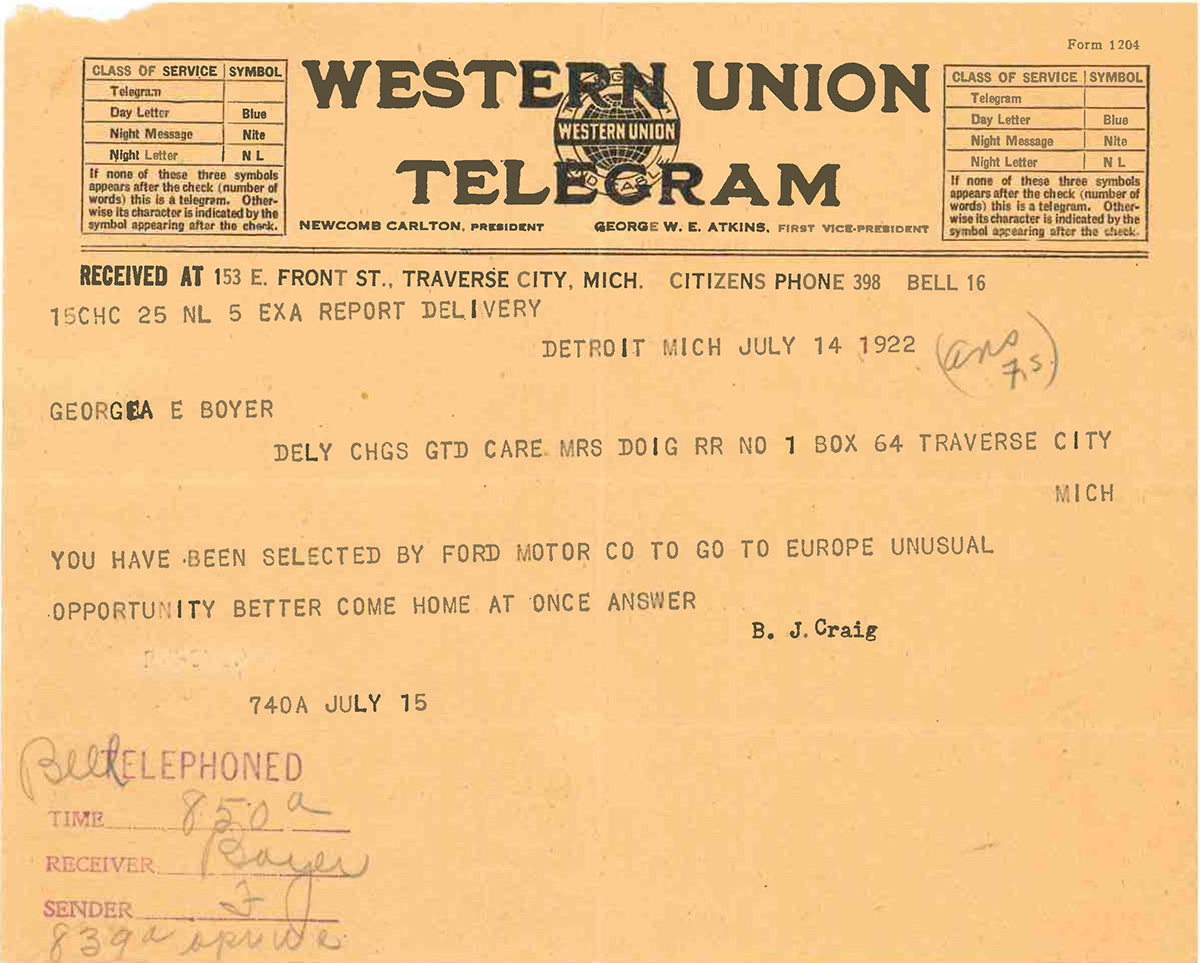
Boyer received word she was chosen while away from work. Acc. 395 / Image by Kathy Makas
On July 26, 1922, the delegation left New York City on the steamer La France for Havre with $500,000 total for committee efforts in France. The tour started in Paris and made its way through the devastated region, traveling through Soissons, Vic-sur-Aisne, Reims, Verdun, and other towns. Boyer noted, "All through this devastated section we saw miles and miles of shell holes, barbed wire, stumps of trees, several dugouts and a few tanks and machine guns which were left by the Germans. Hundreds of buildings, homes and churches were destroyed all through this section, also some beautiful chateaux." But through the work of the committee and other organizations, new buildings and reconstruction were going on all around. The delegation saw the laying of the cornerstone of the Baby Welfare Station and a parade with hundreds of babies marched down the streets in decorated baby carriages. Still, the toll of the war was shocking to the American group. Bice recalled, "As we journeyed towards Verdun it was hard to realize that the war had been over four years. All along the way were shell-torn fields, trenches, dugouts, barbed wire still standing as they were placed, and wire still strung between the trees from which the camouflage screens were hung."

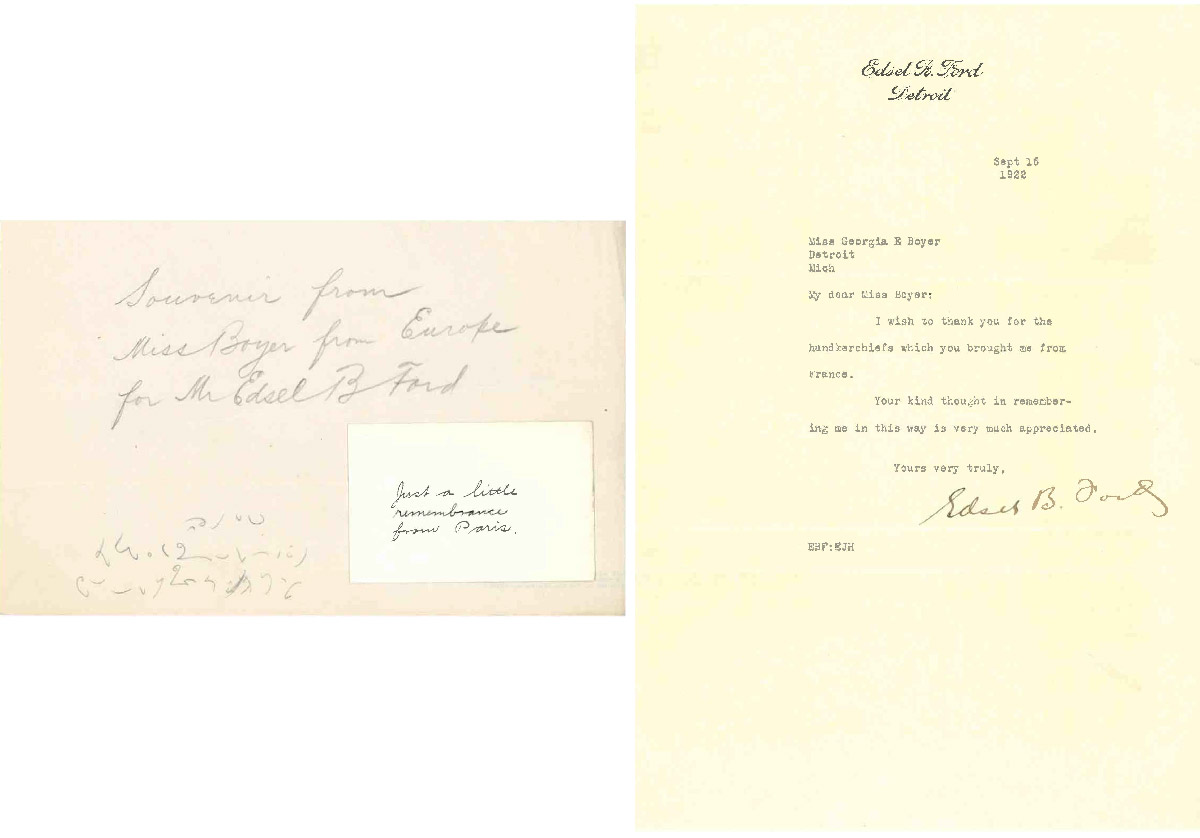
While they were visiting France, Bice and Boyer both wrote to Edsel Ford. Acc. 6 box 5 / Image by Kathy Makas
The delegates made their way back to New York on September 8 bringing with them stories of the destruction, but also of the work that the committee was performing. A series of articles about their time on the tour was published in the Ford News, and Bice presented a talk on Ford's WWI radio station. Bice shared in a Ford News article, the American Committee "is reconstructing not only destroyed material things, but the broken lives and spirits of a great and friendly people. More than that it is making a constructive contribution to the perpetuation of the civilization which 80,000 of our own Americans died to preserve." The committee engaged in work in France for a few more years, before discontinuing in 1924.
Learn more about this and other material in the Benson Ford Research Center.
Kathy Makas is a reference archivist at The Henry Ford.
A Bone to Pick with the Writing and Fallout of Mule Bone
The play Mule Bone was the brainchild of Langston Hughes and Zora Neale Hurston, two literary giants of the Harlem Renaissance. They sought to bring authentic Black stories to the American theatre through this collaborative piece. Instead, the project turned their friendship into a bitter feud.
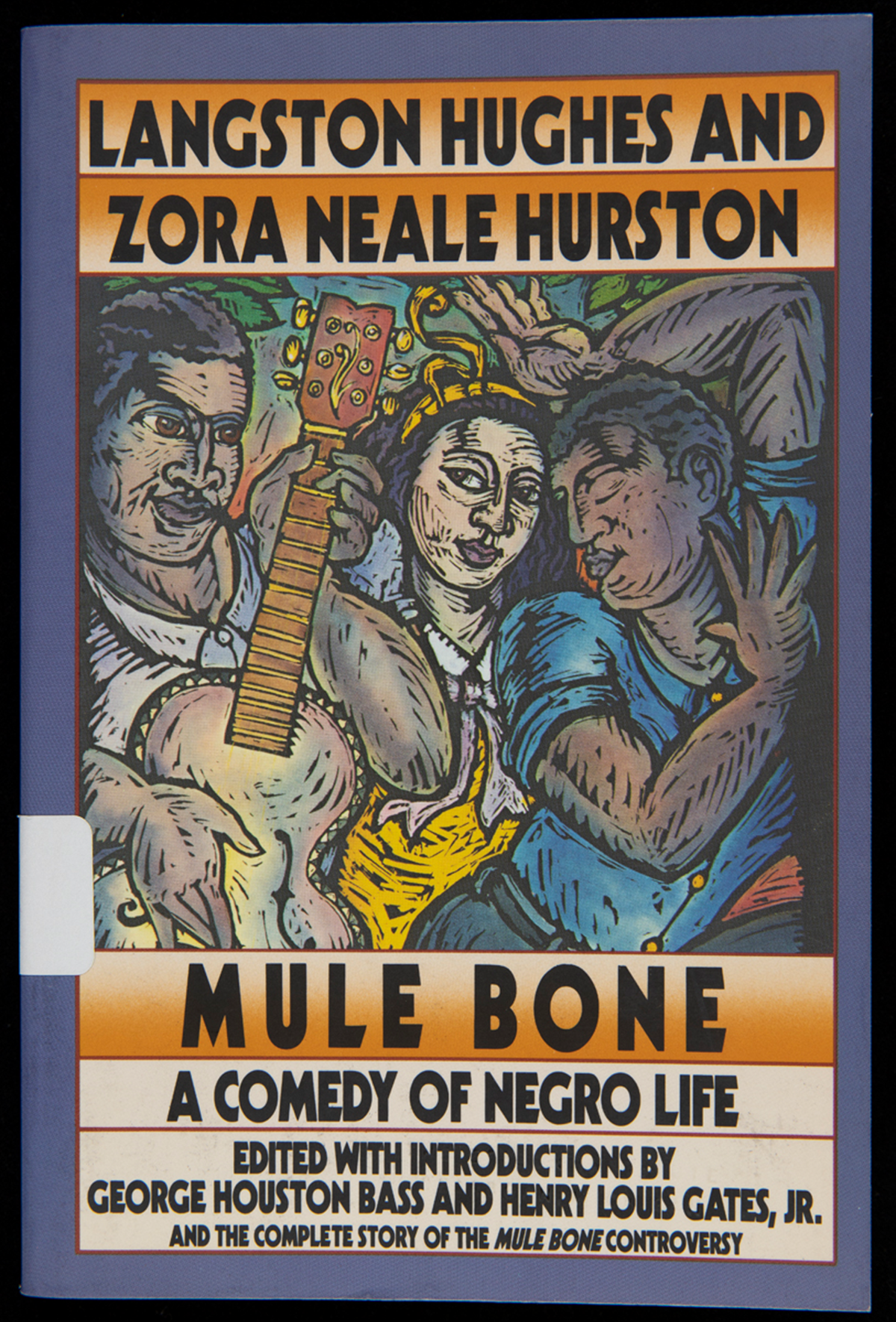
Mule Bone: A Comedy of Negro Life, 1991. / THF278631
Langston Hughes (1901 or 1902-1967), one of the most well-known writers in American history, was a celebrated poet, novelist, essayist, and social activist. Zora Neale Hurston (1891-1960) is mostly remembered as a fiction writer today, but she was a multi-genre writer, anthropologist, and pioneer of ethnography — an anthropological practice that focuses on the studied culture's perspective. Hughes and Hurston met in 1926 at the Opportunity Magazine literary awards, where they both received prizes for their first published works. As two budding creators with new-found success, Hughes and Hurston formed a close bond immediately. They traveled together, holding lectures and readings throughout the American South. They co-founded Fire!! literary magazine with a cohort of other emerging Black writers and artists. Hughes introduced Hurston to their mutual benefactress, Charlotte Osgood Mason. Hurston addressed Hughes as "pal" and "bambino" in her letters and even confided in him about her failing marriage. This friendship sparked creative camaraderie, too. As early as 1927, Hurston envisioned writing together. She discussed ideas with Hughes based on her anthropological research and even proposed a collaborative opera to Charlotte Osgood Mason for monetary sponsorship.
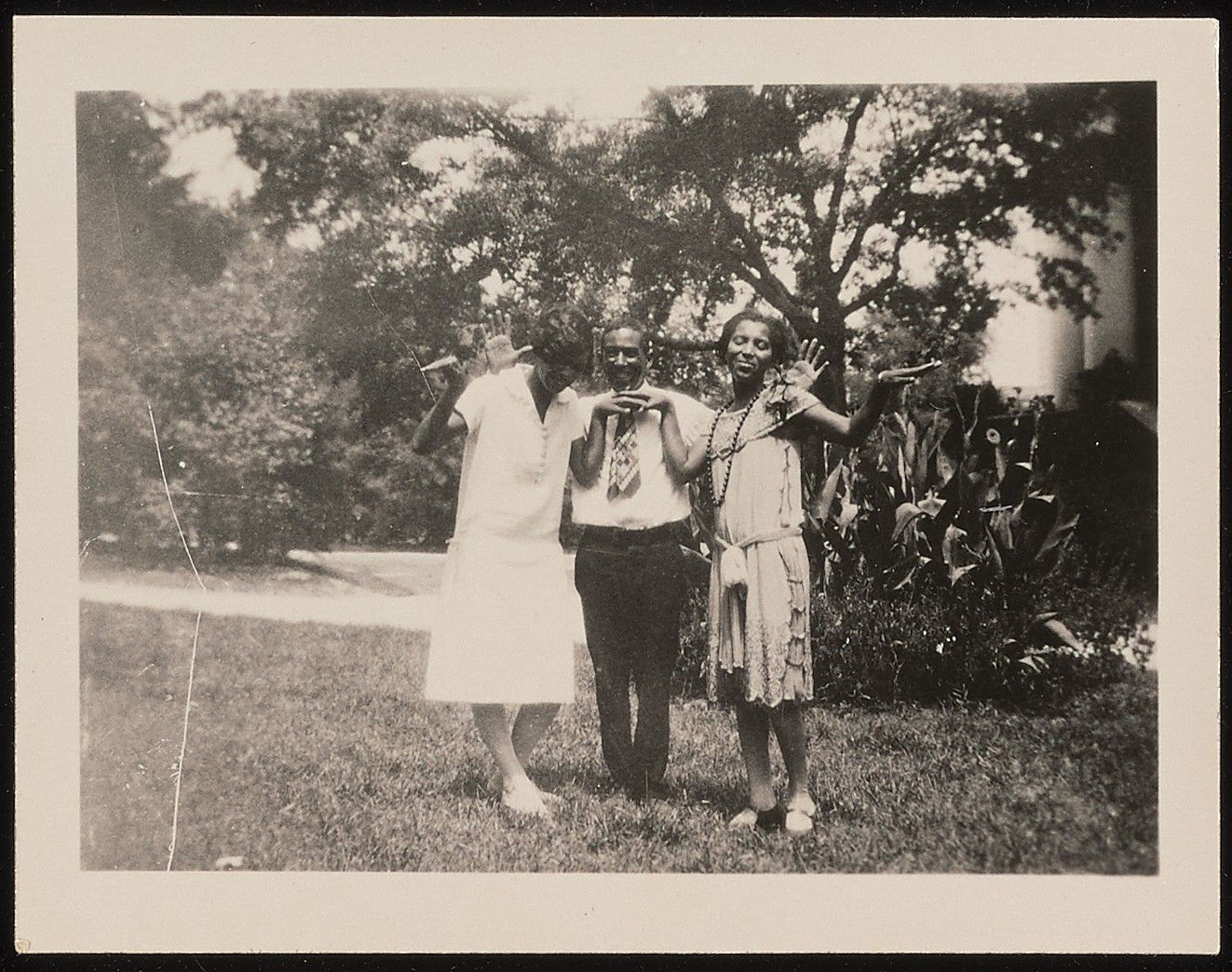
Hughes (center) and Hurston (right) pose with an unidentified friend in Tuskegee, Alabama, in 1927 / Via Langston Hughes paper at the Yale Beinecke Rare Book and Manuscript Library. You can find more of the Langston Hughes papers here.
Hurston and Hughes began writing their play, Mule Bone, in the spring of 1930. To facilitate the work, they hired Louise Thompson as the typist for the project. Thompson's presence eventually divided the two writers. Hughes advocated for Thompson to receive a percentage of future royalties, which Hurston objected to. Hughes later claimed Hurston was jealous of his friendship with Thompson. After working on Mule Bone, Thompson went on to become a prominent civil rights activist from the 1930s until her death in 1999.

"Free Angela Davis" Poster, 1970. Thompson (later known as Louise Thompson Patterson) led the New York Committee to Free Angela Davis. You can learn more about the Free Angela Movement here / THF721969
Additionally, Hughes and Charlotte Osgood Mason had recently cut ties on bad terms. The fallout likely amplified tensions. Hurston remained loyal to Mason whose patronage was her sole source of income, and Hughes regarded Hurston as Mason's lackey according to letters to friends.

Jonah's Gourd Vine, 1990 edition. Jonah's Gourd Vine, Zora Neale Hurston's first novel, was conceived during a 1929 anthropological trip that Charlotte Osgood Mason sponsored. Mason's patronage provided Hurston with financial stability in her early writing and research career. / THF278620
Regardless, Hughes and Hurston finished the first draft of Mule Bone in the fall of 1930. Hurston returned to her anthropology fieldwork at this time and put the project on hiatus. Promising to return and finish Mule Bone, Hurston took a copy of the script and their drafting notes with her. Hughes did not hear from her for months.
In November of 1930, Hurston sent a new version of Mule Bone to Carl Van Vechten--a photographer, writer, and tastemaker in the arts and literary world during the Harlem Renaissance. She claimed that the play was loosely based on ideas she and Hughes had workshopped, but that the script was her own. She hoped Van Vechten would use his connections to get the play produced. Van Vechten, unaware of a possible authorship dispute, sent Mule Bone to his theatre contacts. Rowena Jelliffe, the director of the oldest Black American theater troupe in the country — the Gilpin Players — received the script in mid-January of 1931. She loved the work and planned to produce Mule Bone at the Theater of Nations in Cleveland, Ohio. Coincidentally, Langston Hughes contracted tonsillitis in mid-January of 1931 and was recovering at his mother's home in Cleveland. Hughes was well connected in the literary arts scene in Cleveland, so when Rowena Jelliffe showed him the new script she was producing, he was shocked. This "new work" was his and Hurston's original play, Mule Bone, with a new ending.
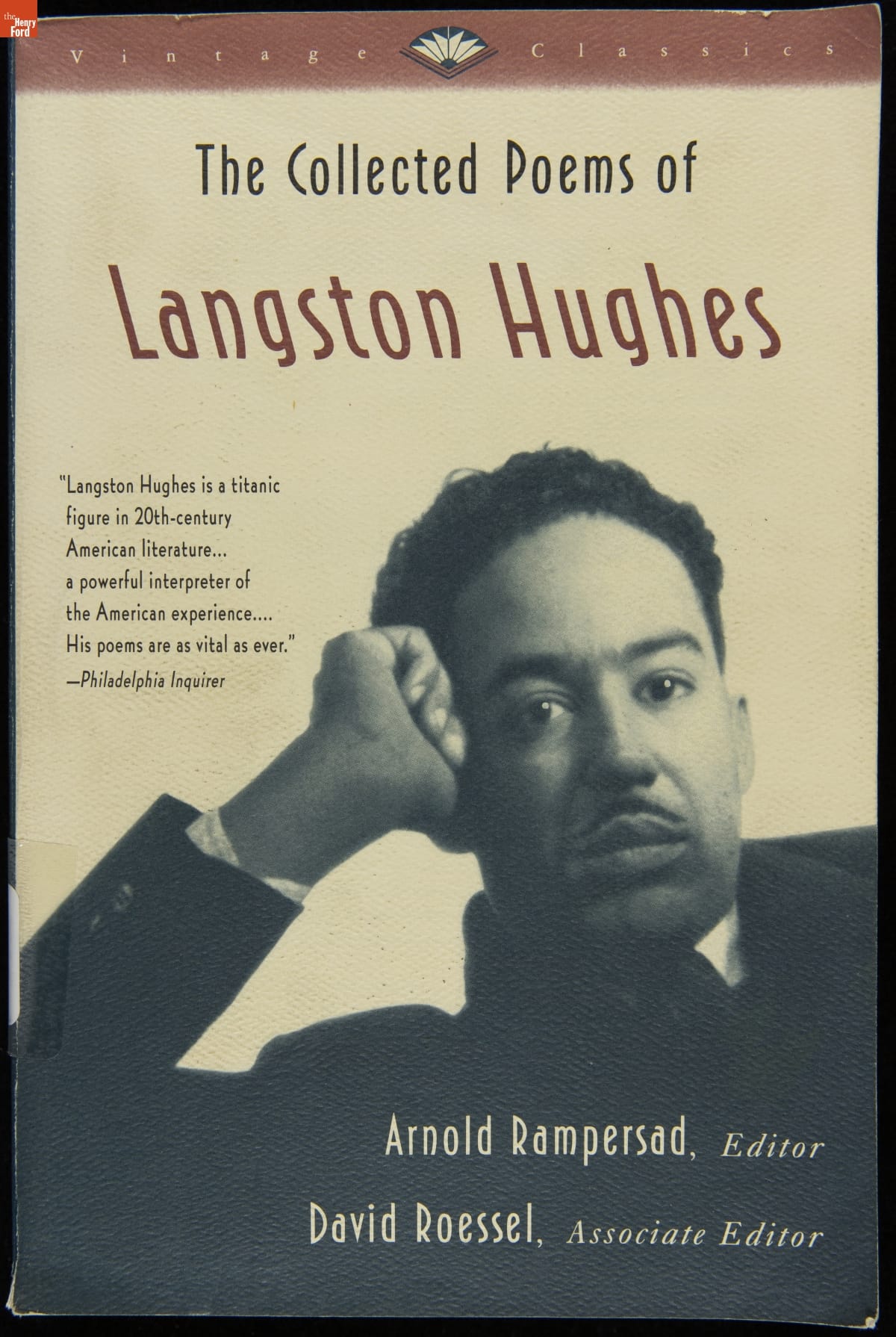
The Collected Poems of Langston Hughes, 1995. Hughes lived in Cleveland as a teenager, when he wrote his earliest poems. He also attended art classes at the settlement house Rowena Jelliffe founded. / THF278643
Hughes reached out to Hurston about the impending production. She did not return his calls, telegrams, and letters for nearly a week. When Hurston finally contacted Hughes, she said that she was the sole author of Mule Bone and accused him of manipulating her. Hughes said that the new draft undermined their work, calling it "all tangled up." Once this initial fight ended, however, Hurston agreed to name Hughes the co-author of Mule Bone. Hurston traveled to Cleveland, and the two completed a second collaborative draft of the script. Tensions rose again as they worked.
According to Hughes, the project and friendship ended at a dramatic luncheon on February 3, 1931. Allegedly, Hurston came to Hughes's mother's home for a meeting with Rowena Jelliffe and Hughes. Hurston accused Hughes of using Mule Bone to court Louise Thompson, reiterated that she alone wrote Mule Bone, and insulted the Gilpin Players, Jelliffe, and Hughes's mother. After Hurston left Cleveland that day, the two never spoke in person again. Hughes left a handwritten note on his copy of Mule Bone: "This play was never done because the authors fell out." In his autobiography, The Big Sea, Langston Hughes correlates this fight with the end of the Harlem Renaissance itself. Both Hughes and Hurston went on to great success in their respective careers after this, but Mule Bone remained unfulfilled work and was not produced until 1991, well after both authors' deaths.
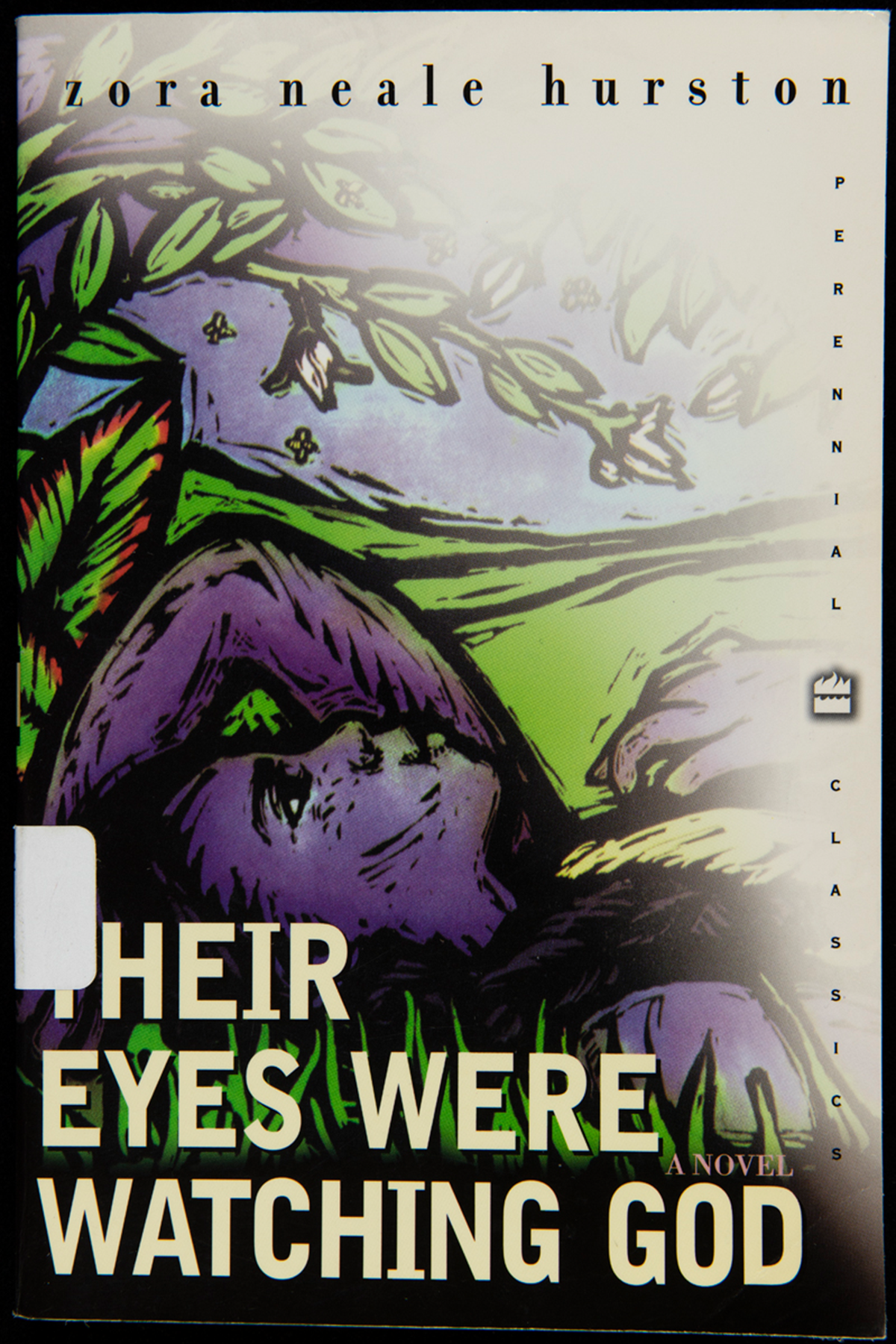
Their Eyes Were Watching God, 1990 edition. Most of Hurston’s famous works, including all four of her novels, were written and published after the Mule Bone controversy. / THF278625
The heart of this conflict is a question of authorship. The exact truth of who wrote what parts of Mule Bone is muddied. In Hughes's version of events, he created the main plot of the play about two friends fighting over the same woman. He claimed Hurston provided the play's Southern dialect. In Hurston's version, she wrote all of Mule Bone, and Hughes came up with a couple of ideas that she later cut from the script. To Hurston's credit, Mule Bone has many hallmarks of her work, demonstrating her sizeable contribution to the play. For example, Hurston often utilized Black American traditions such as children's games and signifying--mocking someone close to you — in her work, and these elements are present throughout Mule Bone. The subplot about a man on trial for beating someone with a mule's bone is based on one of Hurston's then-unpublished short stories. To Hughes's credit, he had mimeographs, handwritten notes, and a witness in Louise Thompson proving his involvement with the work. The reality is that Mule Bone was the work of two writers, and how much each one contributed remains debatable. We are left with a work of art whose creation fundamentally changed its authors' relationship.
Kayla Chenault is an associate curator at The Henry Ford.
Green Museum Work at The Henry Ford
The Henry Ford identified “Cultivating Environmental Responsibility” as one of its strategic goals in anticipation of its 100th anniversary in 2029. A few staff began assessing factors relevant to this goal in August 2019. The Henry Ford’s Green Team (previously the Environmental Focus Group) emerged out of this work and formally organized in May 2021 with responsibilities to benchmark and manage THF’s energy and water use and to reduce waste by recycling and composting. This work aligns with a call to action put forth in Sarah S. Brophy and Elizabeth Wylie’s The Green Museum: A Primer on Environmental Practice, namely, that going green “is becoming mainstream because of its importance, not its fashion” (pg 2).
You could argue that The Henry Ford has pursued green museum work since its beginning in 1929. Certainly, historical precedence lays a solid foundation for current initiatives. Three examples indicate how preservation, reuse, and local sourcing factored prominently in The Henry Ford’s history.
First, historic preservation is a green action. Committing to preservation and adaptive reuse rather than demolition reduces financial costs and energy expenditures.
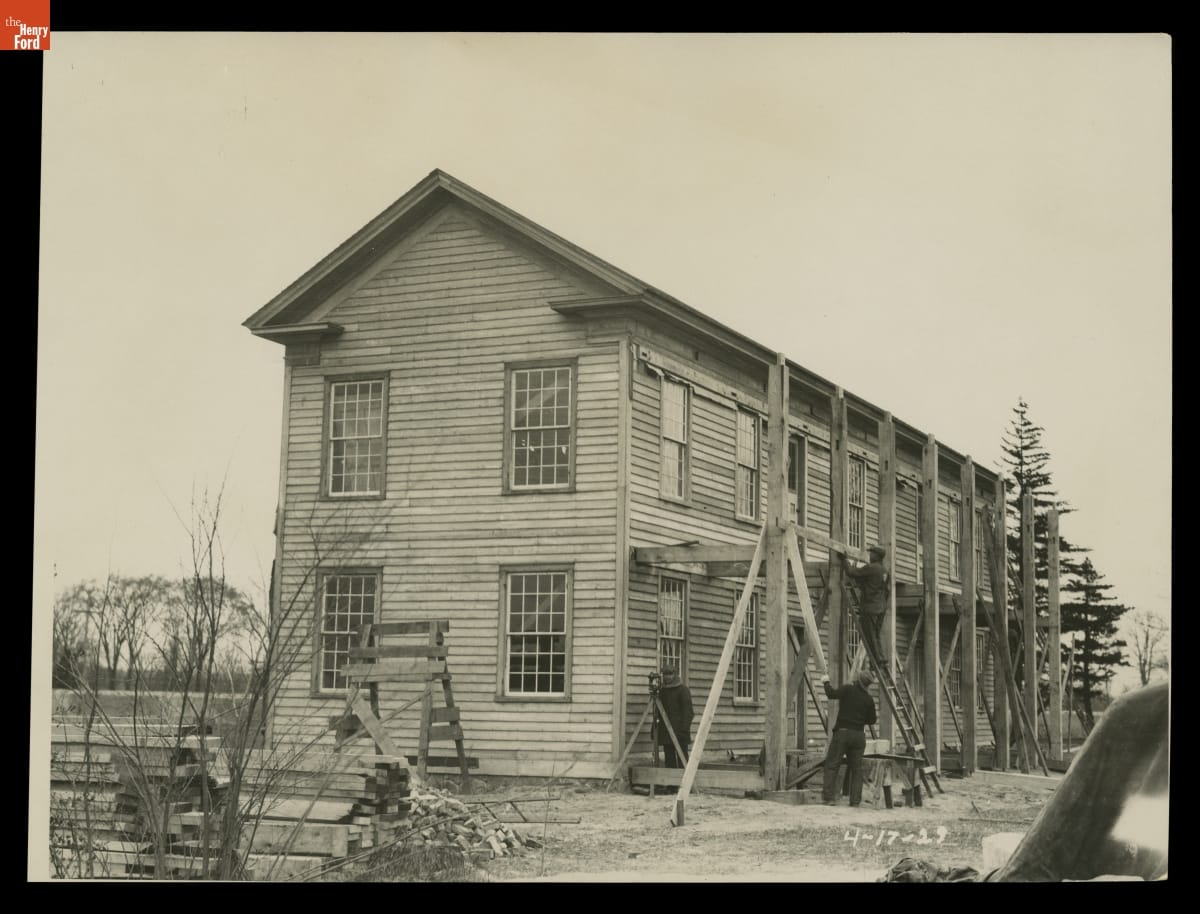
Rebuilding the Clinton Inn in Greenfield Village, April 1929 / THF149382
Second, reusing landscape features supports actions that reduce environmental degradation. Namely a pond created by laborers excavating clay for use in Anthony Wagner’s brickyard starting in the 1860s became a rainwater holding tank for the museum. Design masked the multi-part infrastructure that re-purposed runoff from museum roofs for use in landscape irrigation.
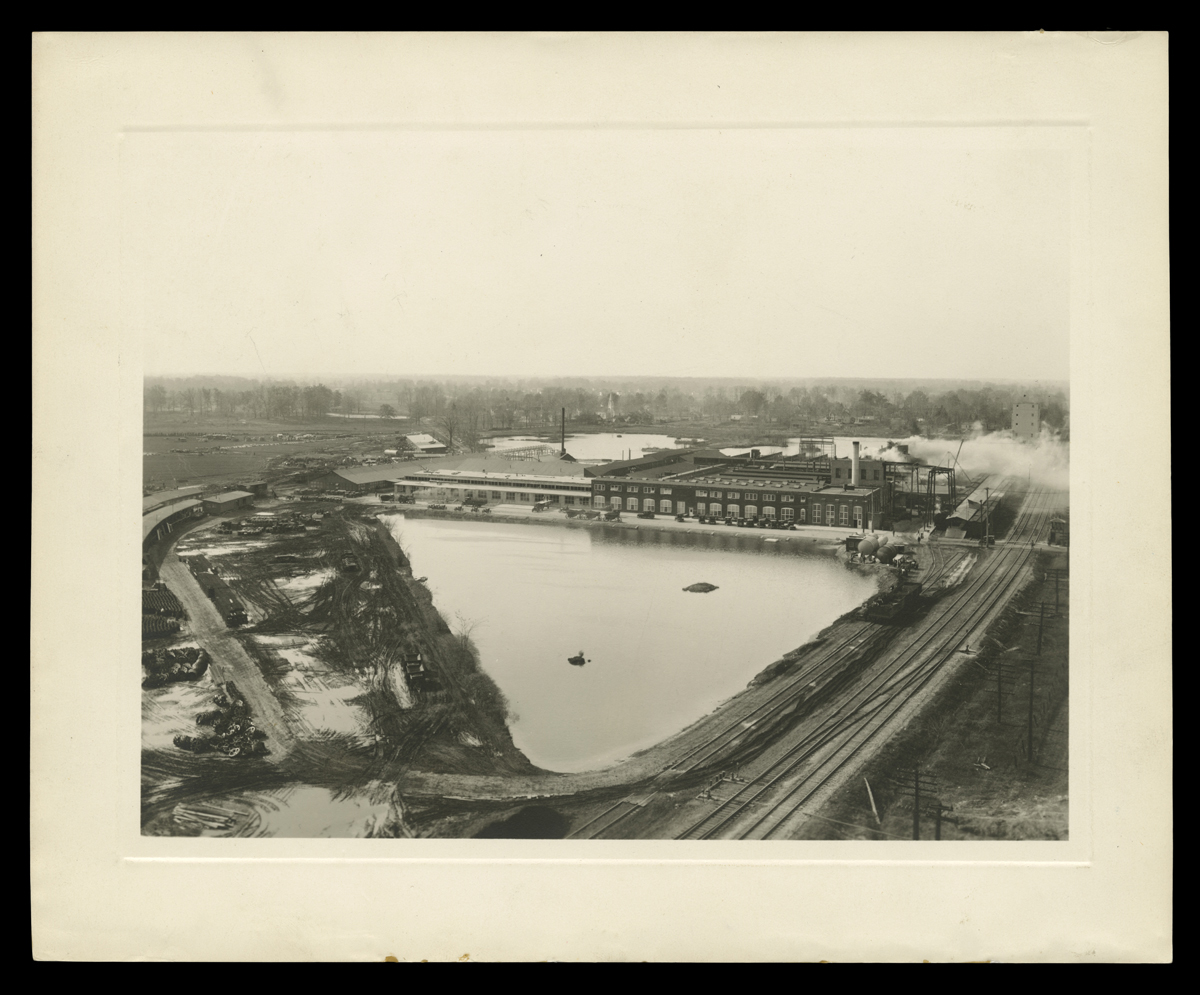
Pond adjacent to Henry Ford & Son’s tractor plant, October 22, 1918, and north of The Henry Ford’s staff parking area today, remains central to The Henry Ford’s rainwater management system / THF116967
Museum plans drafted in 1928 incorporated pumphouses in two courtyards that pushed rain runoff through a drainage system and into the pond. Facilities managers take this history of environmental change into account when undertaking pond and pumping infrastructure maintenance.
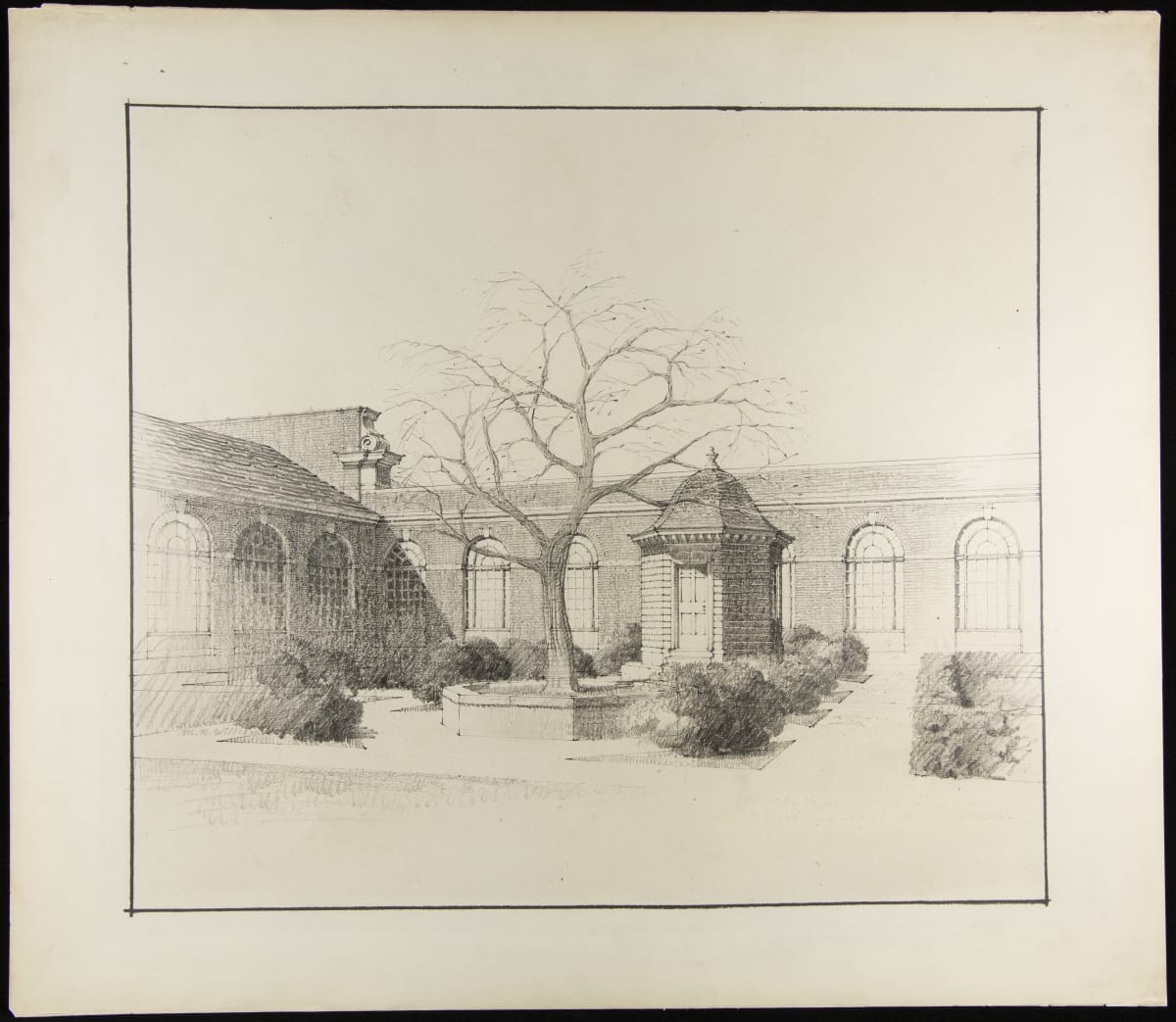
Drawing of the Virginia Court with pumphouse replicating a garden feature from Mount Vernon, 1928 / THF294374
Third, Henry Ford confirmed the importance of locally sourced materials when he constructed the chemical laboratory at the entrance to Greenfield Village. More than a dozen chemists worked in this structure, seeking domestic products for industrial use. By December 1931, soybeans became the focus of their research, and a new agricultural commodity took hold in southwestern Michigan. Ford joined others in Illinois, North Carolina, and beyond, exploring the potential of soybeans to meet local industrial demand for alternative oils for paint and alternative proteins for foods. Today we know that locally sourced products reduce carbon emissions by reducing transportation from the point of production to processing and consumption locations.
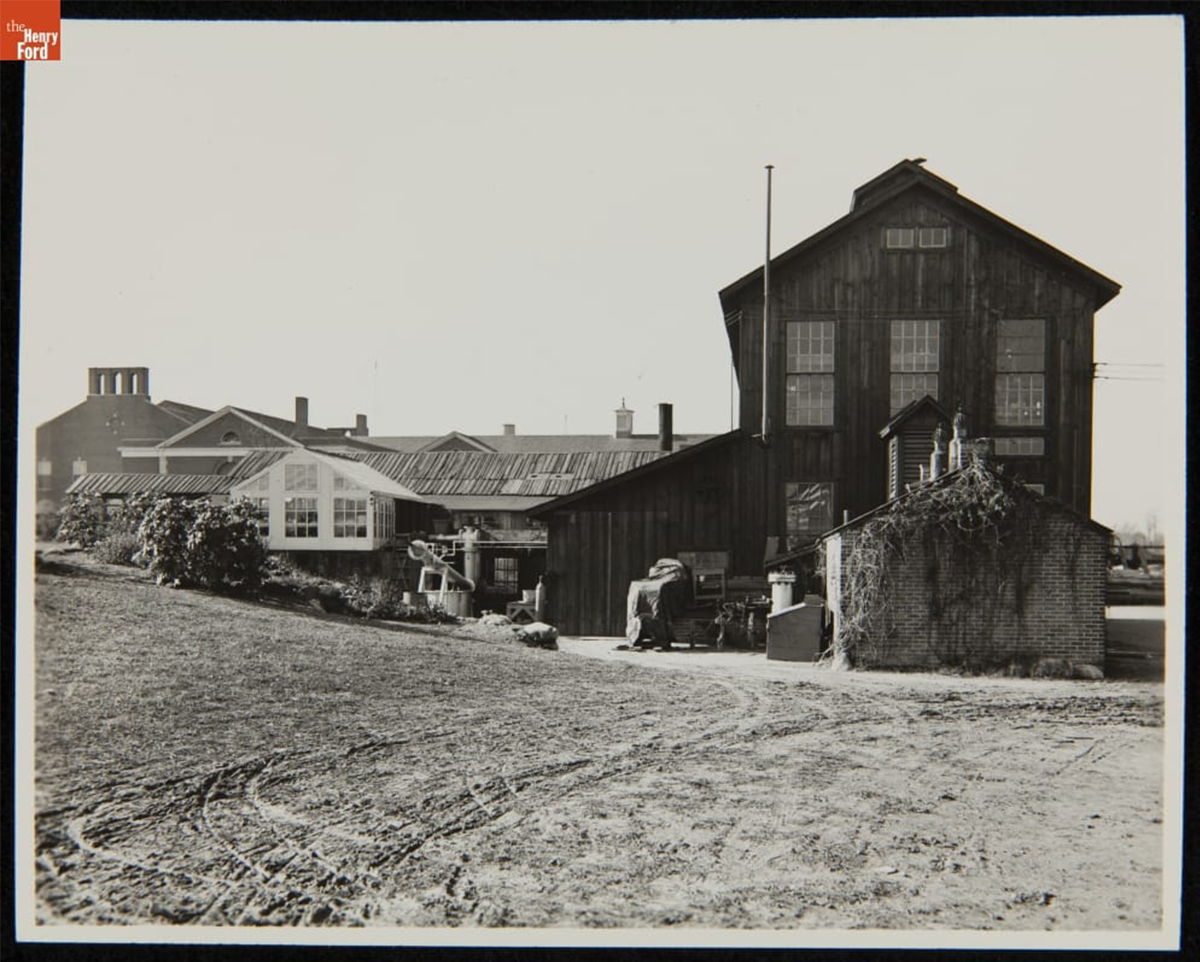
Chemical laboratory in Greenfield Village with Lovett Hall, The Edison Institute, visible in the background, 1930. This image predates Henry Ford instructing the chemists to focus on soybeans / THF236433
These historic approaches (among others) laid a firm foundation for Green Team actions over the past five years (2019 to 2024). Staff prioritized benchmarking, recycling, and composting as important steps toward cultivating environmental responsibility. Efforts aligned with national initiatives such as the Culture Over Carbon project, funded by the Institute of Museum and Library Services. More than 130 cultural institutions across the United States, including The Henry Ford, shared energy-use data that identified trends for the field. This supported a larger goal, to establish a cultural institution benchmark for Energy Star ratings.
Green Team members also engaged with Detroit’s 2030 District chapter through which they met with other museum and culture partners within and beyond the area. The national network of 2030 Districts, made up of businesses, cultural institutions, and municipal governments, all in efforts to pursue new models for urban sustainability and economic vitality. Ongoing conversations help put institutional work into context, including a signature accomplishment at The Henry Ford in 2024, namely, the installation and operation of the second biodigester in the Detroit area.

The Henry Ford staff, Amber Stankoff, producer (left) with Brian Egen, executive producer and head of studio productions (center), filming Alec Jerome, senior director of facilities management and security, discussing the biodigester installed at Stand 44, the new restaurant in Greenfield Village, June 26, 2024. Photograph by Debra A. Reid.
These actions are steps on the longer path toward cultivating environmental responsibility. Extending information more broadly to THF staff and guests makes clear how each of us will contribute to realizing this ambitious goal. Doing so will ensure a more stable environment for staff and guests in perpetuity.
Debra A. Reid is curator of agriculture and the environment at The Henry Ford and has been a member of the Green Team since its formation. She serves on the Climate & Sustainability Community of the American Association for State and Local History and is the secretary of the International Council of Museums' international committee, SUSTAIN (Museums and Sustainable Development).
Adventurous Dining, Audacious Art
In 1963, the artist, activist, and educator Corita Kent worked in partnership with the American seasoning brand Spice Islands Company to create this publication, “International Dining with Spice Islands.” Originally sold as a mail-in incentive, it contains culinary histories, recipes, and suggested menus that are aimed at demystifying global cuisine for American home chefs. The folded paper presentation sleeve contains ten booklets focused on the cuisine of “nine of the world’s most savory kitchens”: France, India, Japan, Germany, Italy, Spain, Greece, Israel, and Sweden. Unfolding the unassuming gold and cream-colored outer sleeve, a kaleidoscope of movement and color emerges. Each of the ten booklets inside is wrapped in a colorful reproduction of a Corita Kent serigraph—overlaid with a handwritten proverb relating to the cuisine featured inside.
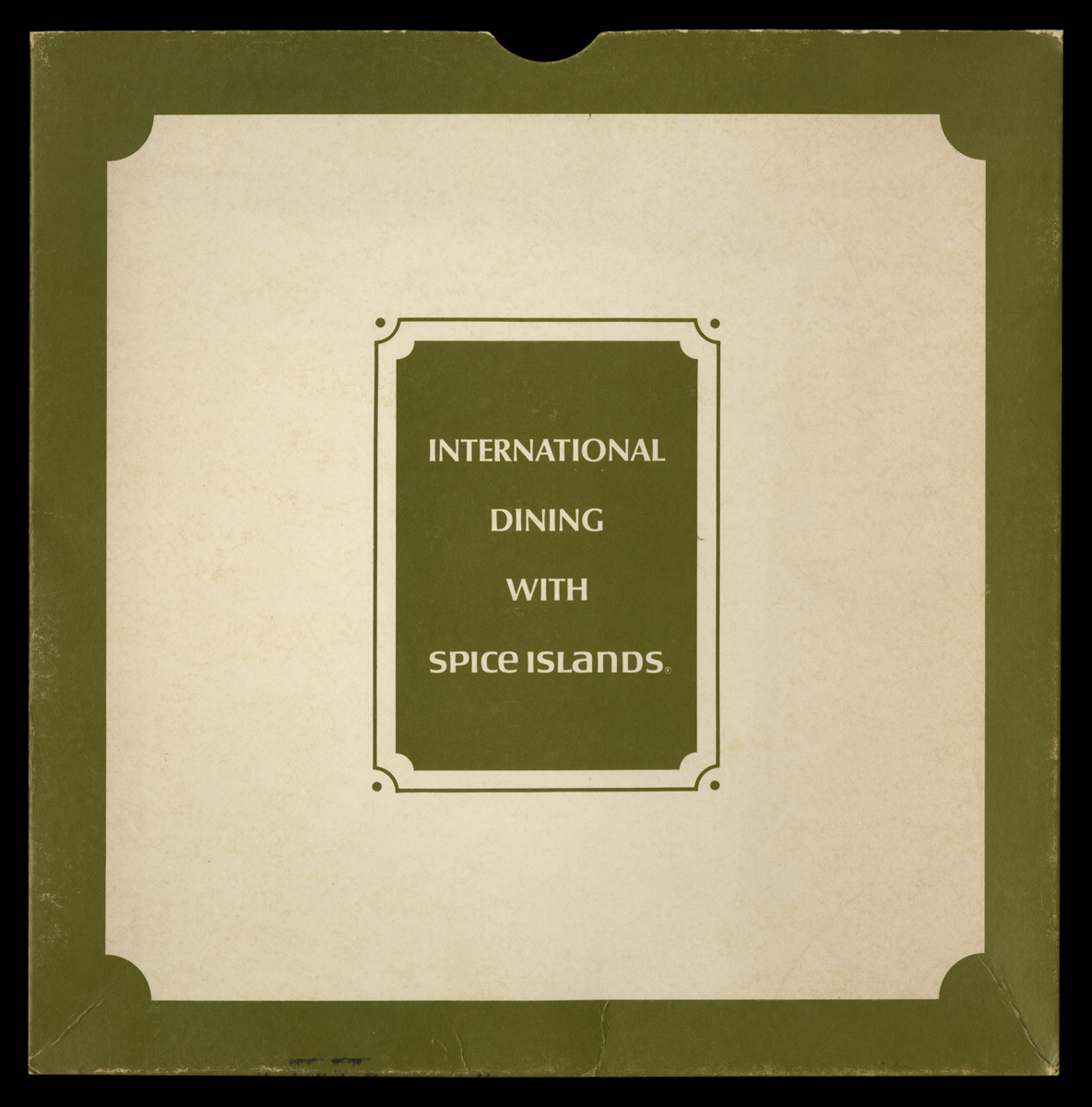
Presentation sleeve for the “International Dining with Spice Islands” recipe portfolio / THF720260

Spanish recipe booklet with art by Corita Kent from “International Dining with Spice Islands” with the proverb “Reading and eating should both be done slowly.” / THF720271
At age 18, Corita joined the Order of the Immaculate Heart of Mary in Los Angeles. From 1947-1968 she taught art at Immaculate Heart College, where she eventually became chair of the art department. This liberal arts school had a reputation for its progressive curriculum, which coincided with the shifts and reforms of Vatican II Catholicism in the 1960s. Corita was a vibrant individual whose belief in the importance of community, intentional presence in the world, and social protest through art are reflected in her teaching philosophy and own creative output. She was extremely active as an artist while teaching at IHC, exhibiting widely and receiving international attention for her bold pop art styled serigraphs (or screen prints).
Corita often referenced the visual language of food logos in her prints—famously, pairing Wonder Bread and Sunkist logo designs with fragments of scripture, song lyrics, poems, and quotes from public figures. Regarding her work for the “International Dining” publication, the Corita Art Center states, “These succinct and charming proverbs echo Corita’s use of food advertising language to playfully connote spiritual messages within her artwork.” The publication was popular enough that they were reprinted in 1967, which is the version recently acquired by The Henry Ford.
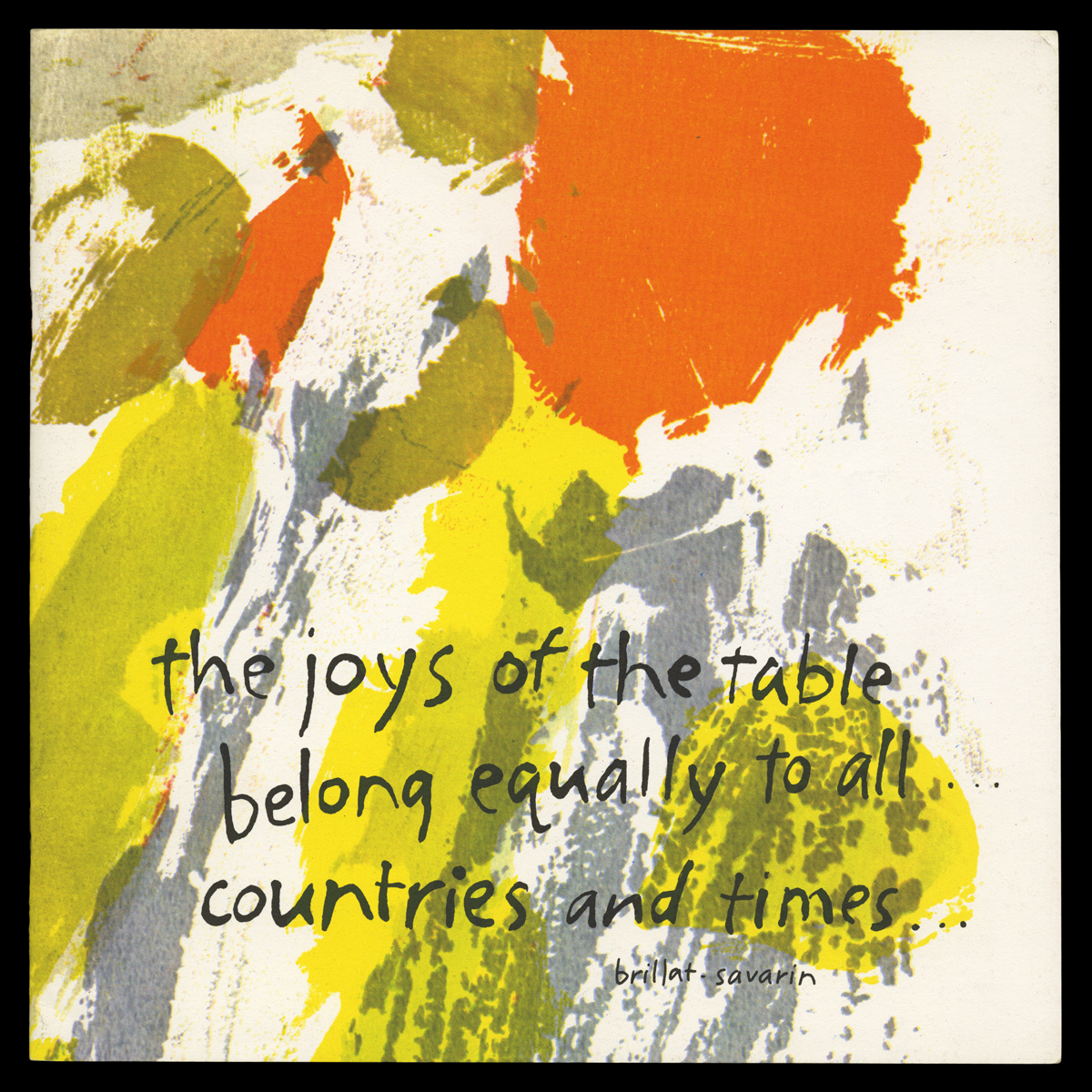
Introductory booklet with art by Corita Kent from “International Dining with Spice Islands” with a quote by Jean Anthelme Brillat-Savarin / THF720261
The cover of the introductory booklet references a quote from Jean Anthelme Brillat-Savarin, an 18th-century French lawyer and author: “The joys of the table belong equally to all ages, conditions, countries and times; they mix with all other pleasures, and remain the last to console us for their loss.” As the author of “The Physiology of Taste: Or Meditations on Transcendental Gastronomy,” Brillat-Savarin is considered one of the first essayists of the gastronomy genre. He also famously wrote “tell me what you eat, and I will tell you what you are”—the origin point for the common adage, “you are what you eat.”
The first booklet also contains a brief history of fine dining and provides instructions and etiquette for how to form an “international dining club” with adventurous diners. These clubs “…need not be a stuffy aggregation of posturing food snobs” but should be “…a congenial group of acquaintances who need hold nothing more in common that a singular interest in food.”

French recipe booklet with art by Corita Kent from “International Dining with Spice Islands” with the proverb “To invite anyone to dine implies that we charge ourselves with his happiness all the time he is under our roof.” / THF720264
Today, Spice Islands branded herbs are commonly sold in American grocery stores. The company was founded in 1941 and currently operates production facilities in Ankeny, Iowa—home to the largest American spice brands in the US. Geographically speaking, the “Spice Islands” themselves refer to the Malaku or the Moluccas—a group of Eastern Indonesian islands that became a powerhouse of spice trade with the arrival of European and Portuguese ships in the 16th century. The main spices exported from the Spice Islands were “warming spices”: nutmeg, cloves, mace, and peppercorns.
Beyond Corita’s contributions to the “International Dining” project, James R. Stitt is credited as the main art director and designer. Following his service in the US Navy and Marines, Stitt worked as a technical illustrator for Boeing before moving into the corporate advertising field in San Francisco. In the early 1960s, while working at the firm Dancer Fitzgerald Sample, he was assigned the Spice Islands account. Stitt recalled meeting Corita Kent at the ArtCenter School in Los Angeles while he was a student, and as a fan of her work, contacted her to commission illustrations for covers of the “International Dining” recipe booklets. Despite working as an illustrator in the years when digital design was on the rise, Stitt was staunchly anti-computer throughout his career. His iconic labels for the Anchor Brewing Company were entirely drawn by hand; they included 44 years of Christmas Ale labels starting in 1975 until his retirement in 2019.
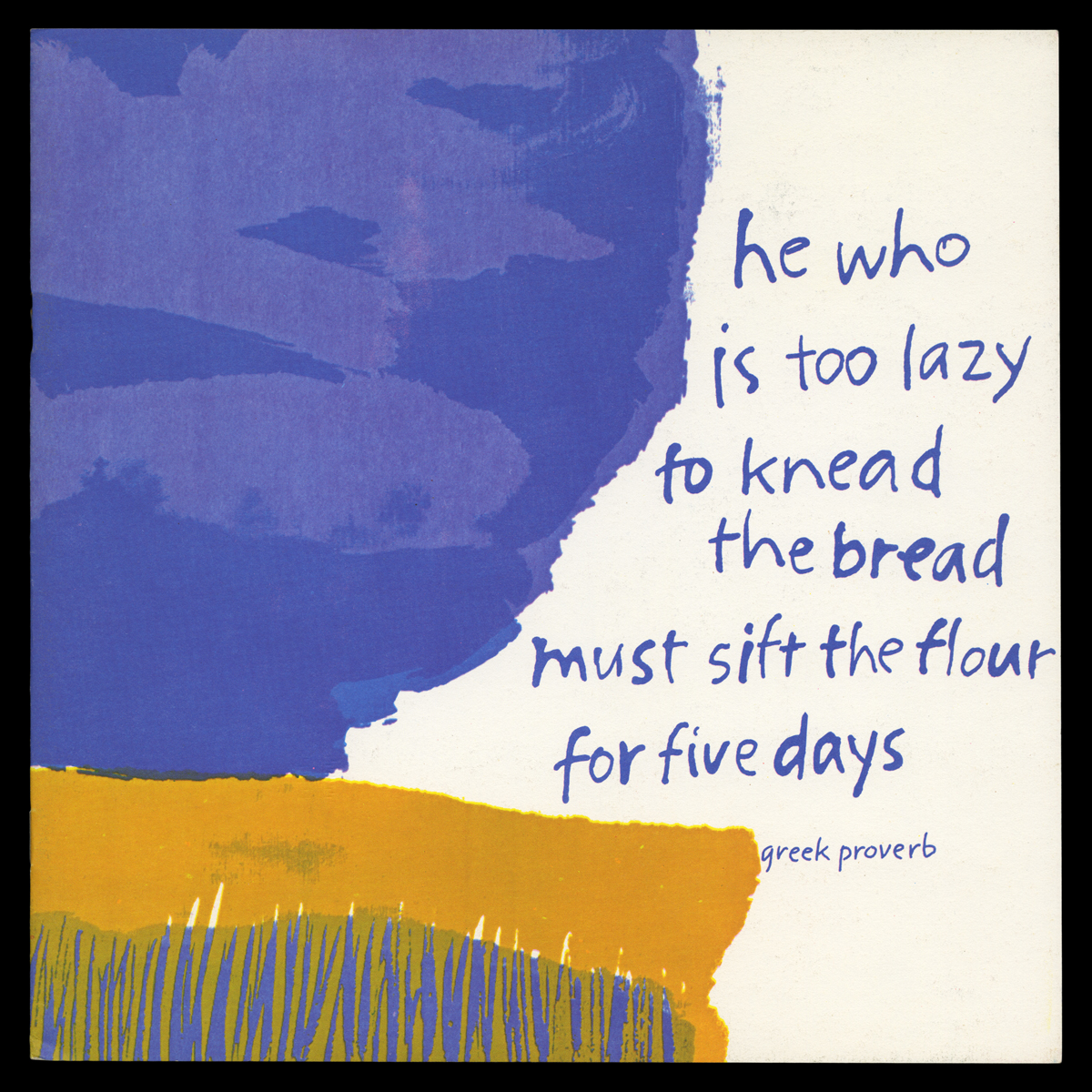
Greek recipe booklet with art by Corita Kent from “International Dining with Spice Islands” with the proverb “He who is too lazy to knead the bread must sift the flour for five days.” / THF720266
Country by country, the booklets contained within the “International Dining with Spice Islands” portfolio explain indigenous regional cuisines, shifting foodways, hospitality expectations, seasonal menus, the impacts of religious belief on food preparation and consumption, and cuisine balanced with local agricultural abundance (or scarcity). Also included are sources for seasonings not readily available in typical US retail grocery stores in the 1960s. (Michigan locations include J.L. Hudson Company in Detroit.) Chefs are urged to take seasoning seriously and to broaden their palates: “If you are not familiar with a particular herb, spice, or seasoning called for in a recipe, do not omit it. […] Broadening one’s seasoning scope is an exciting adventure in itself.”

Spanish recipe booklet with art by Corita Kent from “International Dining with Spice Islands” with the proverb “Food must feast the eyes as well as the stomach.” / THF720270

Italian recipe booklet with art by Corita Kent from “International Dining with Spice Islands” with the proverb “Thou shouldst eat to live not live to eat.” / THF720269
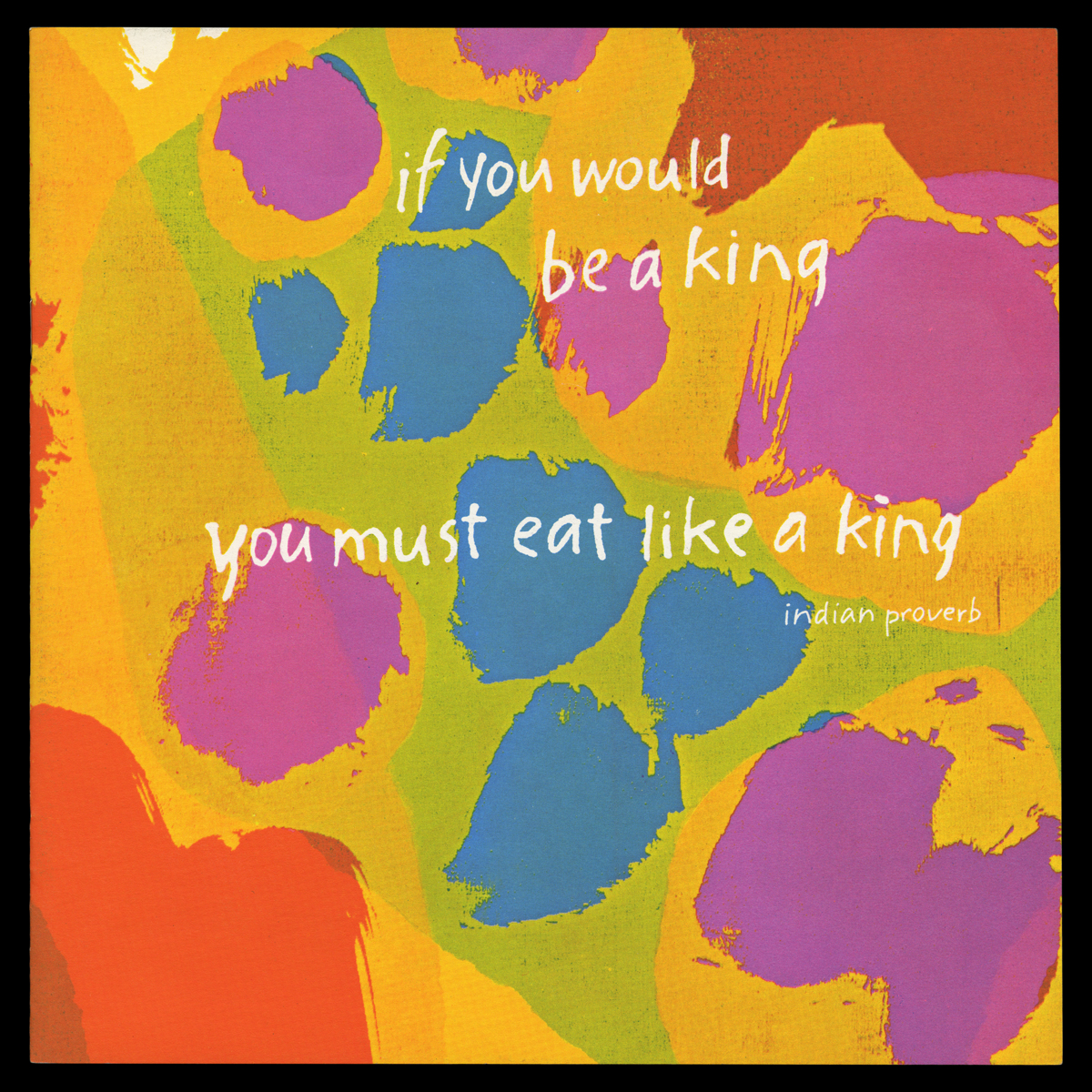
Indian recipe booklet with art by Corita Kent from “International Dining with Spice Islands” with the proverb “If you would be a king you must eat like a king.” / THF720267

German recipe booklet with art by Corita Kent from “International Dining with Spice Islands” with the proverb “He who doesn’t love wine women and song remains a fool his whole life long.” / THF720265
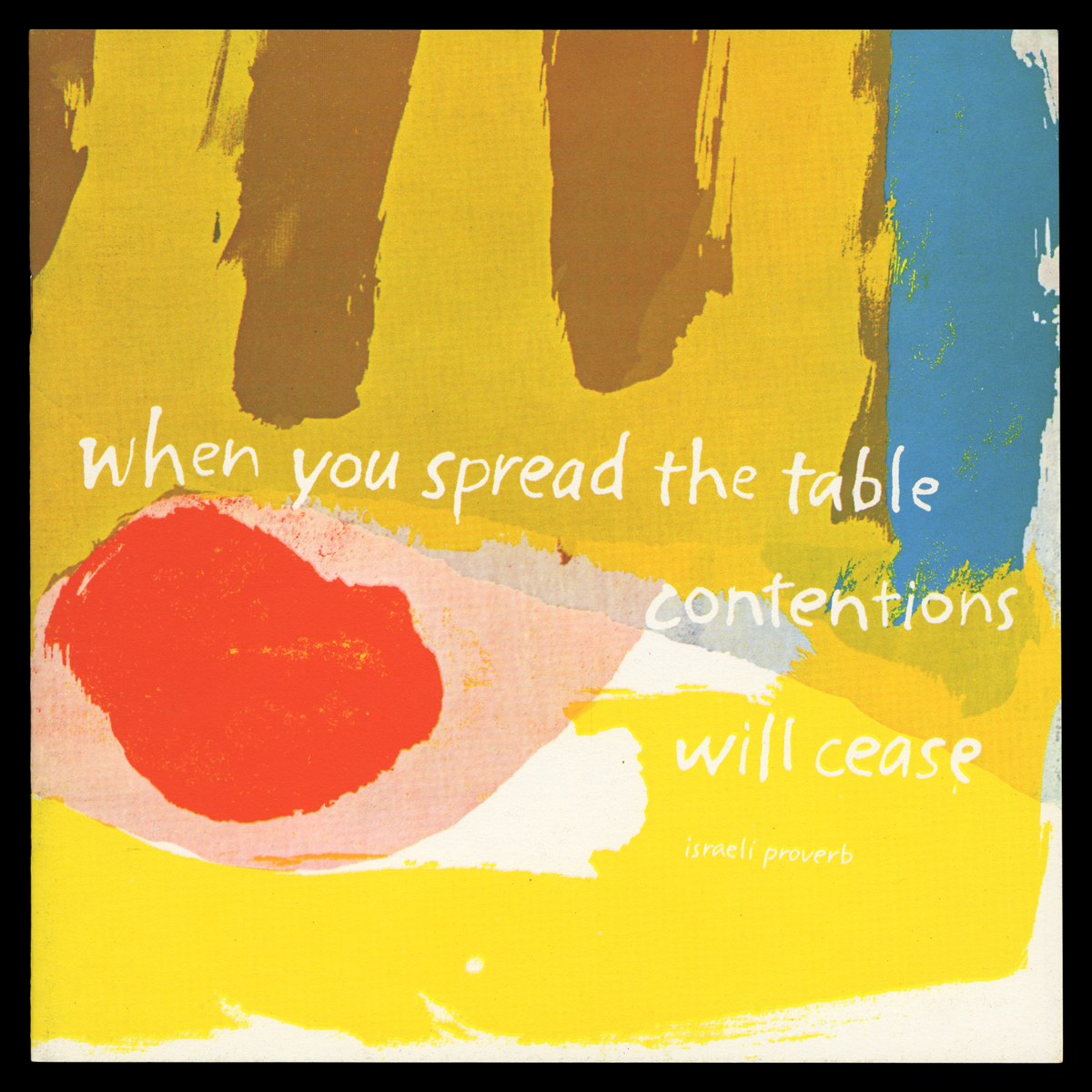
Israeli recipe booklet with art by Corita Kent from “International Dining with Spice Islands” with the proverb “When you spread the table contentions will cease.” / THF720268

Swedish recipe booklet with art by Corita Kent from “International Dining with Spice Islands” with the proverb “You take what you have.” / THF720272
Kristen Gallerneaux is curator of communications & information technology, editor-in-chief of digital curation. .
Conservation Spotlight: 19th Century Passenger Cars
If you had a chance to visit the Henry Ford Museum of American Innovation in 2024, you may have seen a few members of our conservation team working by the legendary Allegheny, on the three cars attached to the replica DeWitt Clinton locomotive. For a few months, we chatted with visitors about conservation and our preservation efforts on these artifacts. Let's look at the full process now that conservation work is complete!
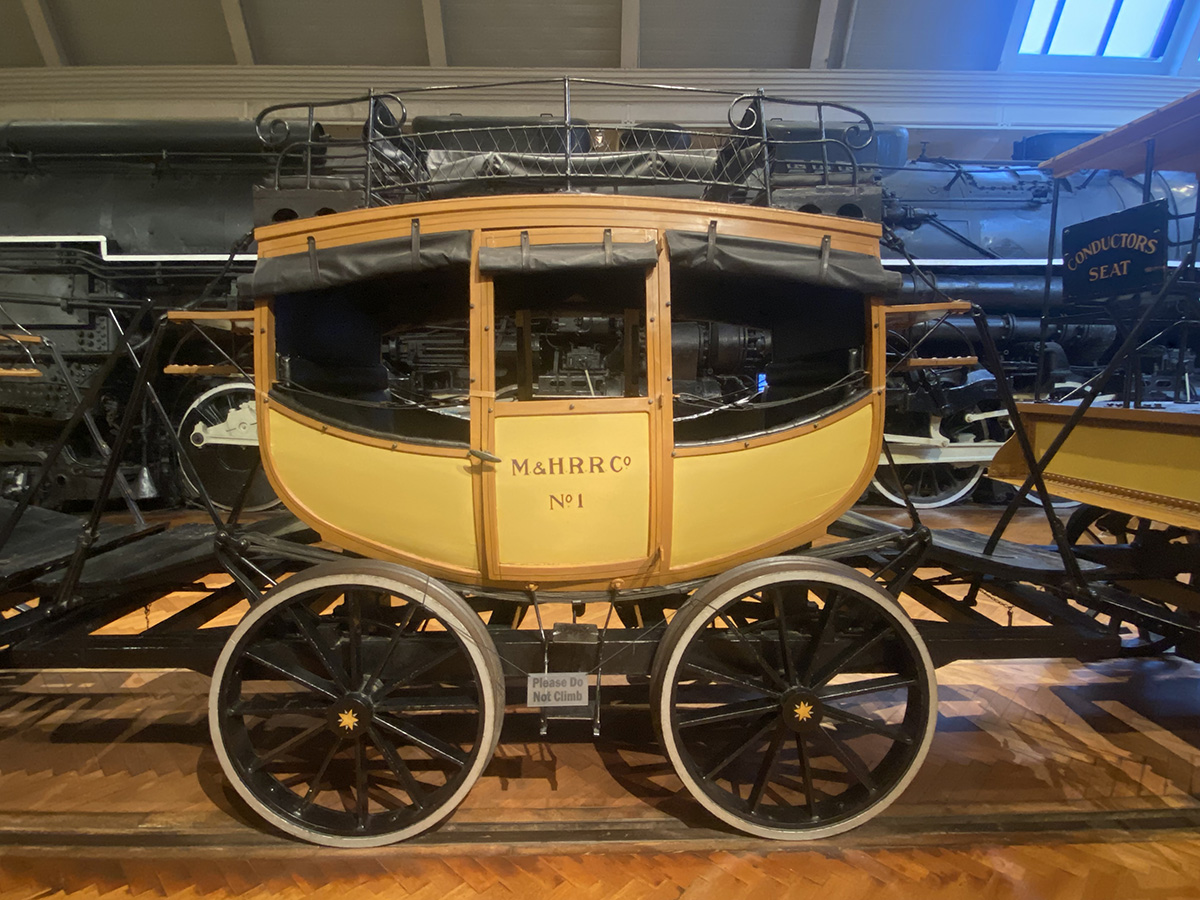
First car
Made in 1893 by the New York Central Railroad for the World’s Columbian Exhibition in Chicago and various promotional events, the locomotive and passenger cars are replicas of the 1831 DeWitt Clinton. Henry Ford acquired the replica locomotive and carriages in the 1930s, which are now displayed on railroad tracks as if ready for their next journey.
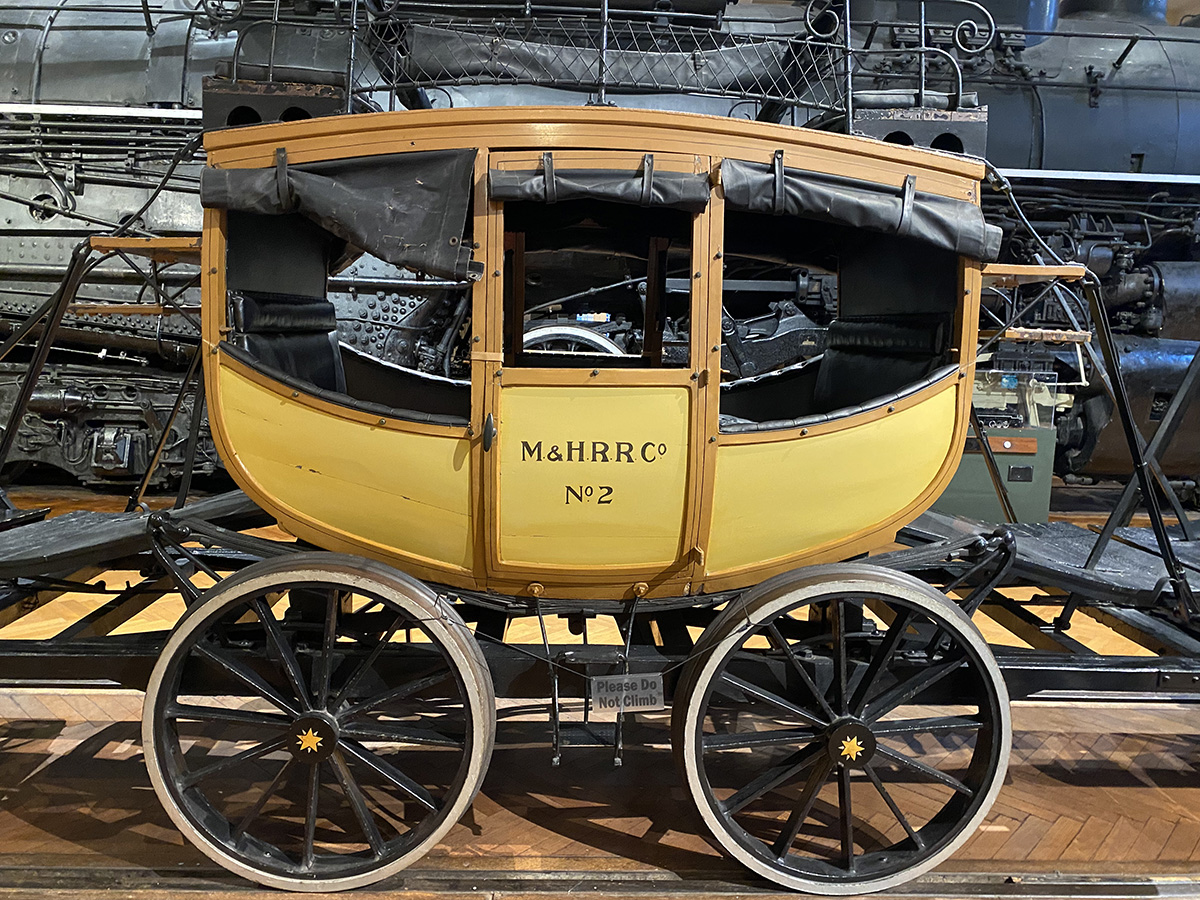
Second car
Both their days of use and time on display have contributed to the wear and tear on the locomotive and its cars. Our fabulous clean team documents changes to the artifacts to report to Conservation. For the replica DeWitt Clinton passenger cars, the clean team noticed broken leather straps, lost paint, torn leather cushions, and a missing seat cushion.
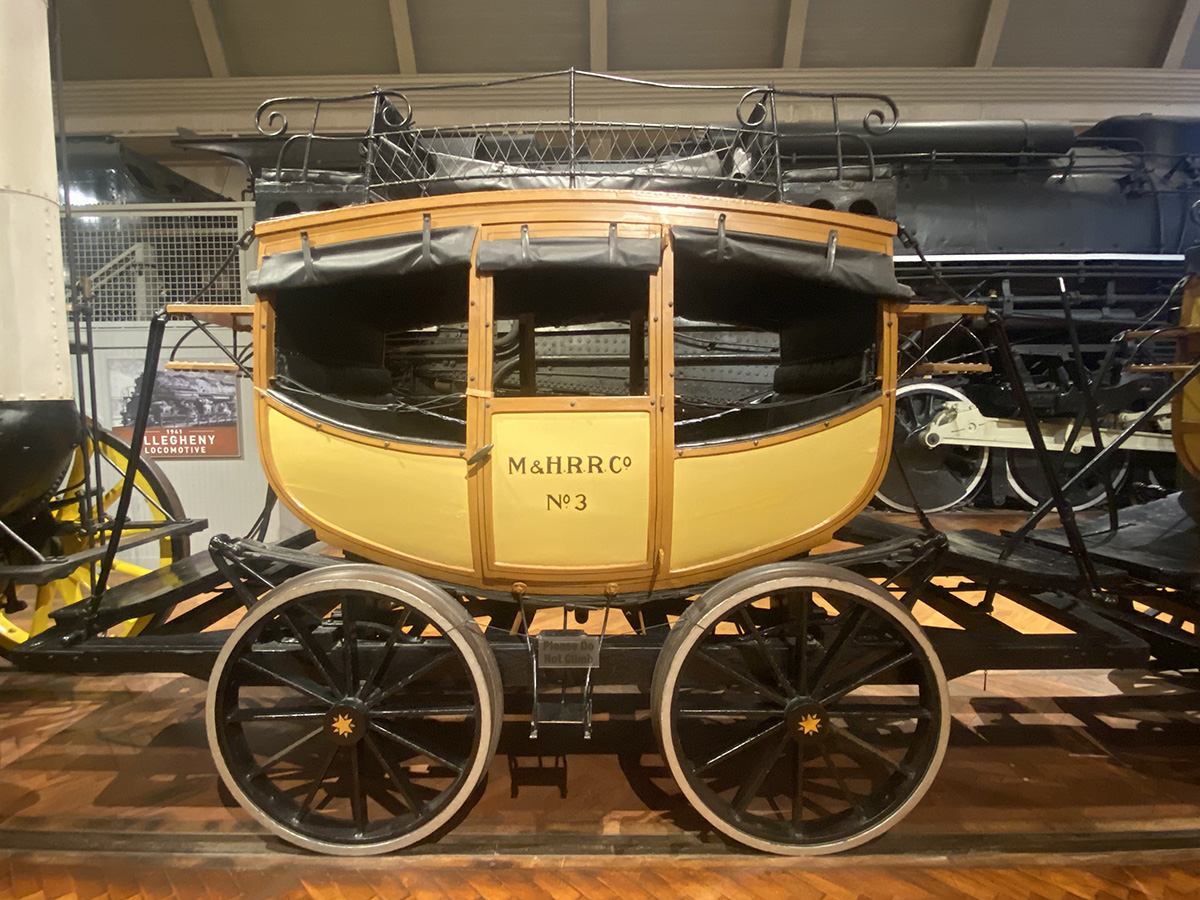
Third car
This year, we made it a priority to give the cars conservation attention. Since these are large artifacts, instead of moving them to the conservation lab, cleaning and repairs were done on the museum floor.
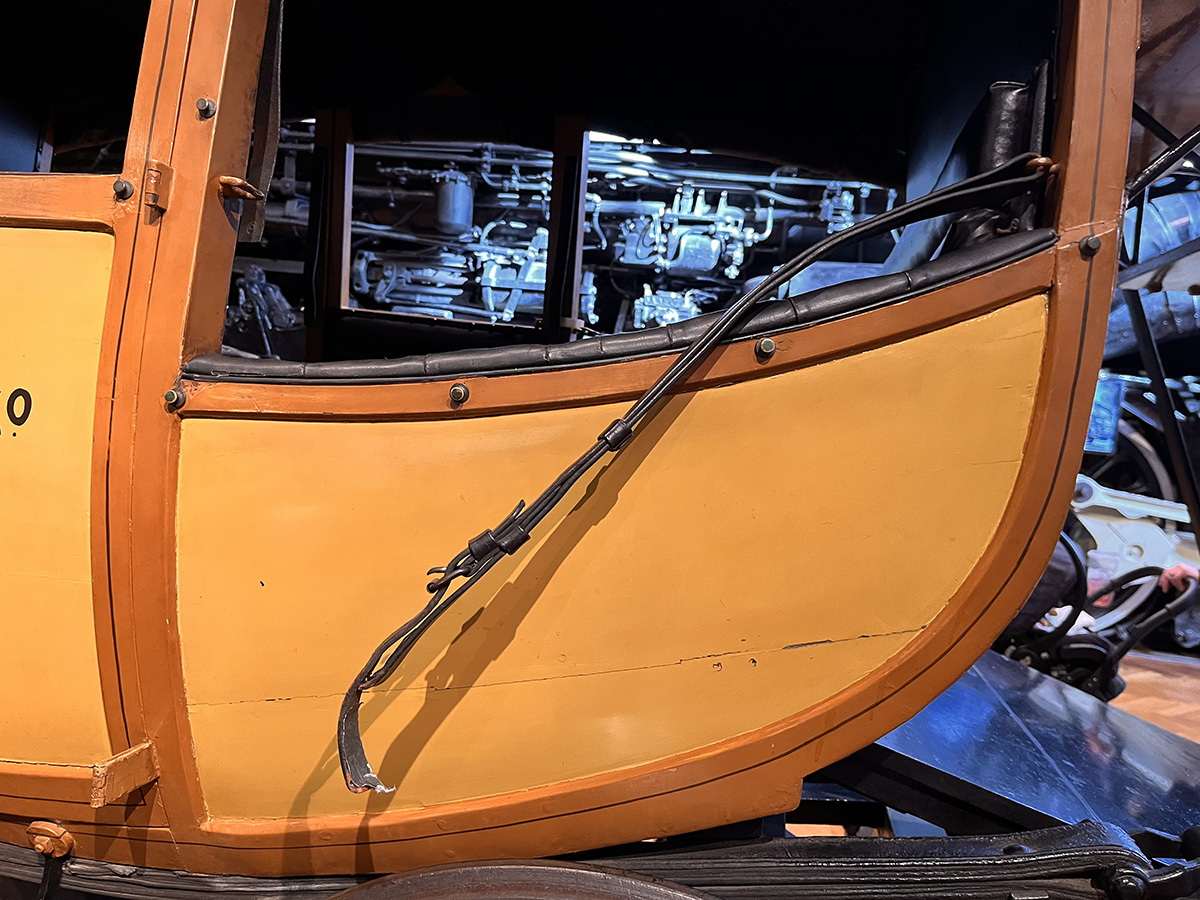
Broken leather strap on one of the cars
First, broken and brittle leather belt straps in the windows of each car were removed for replication by a local leather worker. The straps were measured and fabricated to match the full length and appearance of the original straps in completed form. The original metal buckles were saved to fit the straps back to the windows.

Surface grime on car exteriors visible around the lettering
The exteriors of the cars were cleaned to remove surface grime and expose the richness of the bright mustard and reddish-brown paints. At this stage, it allows us to see other issues that we may have missed upon the first examination. Not only were paint losses visible on the surface, but losses in the wood frame were found on the rear car.
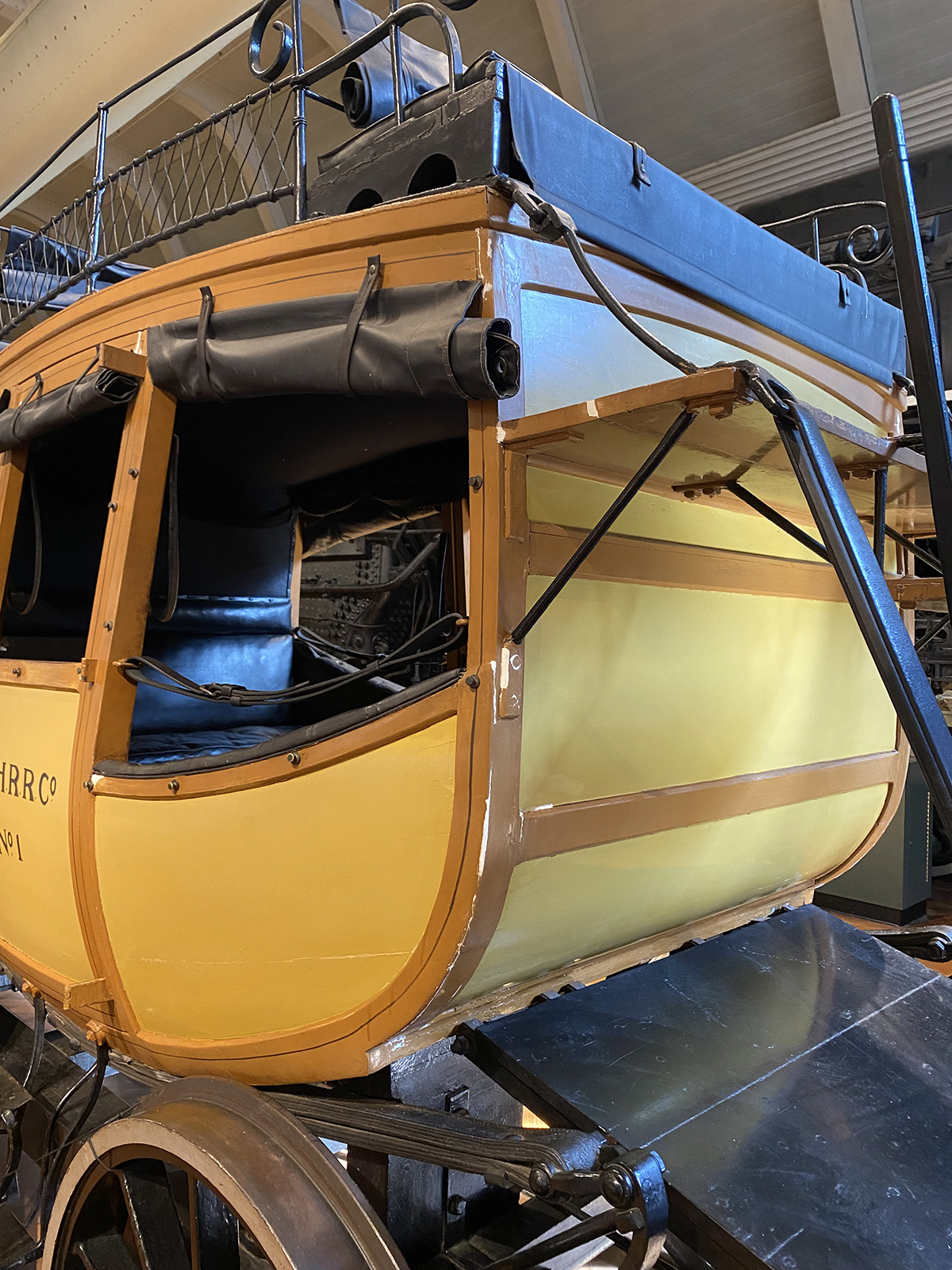
Filled losses with gesso to create even layer before painting
The unstable paint was carefully adhered back in place and large losses filled with gesso or wood putty before painting to match the rest of the car.
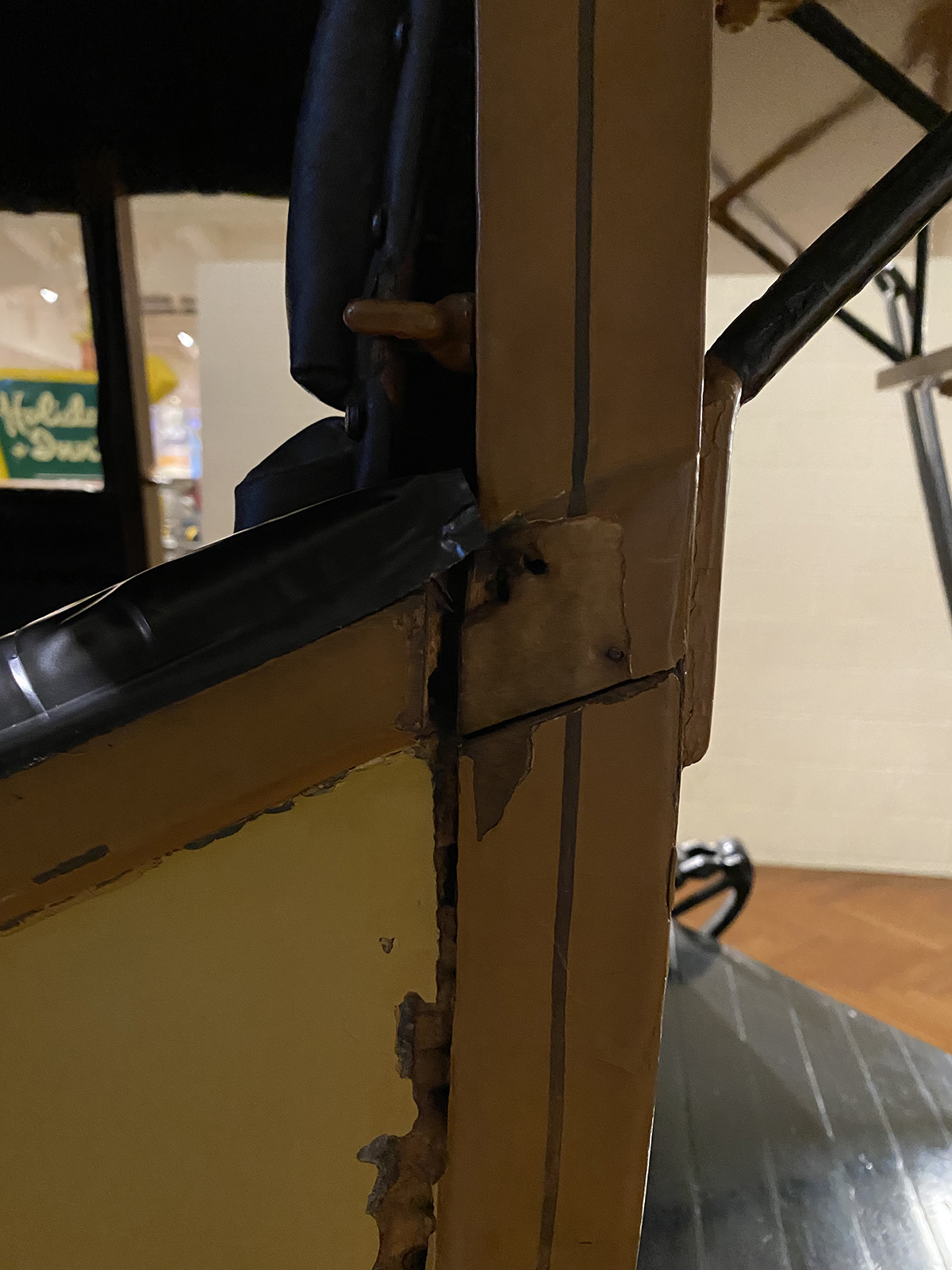
Wood putty fill in center
Pinstripes and lettering on the car doors were also touched up. If there was structural damage, strong wood putty was used, otherwise the gesso was used for shallow fills.
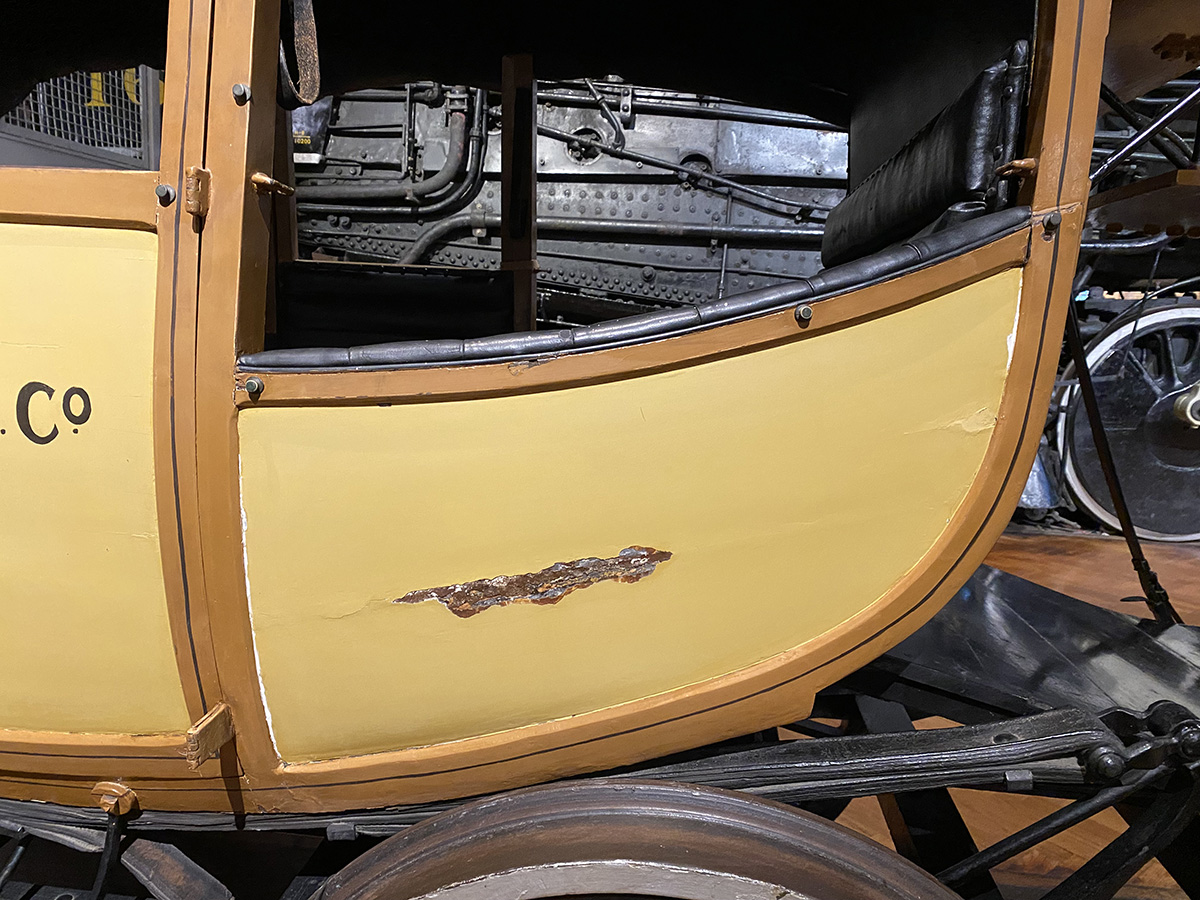
Large paint loss on side panel
Otherwise, after concocting just the right proportions of pigments, wax fills were chosen to provide good color match for shallow surface damages. Smaller losses were filled with the pigmented waxes applied vertically using a warm tacking iron, mindful not to drip wax everywhere!
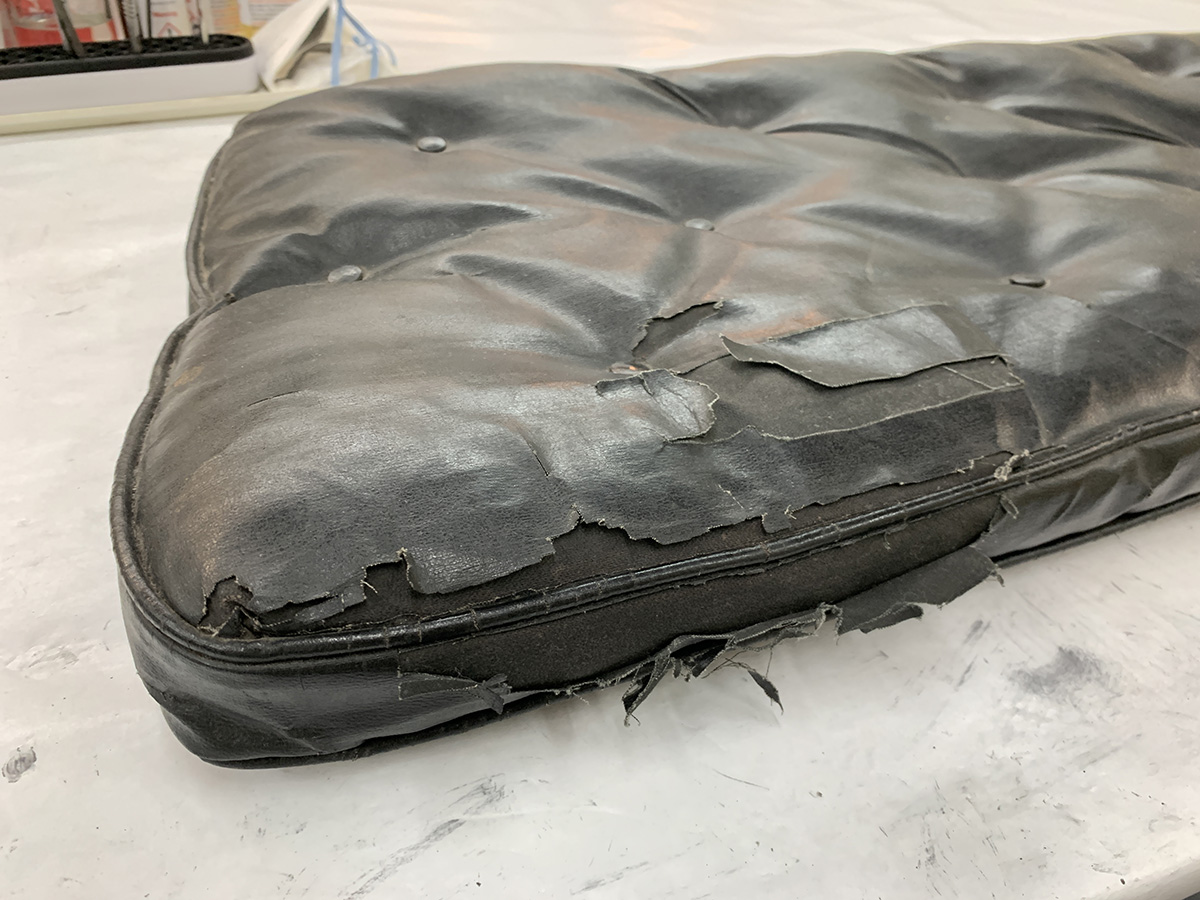
Torn leather on cushion
Tufted seat cushions with torn leather were removed from the cars and taken to the conservation lab. The tears were mended with adhesive film activated by heat. Any gaps in the lost leather were filled with pigmented wax. The buttons were re-secured where necessary with stronger twine.
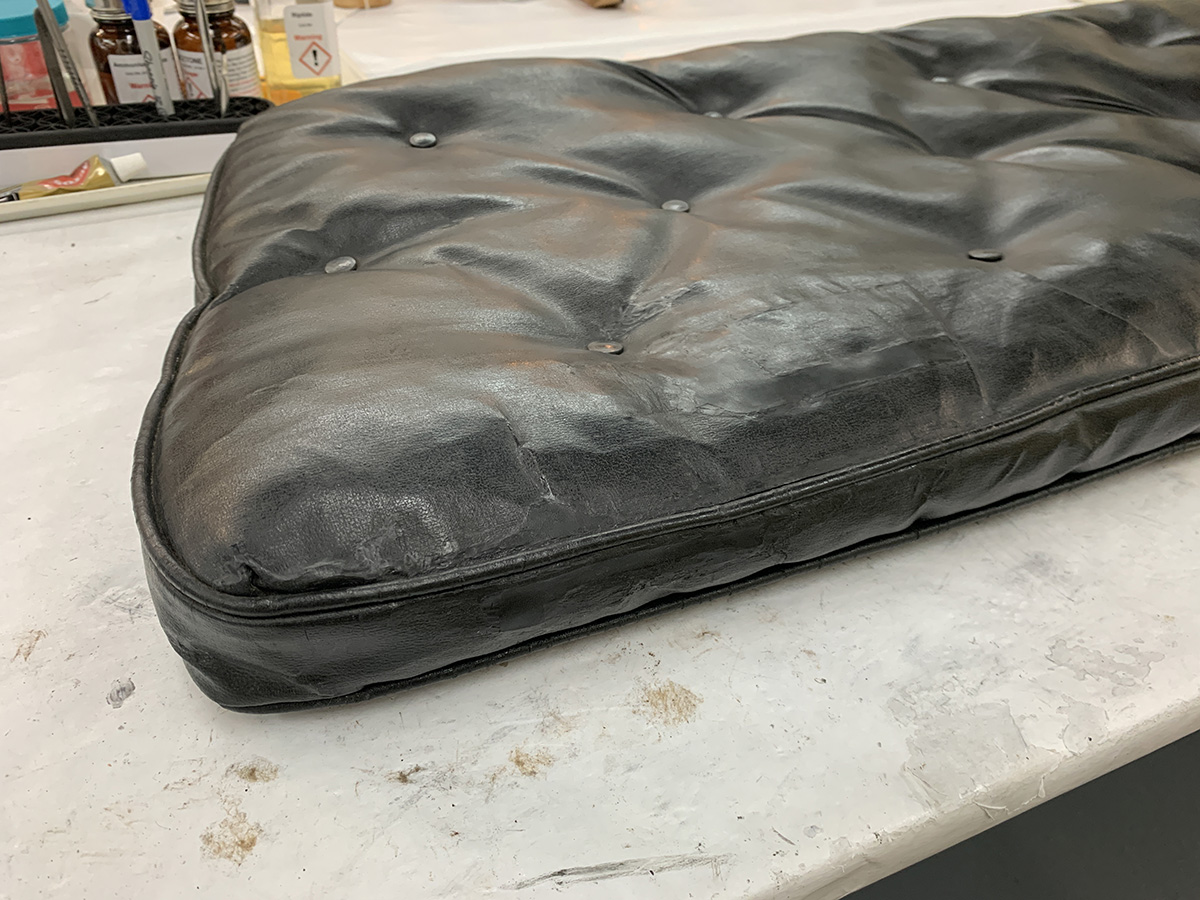
Cushion after stabilization
The missing seat cushion on one of the cars was recreated by a local car upholsterer. See if you can spot the new one! We make sure new materials added to artifacts are documented in condition and treatment reports for future conservators to know what is original versus a replication.
Each car's leather armrests had been previously repaired with tape strips to cover lost material or insecure leather. Over time the tape started to peel away, drawing more attention to these damaged areas.
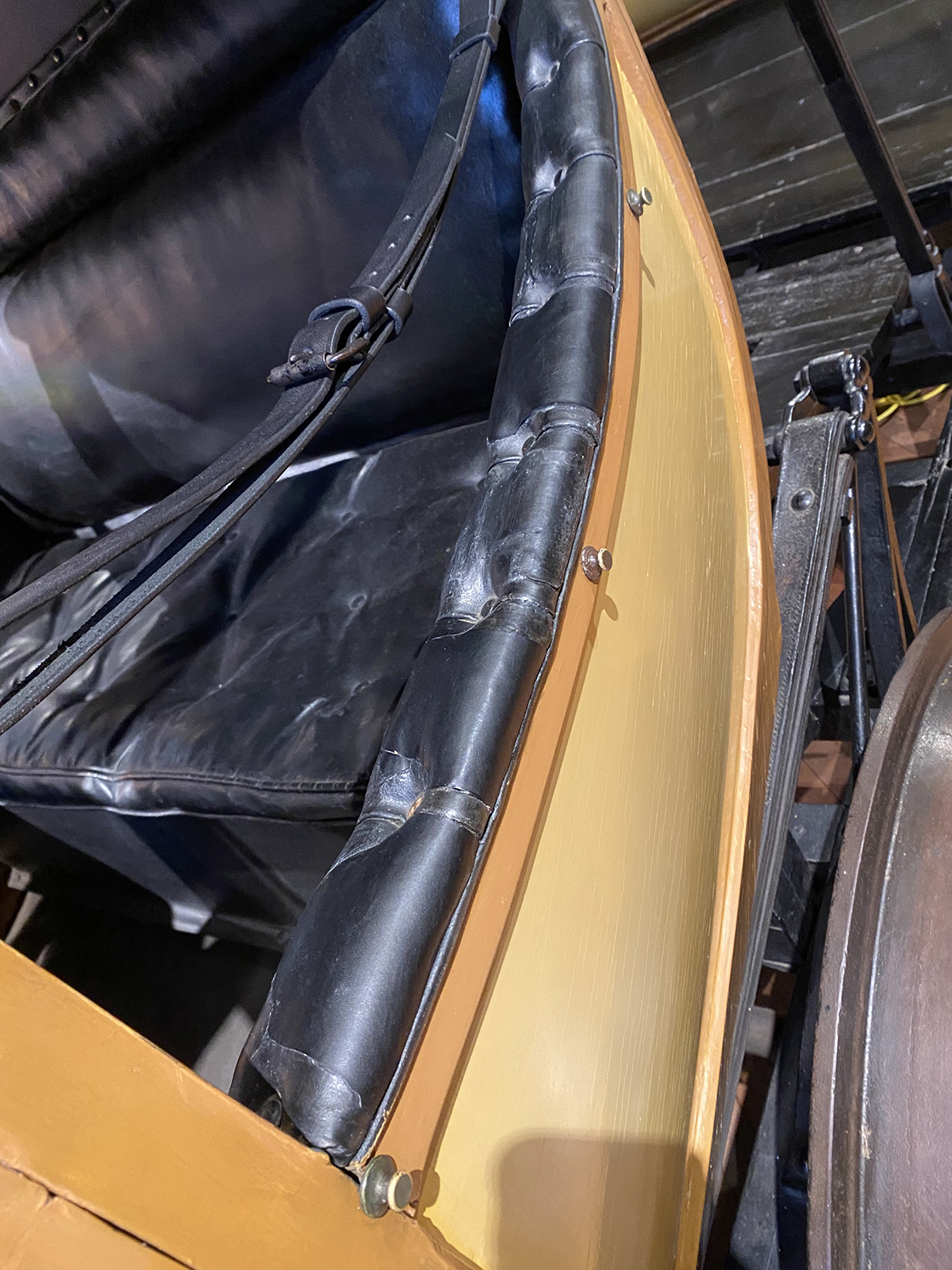
Adding leather tape patches to losses on armrests
We removed the old tape and adhesive before attaching leather tape patches cut for specific loss areas instead of covering the entire armrest.
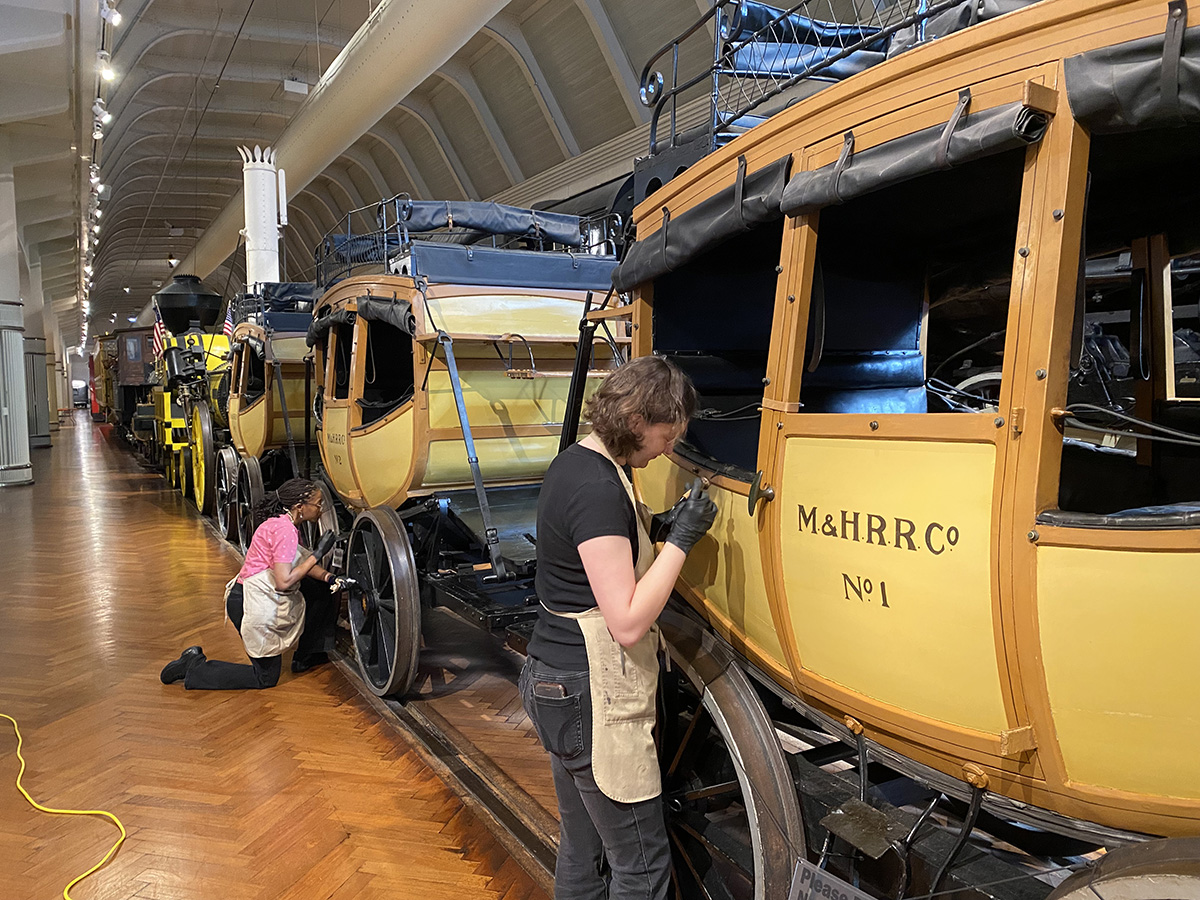
Applying wax to small losses on armrests
As seen with the seat cushions, pigmented wax was applied to the gaps between the original leather and the new patches to create as seamless a finish as possible while securing the edges of the tape to the armrests.
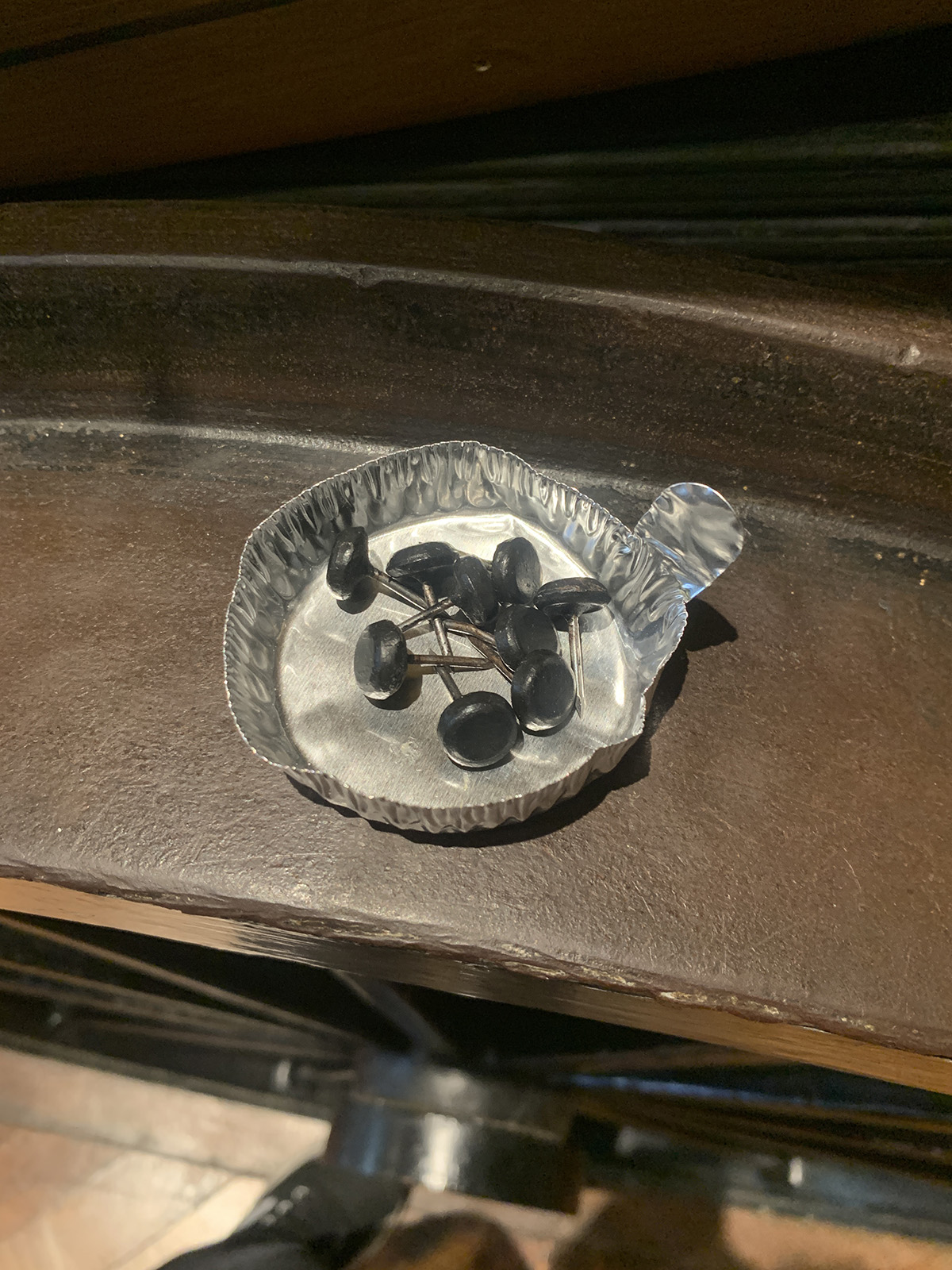
3D-printed tacks ready for attachment
Final additions involved replicating lost tacks around the window shades and interior leather panels of each car. Example tacks were scanned to create digital models for 3D printing. Close to 100 printed tack models were then painted to look like corroded metal or leather covers for the tack heads and secured with adhesive. Once the last tack was attached, our rejuvenating treatment was complete!
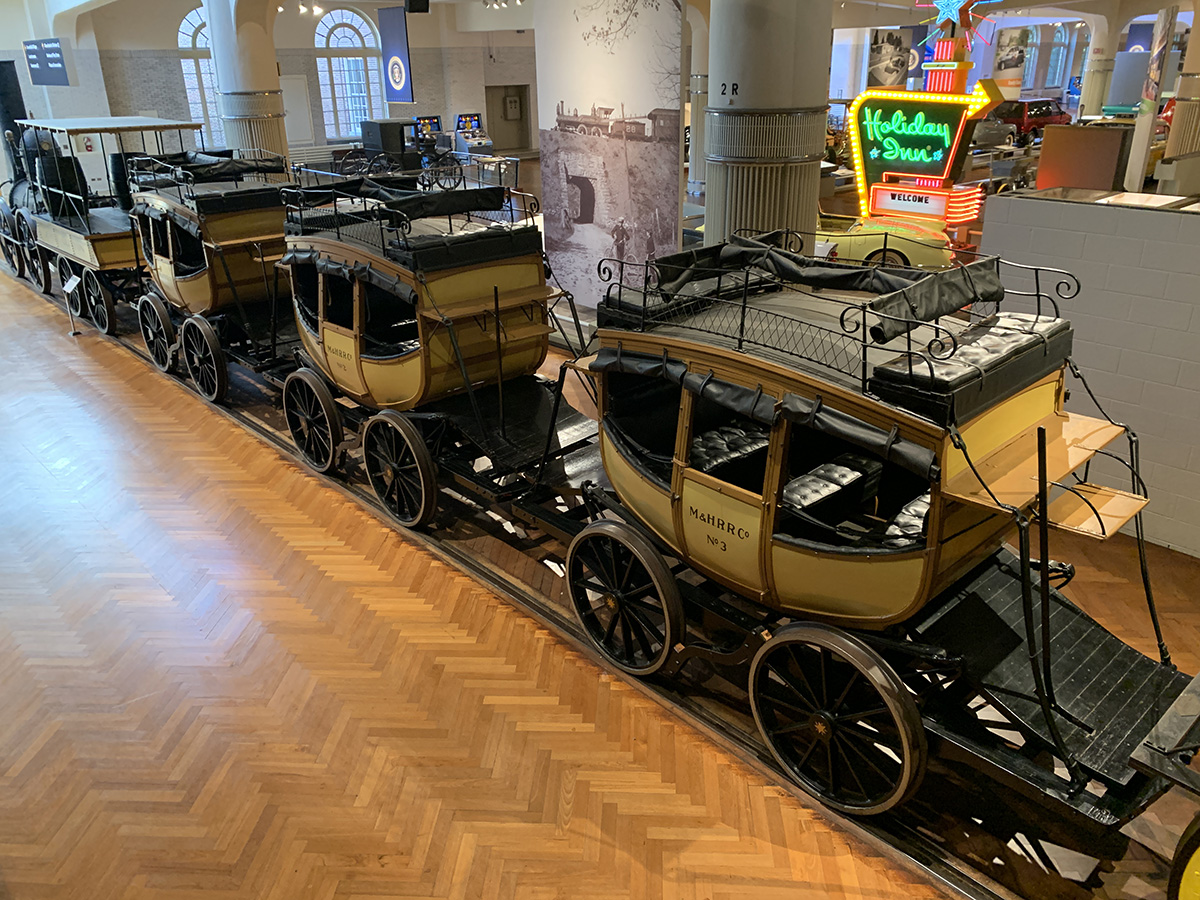
View of all three cars from the Allegheny
We heard many visitors standing in awe of the replica DeWitt Clinton and what must have been quite the experience of riding these passenger cars long ago. This behind-the-scenes look at what it takes to preserve some of the larger items in our collection gives a taste of the detailed work our conservation team does every day to continue the legacy of these historical artifacts.
Marlene Gray is a senior conservator at The Henry Ford. Huge thanks to conservation specialists Fatima Sow, Julia Fahling, Scott Powers, and senior conservator Cuong Ngyuen for their work on the passenger cars.
Snowshoes: 2024 IMLS Feature
As we come to the end of our 2022-2024 IMLS (Institute of Museum and Library Services) grant project, the Conservation staff are showcasing standout objects recently treated. During the two-year project we have conserved and relocated 2,106 objects, and created fully digital catalog records for 815 of these. The following blog highlights the snowshoes that made their way through this grant, now made accessible to the public via The Henry Ford’s Digital Collections.
Snowshoes have a long history in North America. Indigenous peoples invented the form using thin strips of collagenous material (sinew or treated hide) and bent wood. The woven strips created a netting used for walking on snow. In fact, using snowshoes helped Indigenous peoples in snowy areas thrive during wintertime. The shoes facilitated trade, hunting, trapping, and self-defense. You can read more about the advantages of Indigenous snowshoe knowledge in Thomas M. Wickman’s book, Snowshoe Country: An Environmental and Cultural History of Winter in the Early American Northeast (2018).
Wickman focuses on the Wabanaki, including Mi’kmaq, Maliseet, Passamaquoddy, and Penobscot peoples, in northern New England. The Wabanaki held advantage in the area during the 1600s, but by the early 1700s, British colonizers co-opted Indigenous tactics, including snowshoes, and launched winter offensives with the goal of eliminating their Indigenous opponents. Snowshoes then became a tool that British colonizers used for daily winter transport.
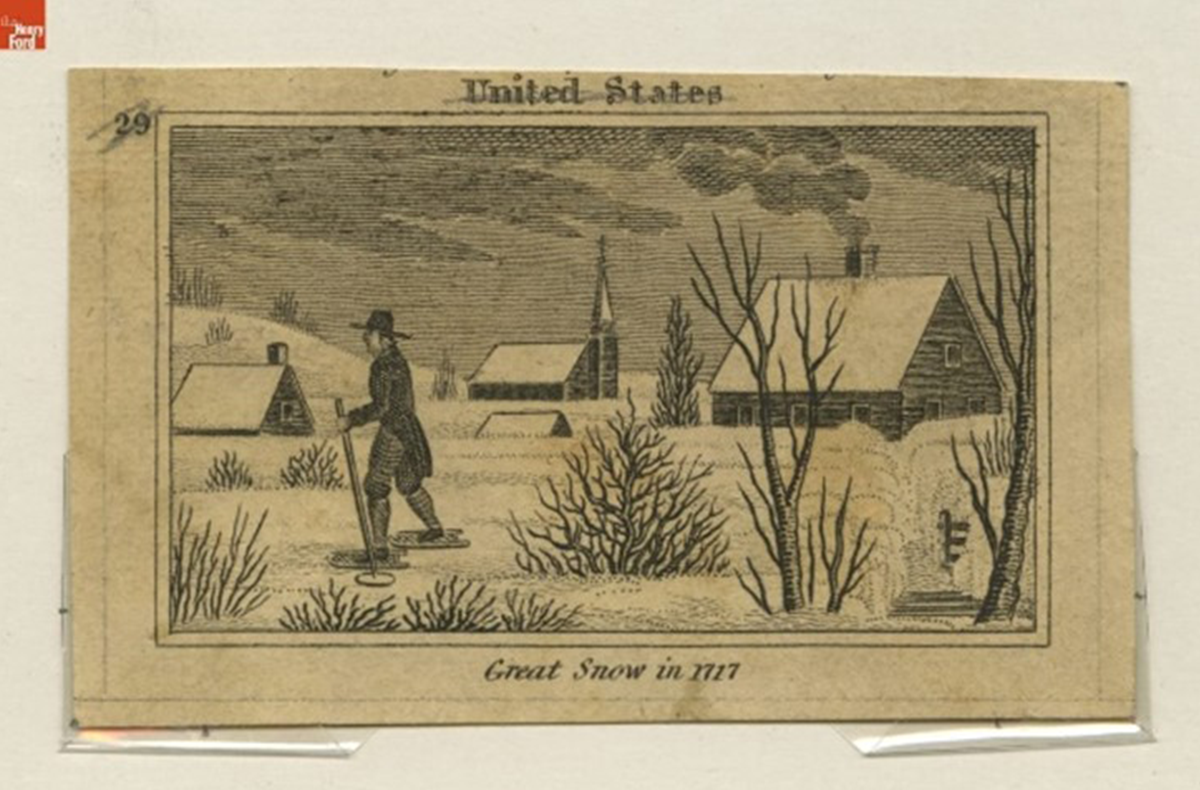
Copperplate engraving made around 1820, "Great Snow in 1717" / THF118620
A description of the “Great Snow Storm” of 1717, included in Historical Scenes in the United States (1827), described the snow as being so deep that “people stepped out of their chamber-windows on snow shoes.” The author, John W. Barber, mentions consequences of the 1717 snow, a “terrible tempest” that trapped New Englanders in upward of 15 feet of snow accumulated over several storms in late February and early March. The rather bucolic illustration does not convey the tragedy of the weather event. The 1891 book Historic Storms of New England does a better job. Author Sidney Perley puts the storm into context in his chapter, “The Winter of 1716-1717,” including the loss of livestock and humans. He also provides detail about those colonists who donned snowshoes, including mail carriers and residents who relied on the shoes to tend to livestock or assist neighbors, and sometimes to visit sweethearts.
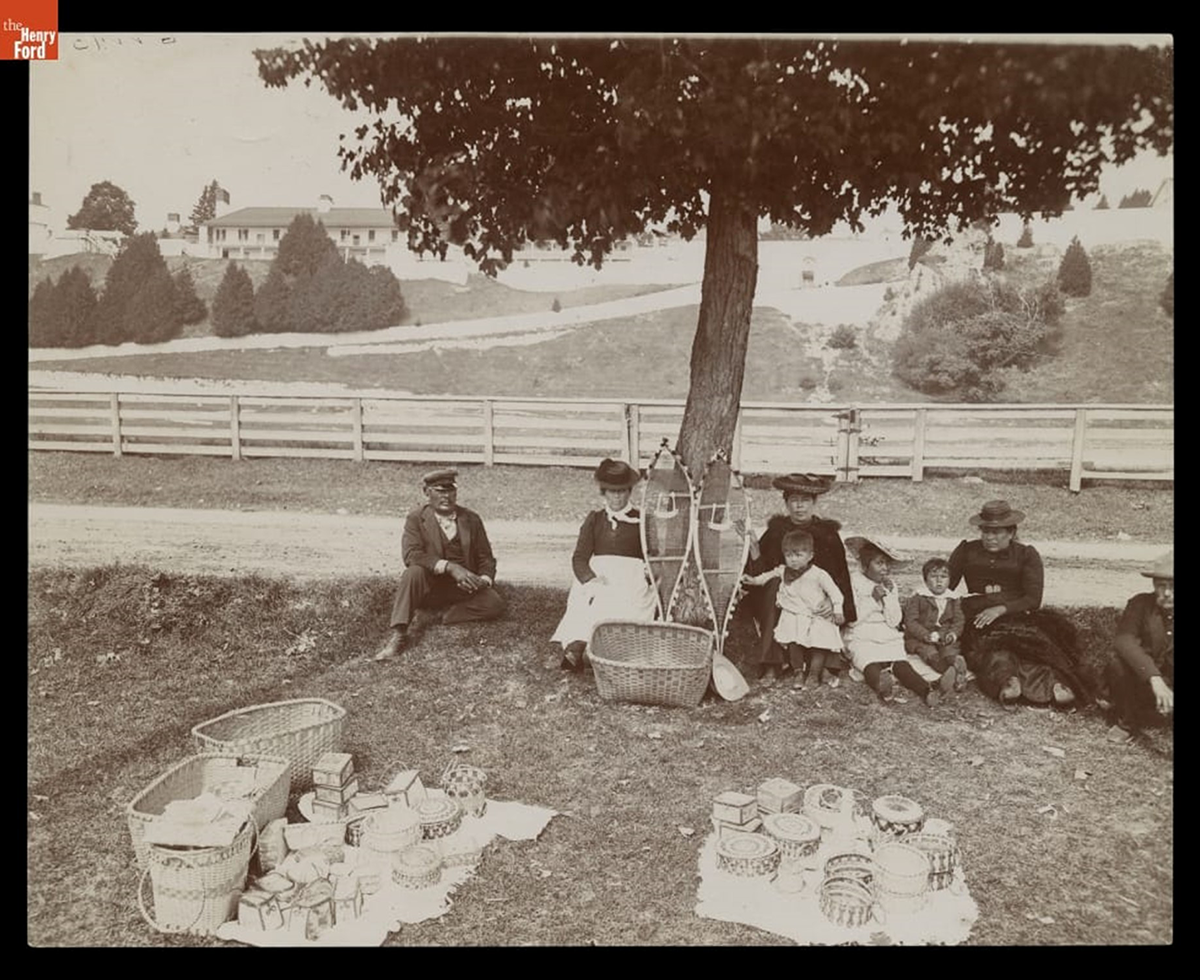
Native American Basket Market, Ojibwa Tribe, Mackinac Island, Michigan, September 1904 / THF118996
Indigenous knowledge remained essential to snowshoe construction. A photograph shows Ojibwa people selling baskets, and in the background, a pair of snowshoes leaning against a tree. The snowshoes treated during the IMLS grant project lack the decorative tufts of either dyed moose hair or wool visible on the Ojibwa snowshoes, but the intact webbing, carefully conserved, still indicates the craftsmanship evident in each shoe.
Some of the snowshoes in The Henry Ford’s collections still have their leather ankle loops and toe thongs intact. These details secured the toe to the shoe, leaving the heel free to lift the shoe and step forward with each stride.
The following images show the work of conservation, and the photography that was used to document our process. We are pleased to be able to share these remarkable artifacts via THF’s Digital Collections.
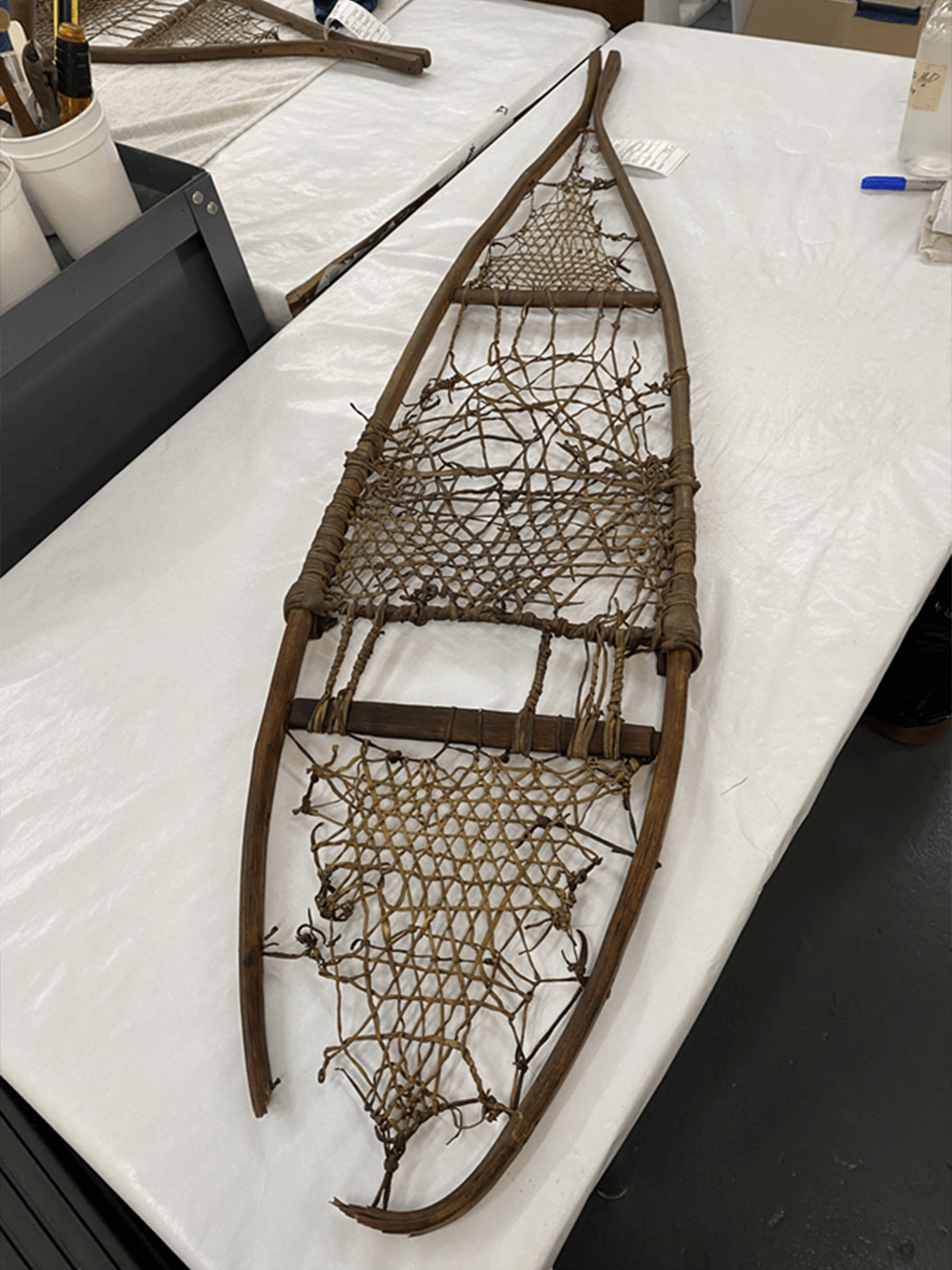
One shoe of a pair of snowshoes needed stabilization before proper handling. A section of the wood frame was missing, leaving sharp pieces of wood sticking out. The dowels keeping the tail together had split, causing more tension on the weakened rawhide webbing. / Images by Jeeeun Sims (Jee Eun Lim)

The tail was stabilized with painted wooden dowels inserted between the gaps that were secured with wood glue. The large loss to the wood frame was filled with a wood putty that was levelled, scored with a dental pick to create the wood grain, and painted to match the rest of the wood. / Images by Jeeeun Sims (Jee Eun Lim)
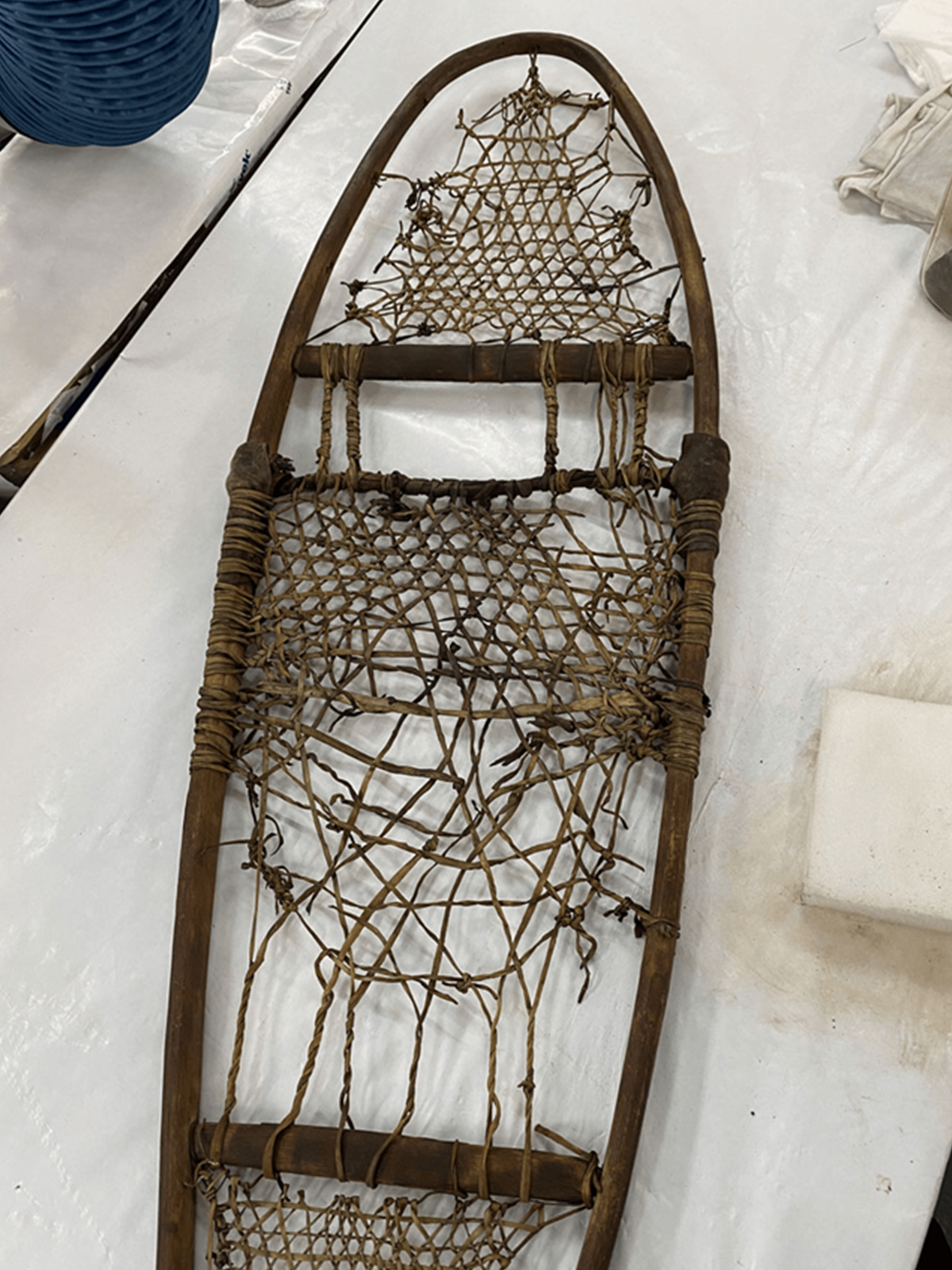
The rawhide was then cleaned with a mild detergent and distilled water with a stiff brush to remove as much dirt as possible. The rawhide webbing is rather sturdy, even where it had detached from the wooden frame, and was not in need of reattachment at this time. / Images by Jeeeun Sims (Jee Eun Lim)
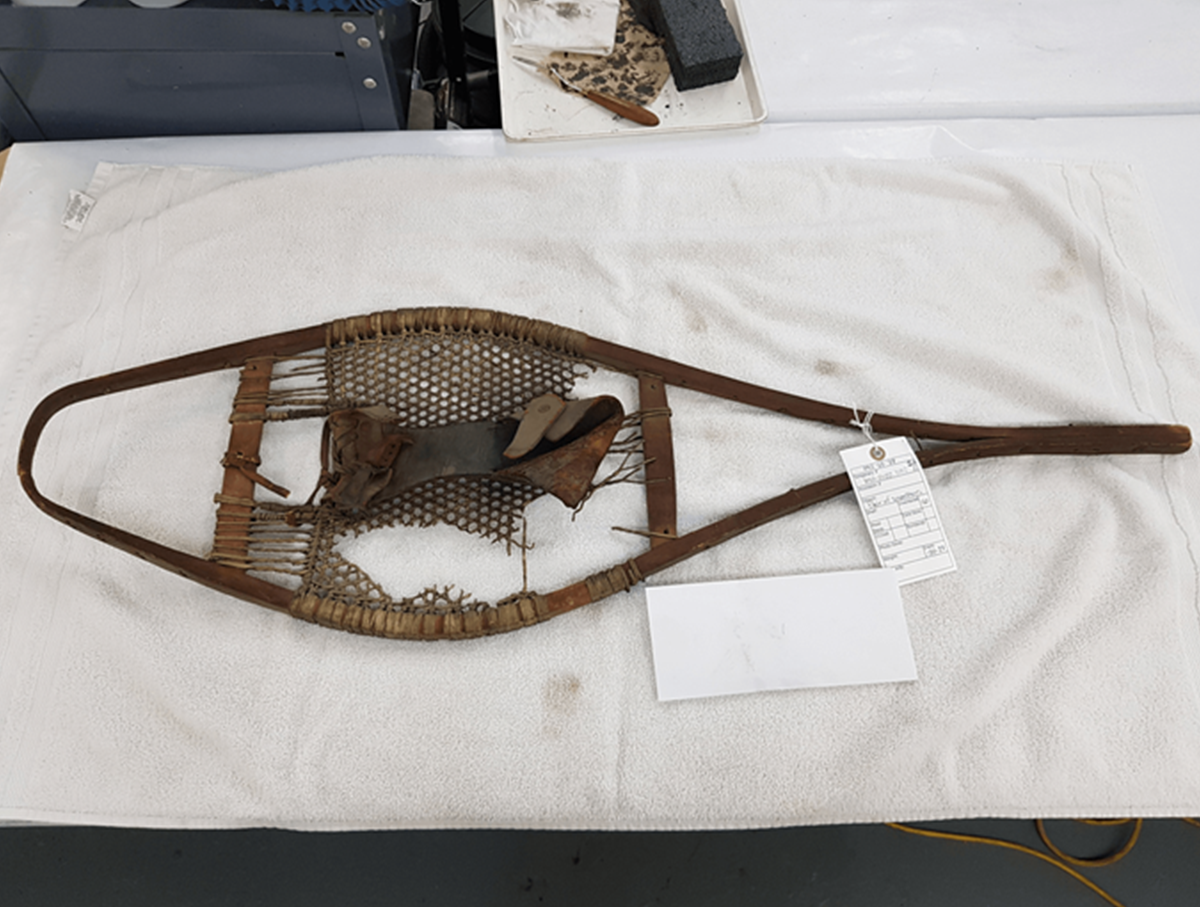
Another pair of snowshoes in a different shape from the previous pair has leather shoe holders attached to the mesh component made of rawhide. One-fourth of the mesh is missing, while the rest of the mesh was stained by dirt and dust. The overall surface of the leather was fragile, cracked, missing, and broken in some areas. A leather strap to hold the toes was split and separated from the object. / Images by Jeeeun Sims (Jee Eun Lim)
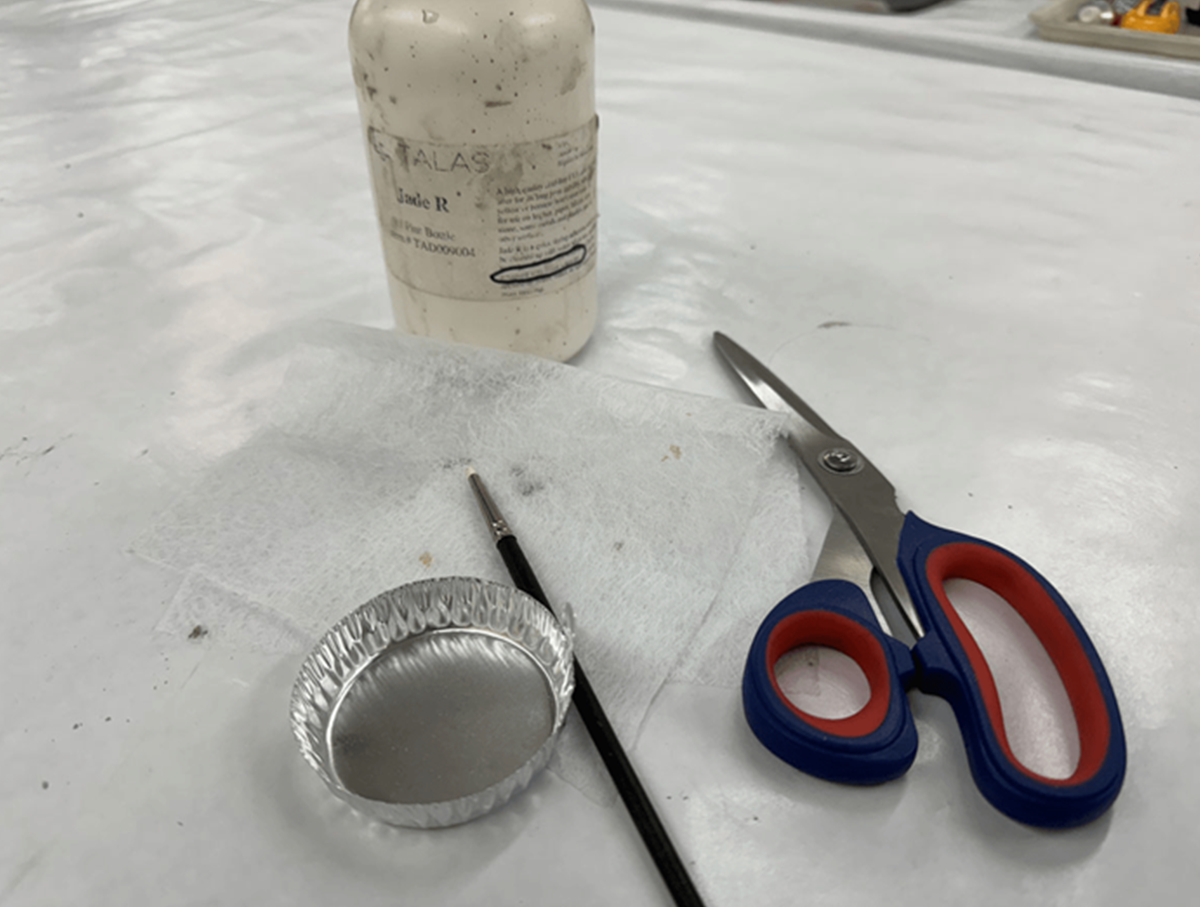
The leather was consolidated with Jade R adhesive and Japanese tissue attached to the reverse side of broken leather areas after cleaning with distilled water. The split leather strap was also reattached in the original position by the same restoration method. The restored areas by Japanese tissue were painted to match the rest of the leather. The rawhide was cleaned with the same method as described with the previous snowshoes. / Images by Jeeeun Sims (Jee Eun Lim)
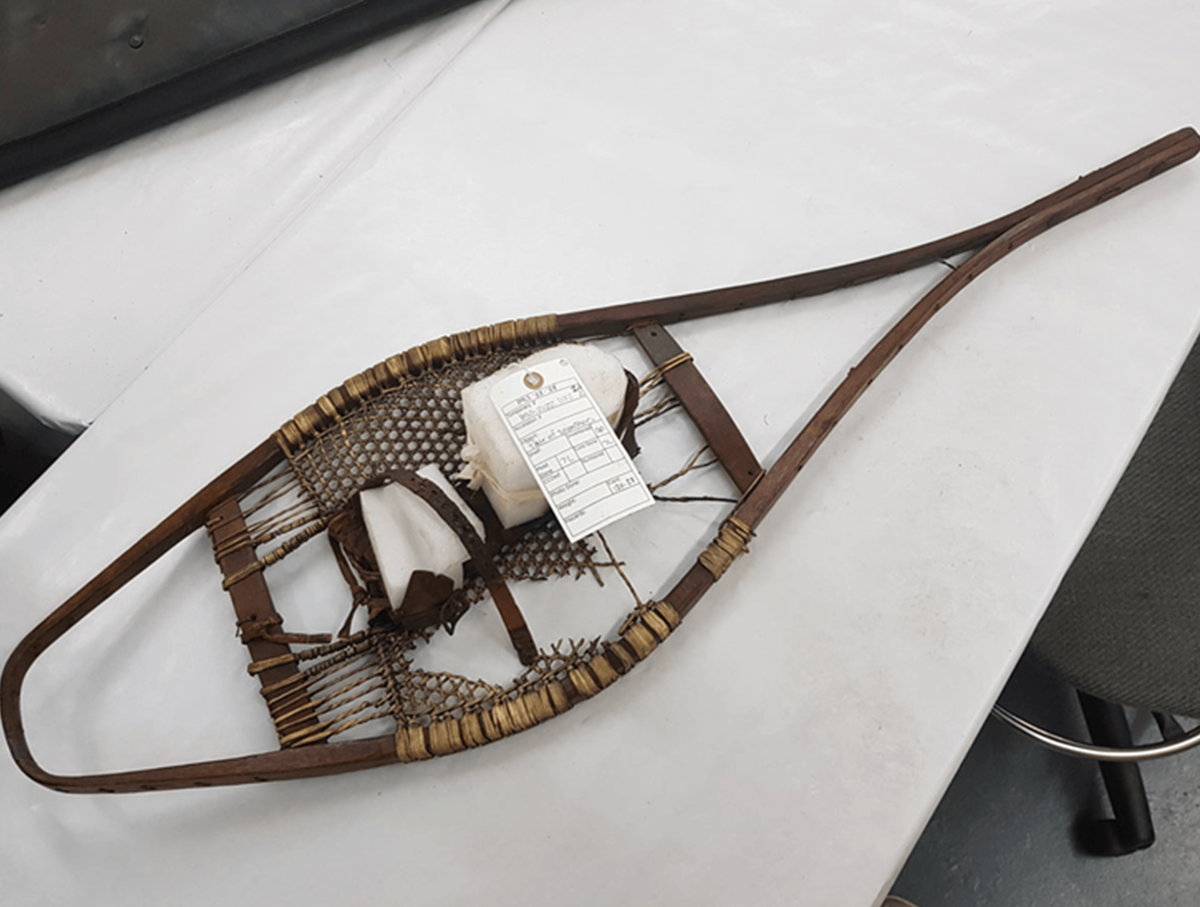
The leather shoe holder is held in place with a foam support to keep the shape and avoid further physical damage. Oil-based gel stain mixed with nutmeg and antique walnut color was applied on the wood surface of the object to match the rest of the color of the wood. / Images by Jeeeun Sims (Jee Eun Lim)
Thanks to the work of the IMLS team, the care and conservation of these organic artifacts is complete. In the photo studio, the snowshoes presented even more complexities.
They proved to be one of the trickiest (and most delicate) objects photographed throughout the IMLS grant project. Senior photographer and studio manager, Jillian Ferraiuolo, outlines below how the snowshoes needed to be handled carefully to be properly photographed.
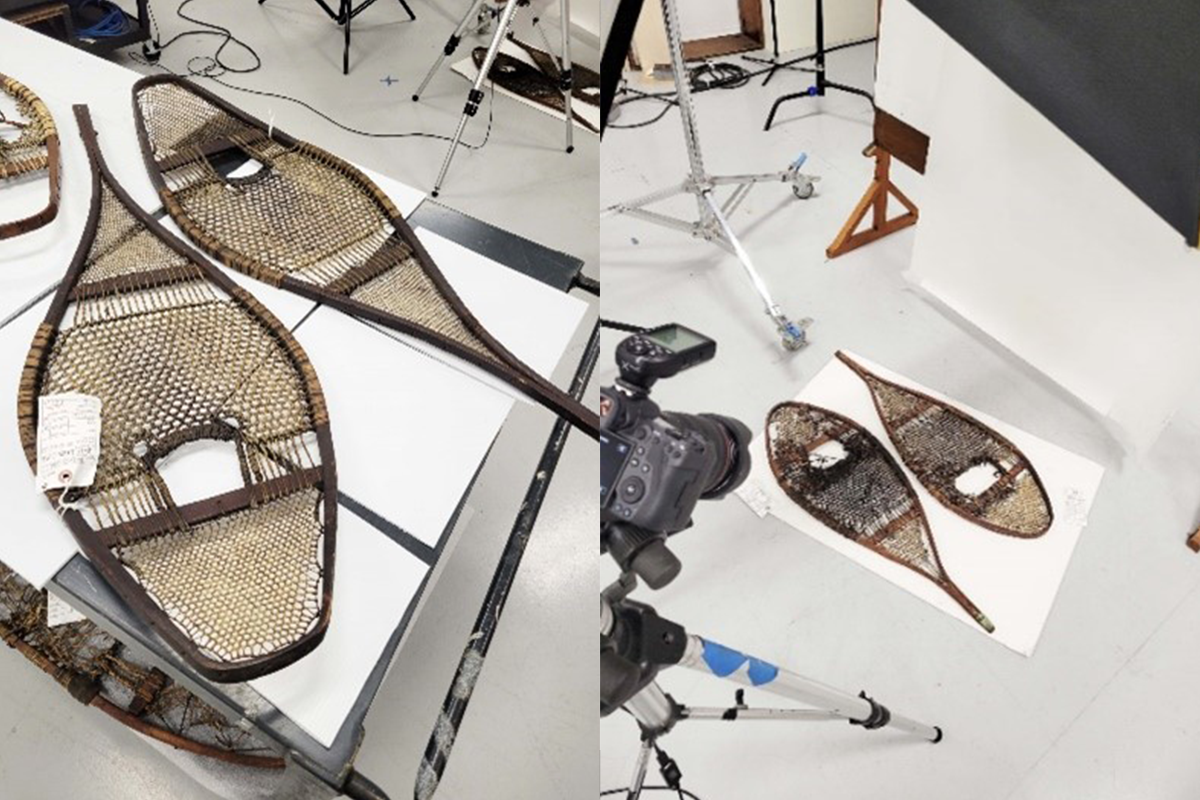
Snowshoes set up for photography / Image by Jillian Ferraiuolo
Because they are so large, the snowshoes were photographed on the ground, with white boards placed underneath to protect them from the floor. A white background also makes it easier to clean the background during the editing phase and remove anything that’s not a part of the object.
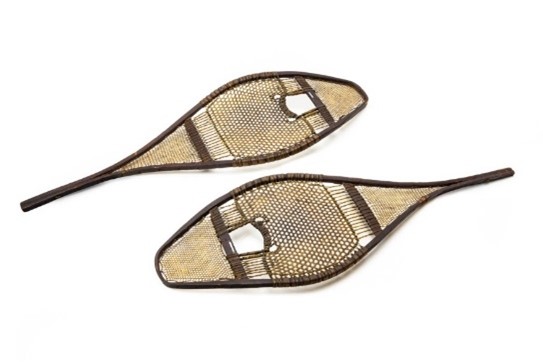
Object 2022.0.22.646 / THF800530
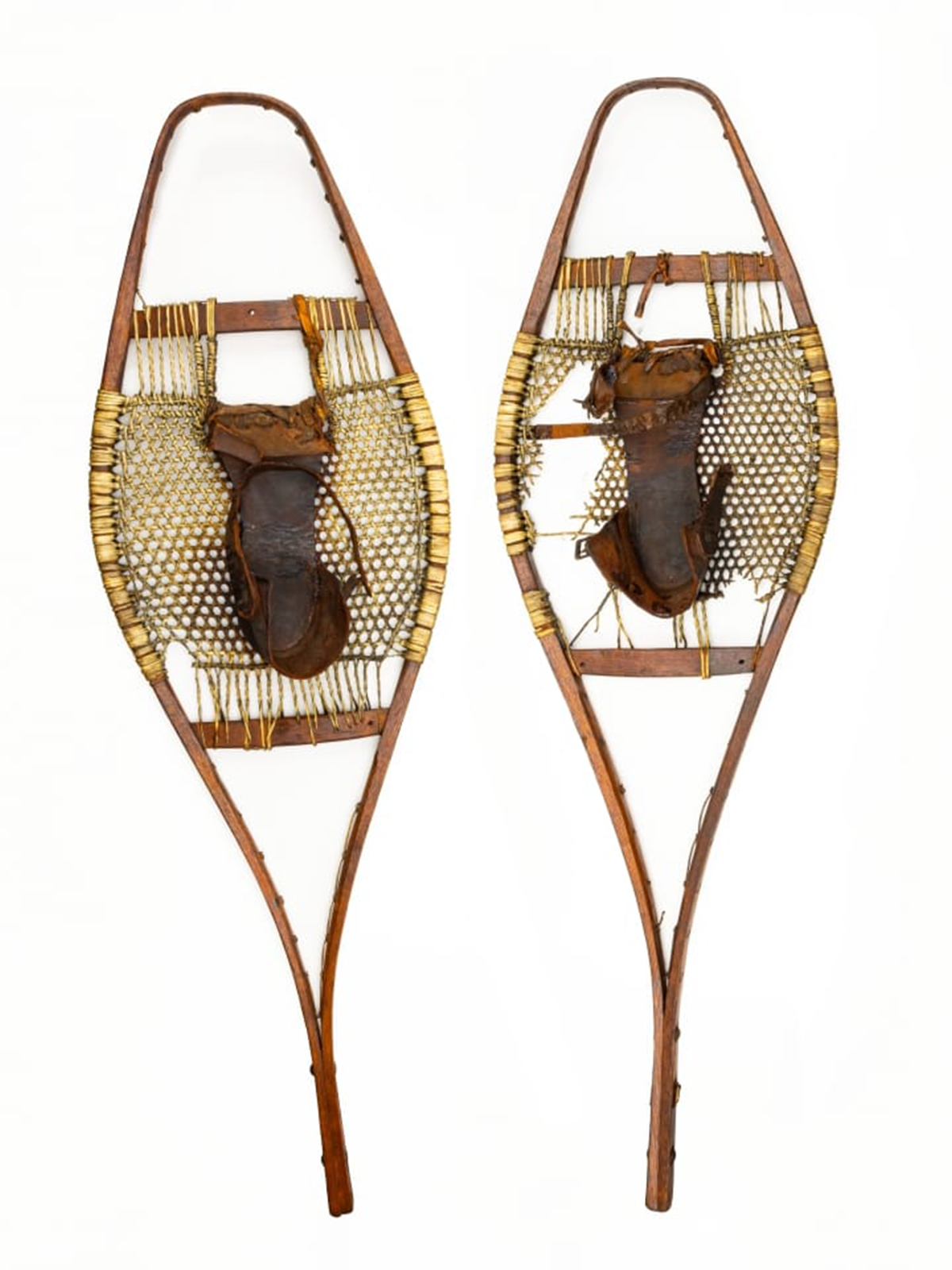
Object 2022.0.22.645 / THF800534
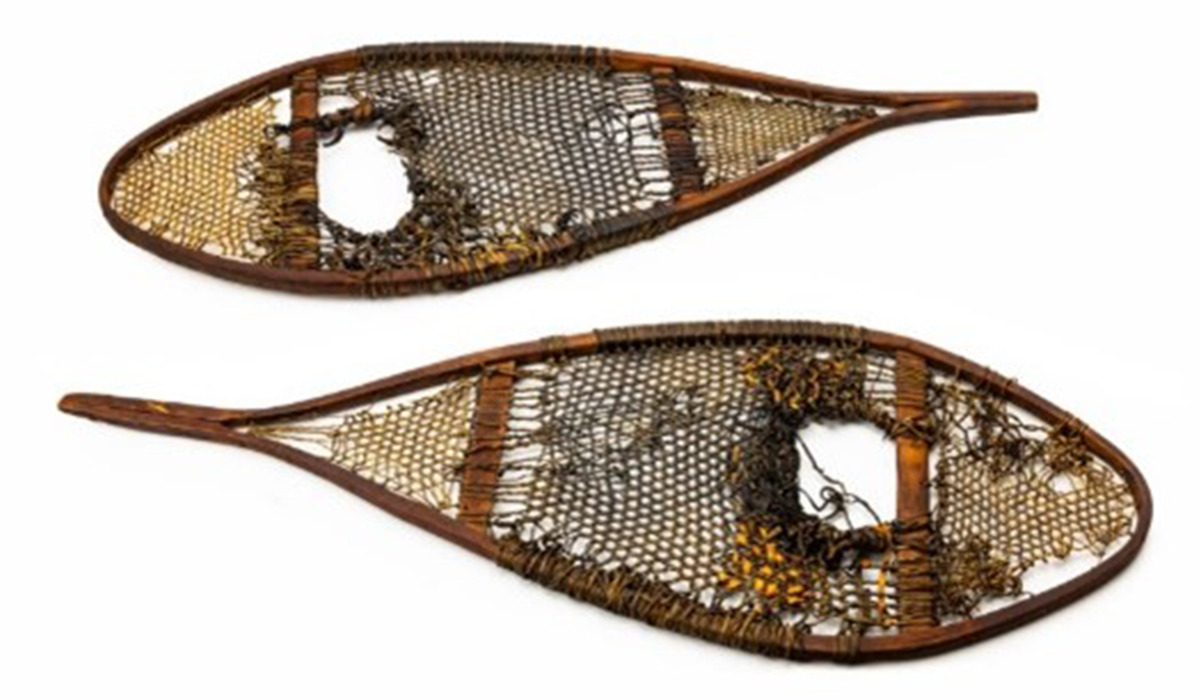
Object 2022.0.22.644 / THF800535
Photographing the snowshoes was one of the final steps towards getting these important objects added to THF’s Digital Collections webpage. Thanks to IMLS funding, these and more artifacts that tell agricultural and environmental histories have become more accessible.
This blog was written by Jeeeun Sims (Jee Eun Lim), IMLS project conservator; Jillian Ferraiuolo, senior photographer & sudio manager; and Debra A. Reid, curator, agriculture and the environment.
Marlene Gray, senior conservator; Julia Fahling, conservation specialist; Eleanor Glenn, former conservation specialist; Mary Fahey, chief conservator; and volunteers (Eric Bergmann, Maria Gramer, Frances McCans, and Larry McCans) assisted Jee throughout the two-year grant project.
Lillian Schwartz’s Works on Paper
Lillian Schwartz (1927-2024) was a unique cultural figure as one of the American pioneers in digital art. Her work is immediately identifiable through her artistic flare. Her pieces tend to be visually jarring in a delightful way, compelling the viewer to look at them from all angles. Schwartz’s early digital art is important because it chronicles significant changes in the computer science field – from the beginnings of software to support creativity to the development of current-day tools such as Adobe Photoshop.
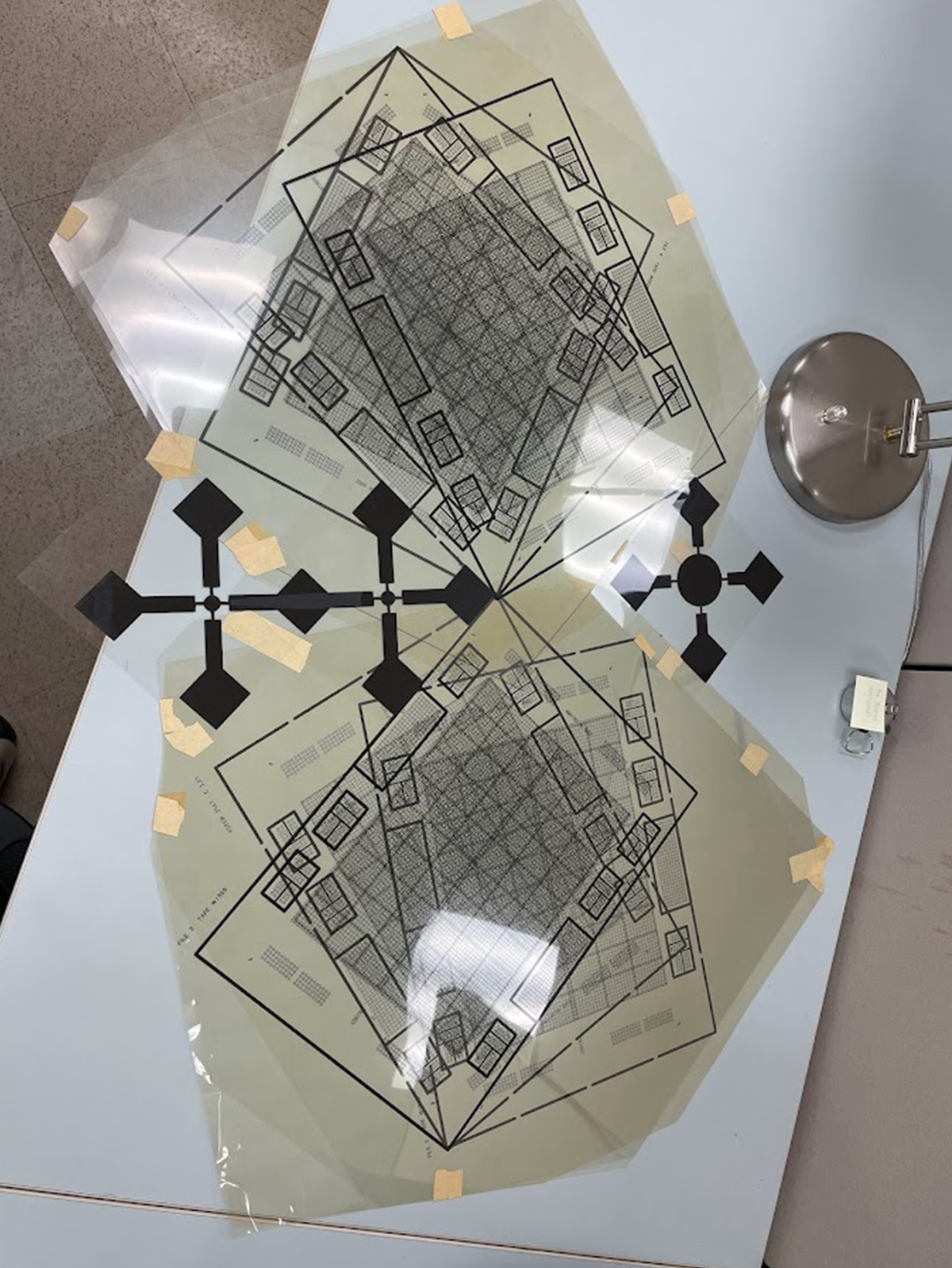
Geometrical Project with Lines, in process, 1970. Acc. 2021.14 / Photo by Regina Parsell
For Schwartz in the early 1970s, a lot of the creative process involved with her 2D works on paper took place after the pieces were printed. For example, when she designed the work Geometrical Project with Lines (1970) she broke the piece down into nine different elements and printed them individually on clear plastic (see above image). These pieces were then arranged and taped together before being copied to create the final image (see below image). Both the assembled version of the work and the copy of it were then kept, but only one displayed. In the same way that math teachers request that students show their work, so that they can follow the student’s thought process, Schwartz preserved part of her artistic genius in keeping these assembled variations, therefore allowing the researcher to better understand her process. This window into her artistic methodology is further illustrated in other works as well.
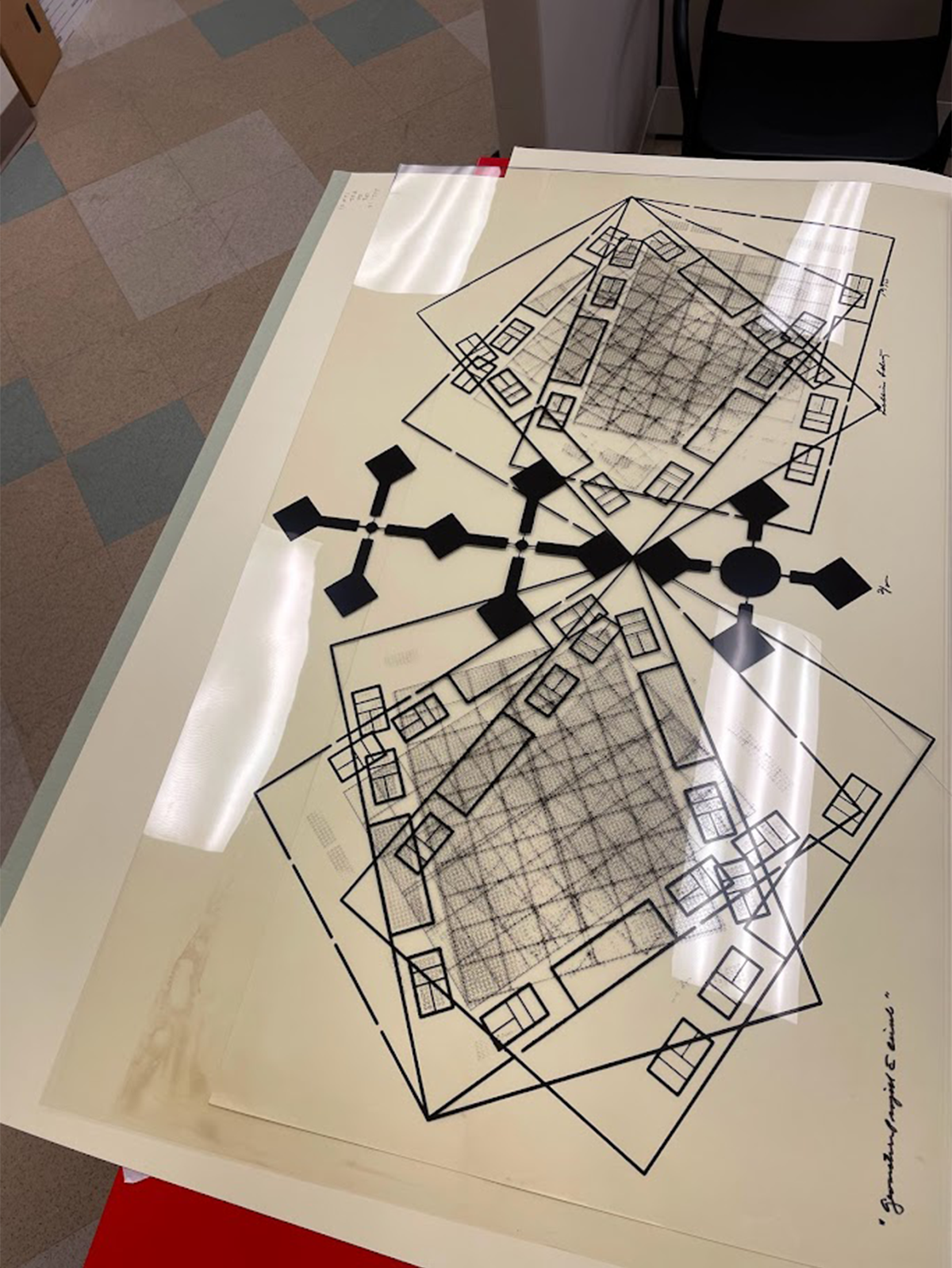
Geometrical Project with Lines, 1970. Acc. 2021.14 / Photo by Regina Parsell
Schwartz viewed the computer as the extension of the artist and would use whatever resources she had available to create her pieces, often imagining multiple versions of a piece rather than a singular resulting image. This can be seen in the two works Variation on a Night Scene and Architecture Test, both are variants made from her works titled Day Scene and Night Scene (all created between 1970-1976). Night Scene itself is a negative of Day Scene, but by taking the central industrial style building at its center, and expanding out, Schwartz created the base image for her next two pieces (see below images).

(Left) Night Scene by Lillian Schwartz, 1986 (which were originally created in 1970-1976). Acc. 2021.14 / THF188523
(Right) Day Scene by Lillian Schwartz, 1972. Acc. 2021.14 / THF628901
Then, taking it one step further, she used tape to black out a few of the clear horizontal lines along the bottom of the composition, and in each corner, before copying the image to make Variation on Night Scene (see below image).
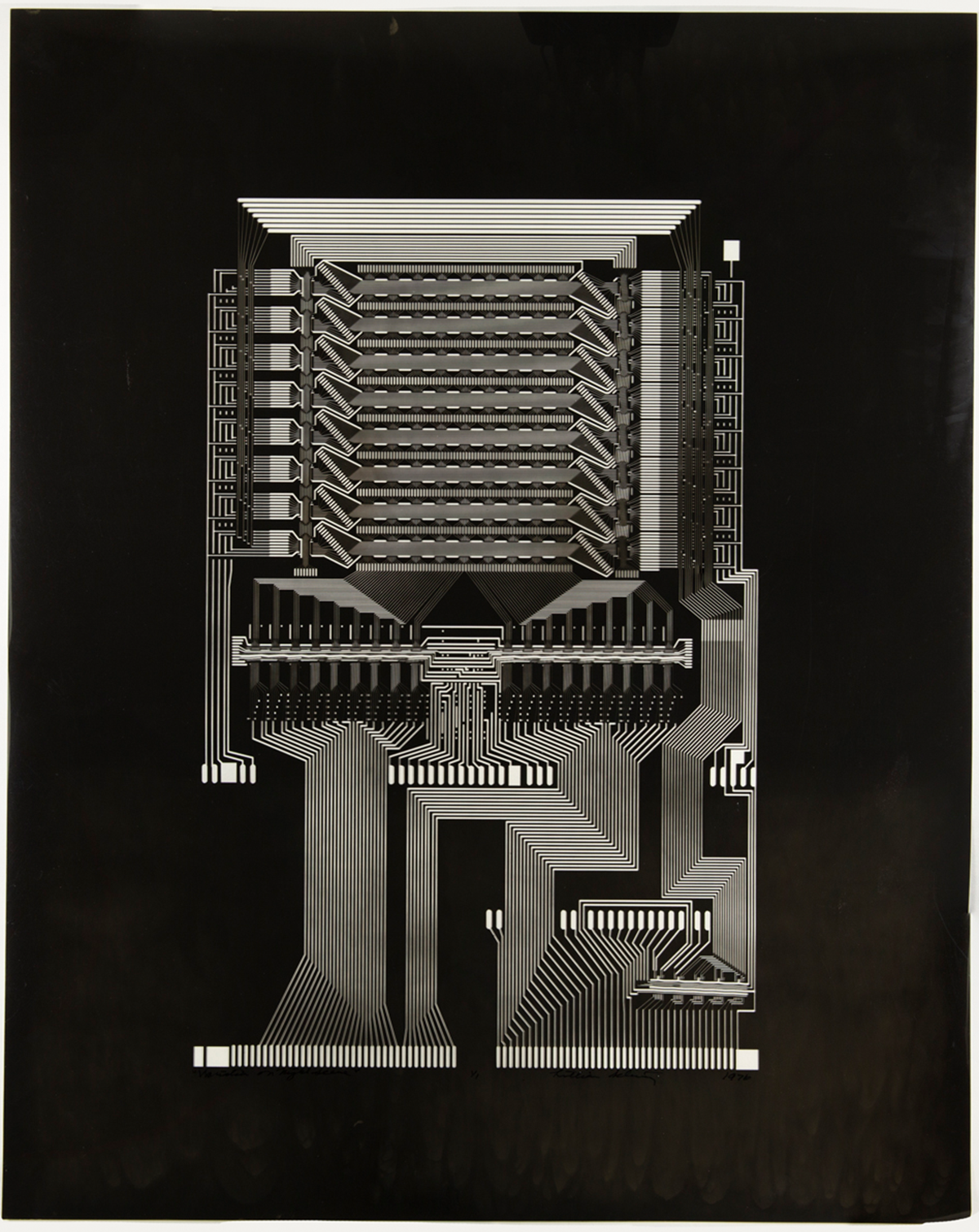
Variation on Night Scene by Lillian Schwartz, 1976. Acc. 2021.14 / THF628890
She then took that same blueprint, and flipped it upside down before copying it again, to create Architecture Test (see below image). When viewed together each composition informs the next, creating an inspired ouroboros effect.

Architecture Test by Lillian Schwartz, 1970. Acc. 2021.14 /THF719821
But it is exactly this iterative practice that can also pose a challenge for the archivist, and one of the key elements to ensuring that Schwartz’s artistic process is preserved is by arranging her archive in a way that makes sense both intellectually and artistically. While Schwartz is a unique artist,it was beneficial to explore the archives of other artists who were also exploring digital art around the same time that she was. To determine the best approach for arranging her collection, we began by reviewing established artist archives. For example, contemporaries of Schwartz include Stan VanDerBeek (1927-1984) and Vera Molnár (1924-2023), who also worked in the mediums of computer films, animation, and computer-generated and born-digital work.

Tree, Tif, by Lillian Schwartz, 2000. Acc. 2021.14 / Photo by Regina Parsell
To capture the integrity of the artists’ methodology, art collections are often arranged by project. This means that all materials related to one piece are kept together and cataloged accordingly. Before we could arrange the Schwartz collection, we had to inventory the artwork and confirm the locations of the pieces within various storage areas of The Henry Ford. The Schwartz collection is close to 400 cubic feet of materials (including research notes, ephemera, publications, project notes), of which the artwork itself is just shy of 30 cubic feet of material. Inventorying just the 2D artwork has taken about a year to complete. Now that this step is complete, the next step is to arrange the materials by using a spreadsheet to find commonalities in the pieces' descriptions and titles. A collection of this size will take several weeks to physically arrange, so there needs to be a clear plan for where the pieces are going to reside in archival storage. Once that plan has been approved, then the process of moving the materials and updating their locations in the cataloging system and inventory sheets can begin.
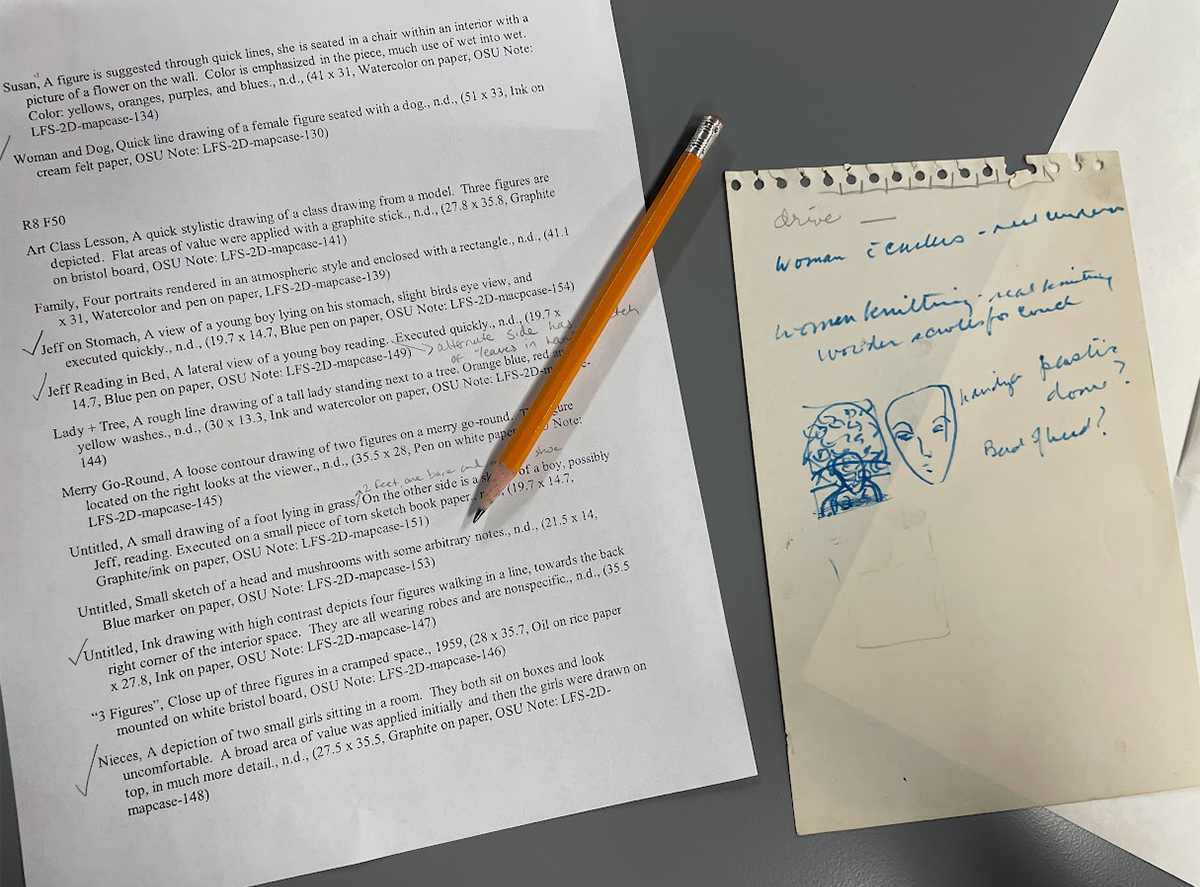
Drive by Lillian Schwartz, undated, and previous inventory of artwork located in flat files. Acc. 2021.14 / Photo by Regina Parsell
Archiving artist work and materials is important but challenging work. It asks us to think not only about how the artist intended for us to see their work, but also how the researcher will use these materials. As we expand and develop our understanding of cataloging non-traditional media, we continue to think outside the box in order to preserve their iterative process and artistic innovation. Our work with the Schwartz collection is far from complete, and while it has been complex, it has also been incredibly rewarding. One of the greatest parts of being an archivist is learning about the person from their own notes and works, and it has been a pleasure to get to know Lillian Schwartz and her work throughout this process.
Regina Parsell is a processing archivist at The Henry Ford.
Americans on Ice: Skating and Skate Technology in the United States
Archeological evidence suggests that ice skating began as early as 4,000 years ago in northern Europe. Travelling on foot in winter across snowy, icy landscapes for trade, hunting, and community gatherings was slow and exhausting. People first used sharpened animal bones attached to footwear by leather strips, along with poles, to propel themselves across frozen rivers, ponds, and lakes – faster and less taxing during harsh winter months.
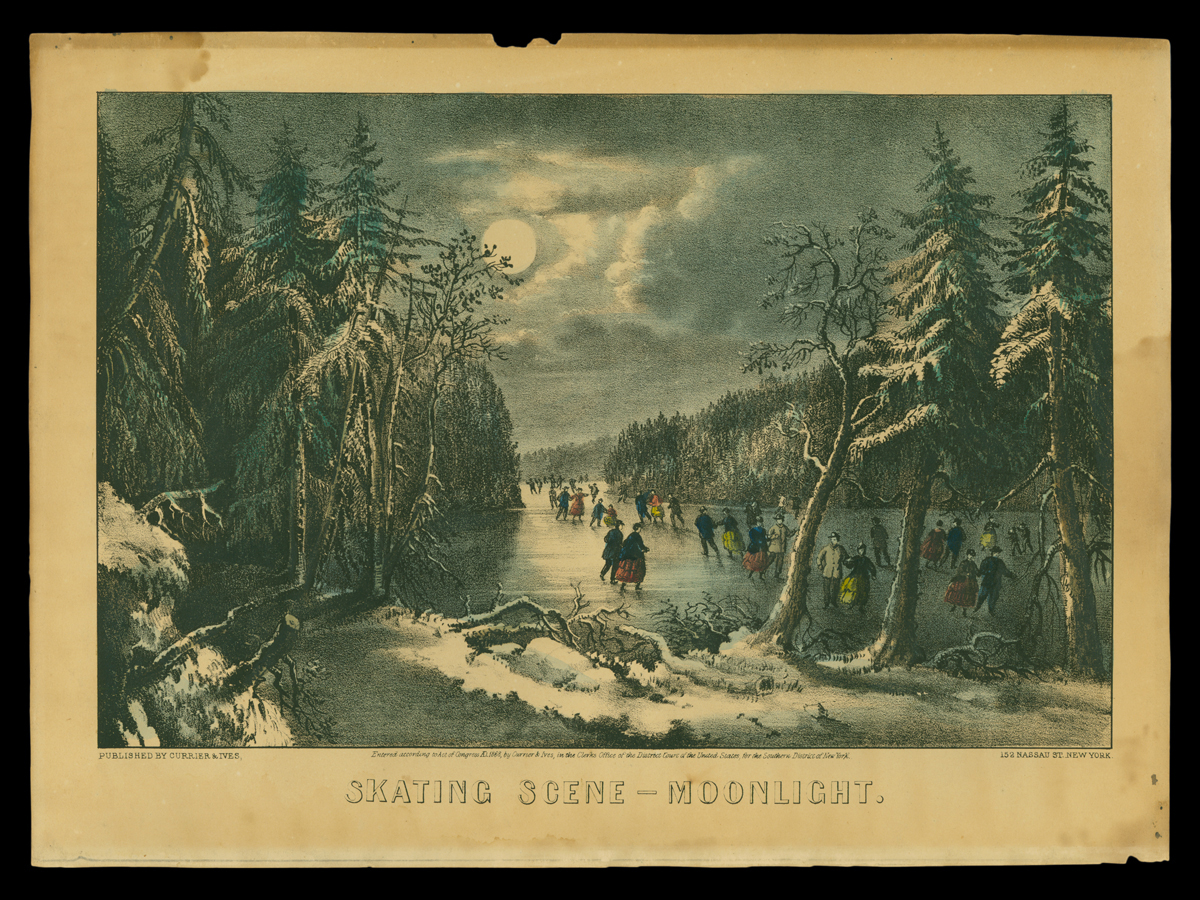
Currier & Ives published this lithograph in 1868 of skaters on a frozen lake or pond at night, skating by moonlight. / THF118602
As a pastime, ice skating became popular in the United States in the mid-19th century. Initially, people skated on frozen local rivers and ponds, but as artificial ice-making improved, skating moved indoors to purpose-built rinks. Temperature-controlled buildings and artificial ice technology made it possible for ice skating to spread south and west from New England and the Upper Midwest. Skating clubs started forming across the country as early as 1849, and these clubs hosted evening skating events with live musical accompaniment .
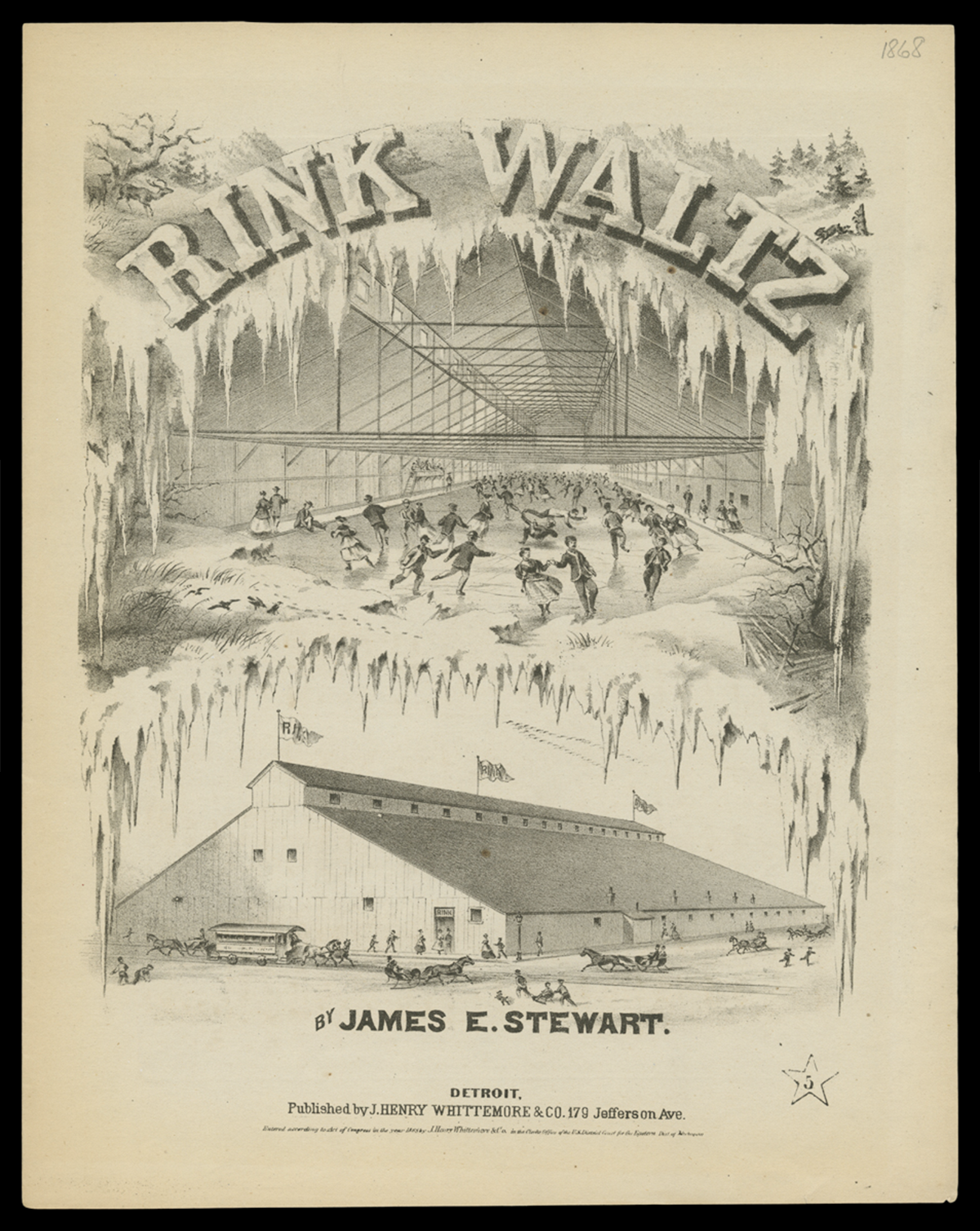
The song Rink Waltz was written and published in Detroit in 1868. Its cover has interior and exterior renderings of the Detroit Skating Rink, which opened in 1866. / THF720452
Ice skating’s popularity peaked in the 1860s and 1870s. During this time, many patents for skates were issued to ice skate manufacturers. Publications on skating skills and safety, along with songs about skating, became widespread. Other products, such as handheld kerosene lanterns to illuminate outdoor skating at night, also show how ingrained skating had become in American culture. Women in particular embraced ice skating, which was promoted as healthy exercise and one of the few athletic activities socially acceptable for women at that time.
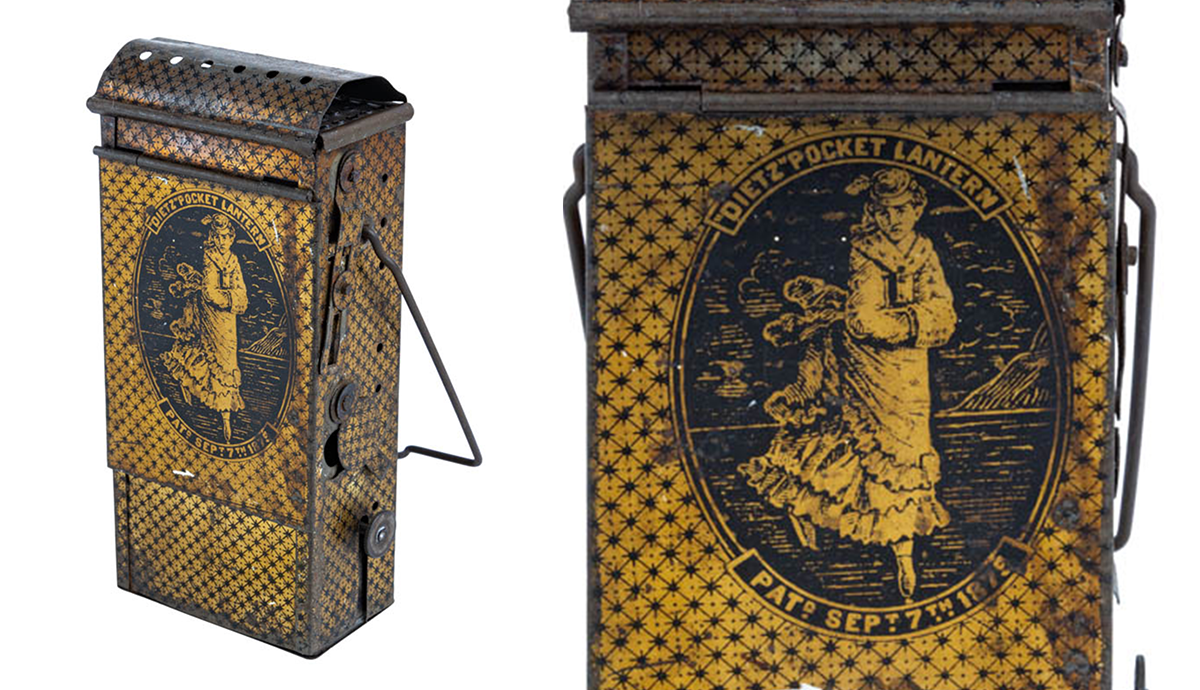
Lighting companies such as R.E. Dietz patented small kerosene lanterns for nighttime skaters, particularly women. / THF802186 (left), THF802187 (right, crop)
Improving Skate Technology
Early skates were made using animal bones. In the 13th and 14th centuries, craftspeople started to fabricate metal blades, which were inserted into wooden platforms. Straps, ropes, or ties secured the platform to skaters’ everyday footwear. These early blades were long and curled up in front of the toes, helping the skater navigate uneven and rough ice on frozen waterways. This type of skate was likely the kind first imported into the United States from Europe in the late 18th and early 19th centuries. Blacksmiths and carpenters in northern American towns and cities also produced skates, and some skaters even made their own.
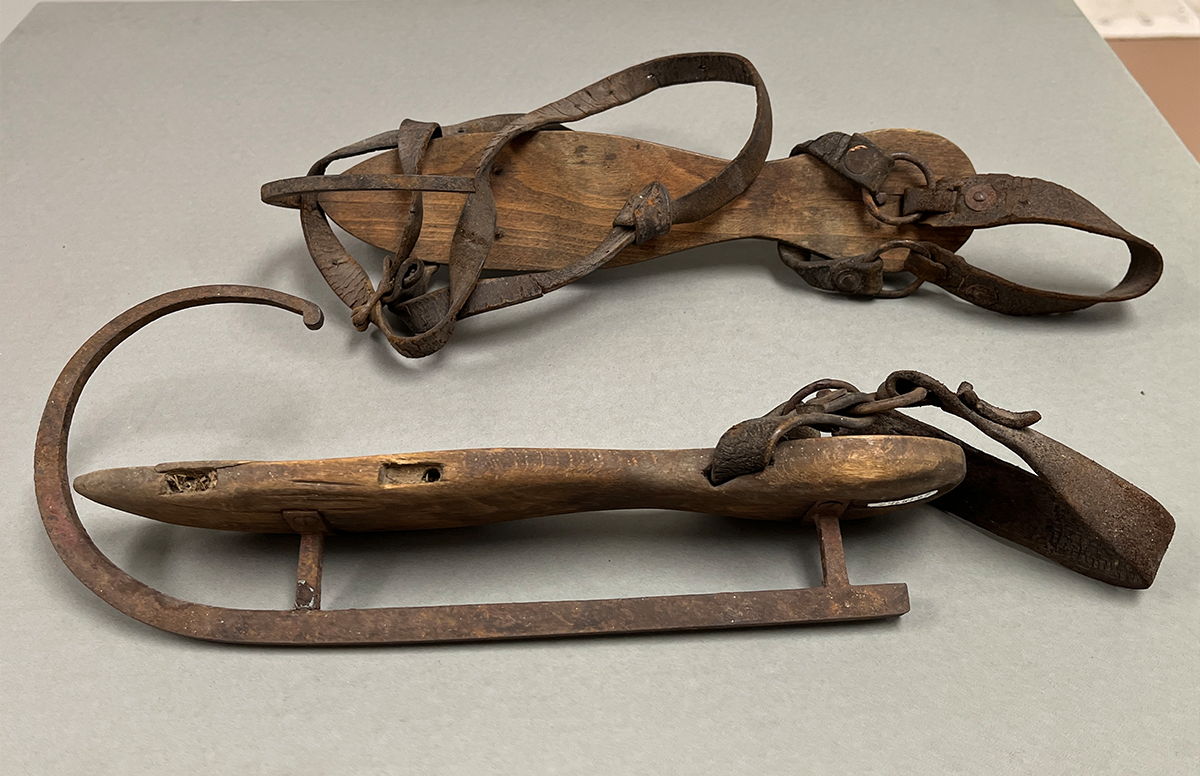
Ice skates with crude wood platforms, curled metal blades, and leather straps. / 29.1871.2, From the Collections of The Henry Ford. Photo by Aimee Burpee.
Unfortunately, ties or straps were often unreliable. They did not secure the foot and shoes firmly in the skates, as the foot could slide side to side or even slip off the platform. To improve the attachment, manufacturers and craftspeople added a metal spike on the top of each wooden platform, which went into the heel of the shoe, and occasionally small spikes in the forefoot for additional attachment.
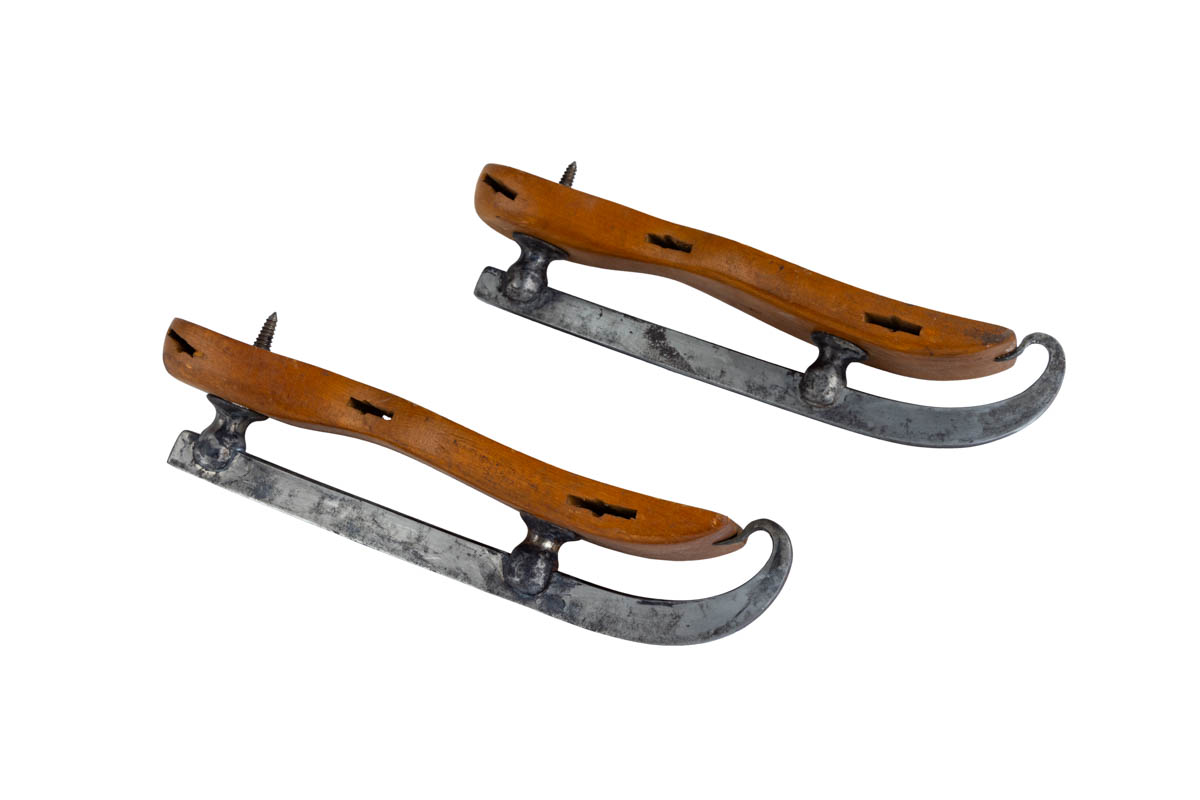
These Douglas, Rogers & Co. skates with 1863 patent date have a spike in the heel to attach the shoe to the platform, and tempered metal blades. Straps went through the holes in the sides of the platforms / THF802180
Eventually metal platforms replaced wooden ones, which cracked or splintered and required frequent repairs. The earliest metal platform skates still used ties and straps, but eventually switched to keys and clamps that more securely attached and tightened the skates to the wearer's shoes. By the 1890s, fully metal skates allowed people to simply “step into” the skate, with automatic clamps securing the skate around the shoes. These metal skates were stronger and more dependable, making them especially appealing to the rapidly growing market of hockey players and early figure skaters.
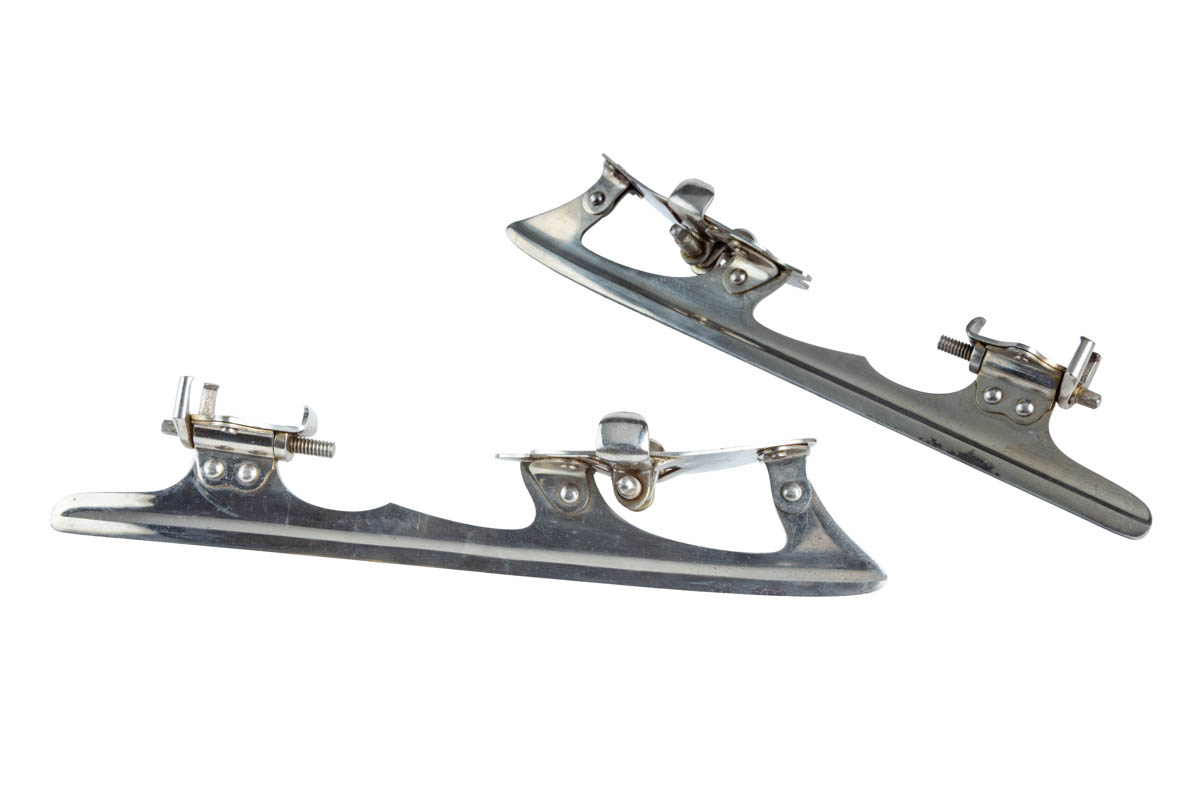
Barney & Berry patented these skates 1896, with clamps that hooked around the shoe when you stepped into them, no fiddling with straps or tightening with a skate key was necessary. / THF802173
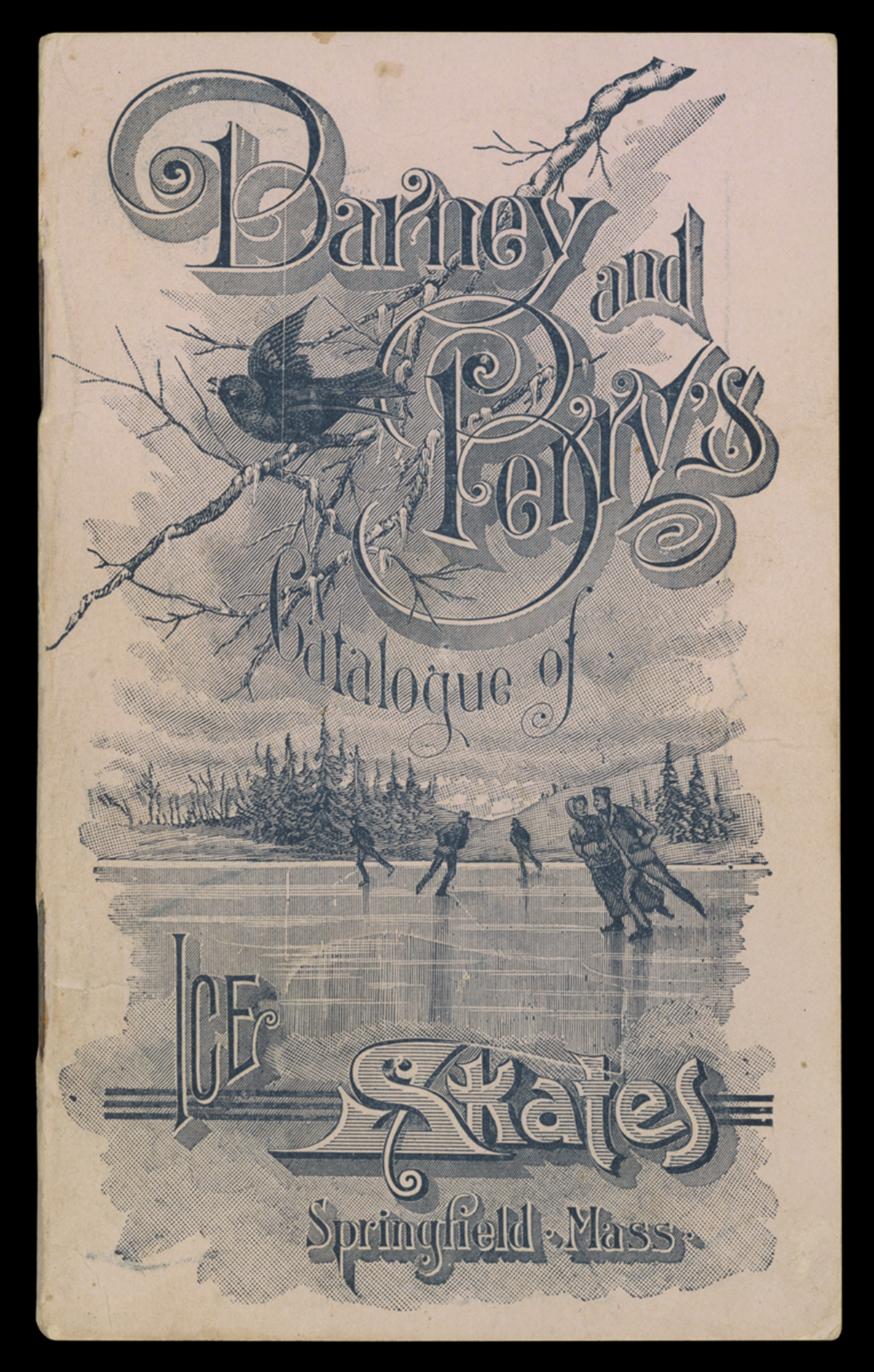
Barney & Berry was one of the top innovators and manufacturers of ice skates. Hardware, sporting goods, and toy stores could choose models and styles from this 1894-1895 wholesale catalog to sell to customers. / THF720461
In the late 19th and early 20th centuries, ice skates became one-piece boots, resembling the skates we use today. These skates provided greater support and stability, with the blade attached to a steel sole and integrated into a boot. While earlier skates started the development of specialized skates for figure skating, hockey, and speed skating, the one-piece boot skate further refined these specializations.
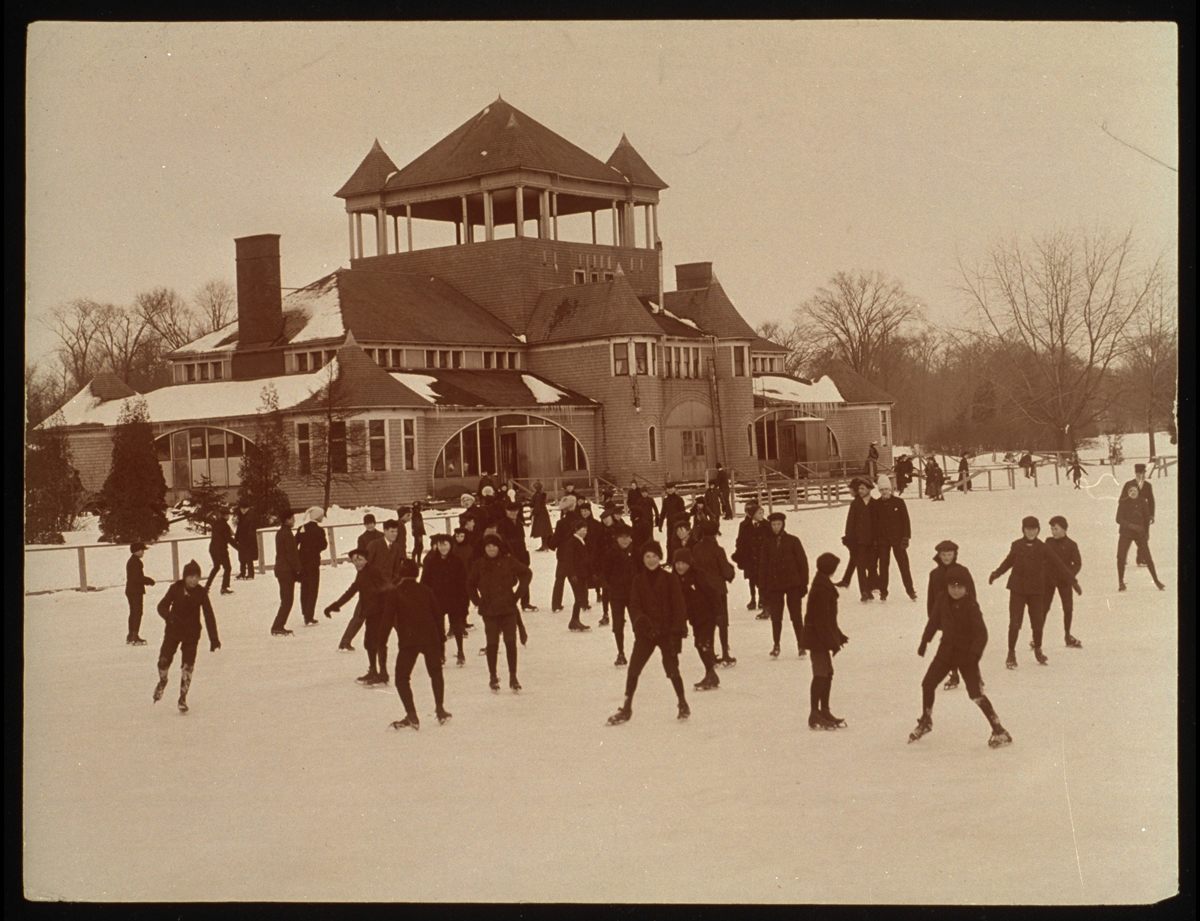
Children and adults could rent skates from the Belle Isle Pavilion and skate on adjacent Lake Takoma on Belle Isle in Detroit, Michigan, around 1900. / THF119081
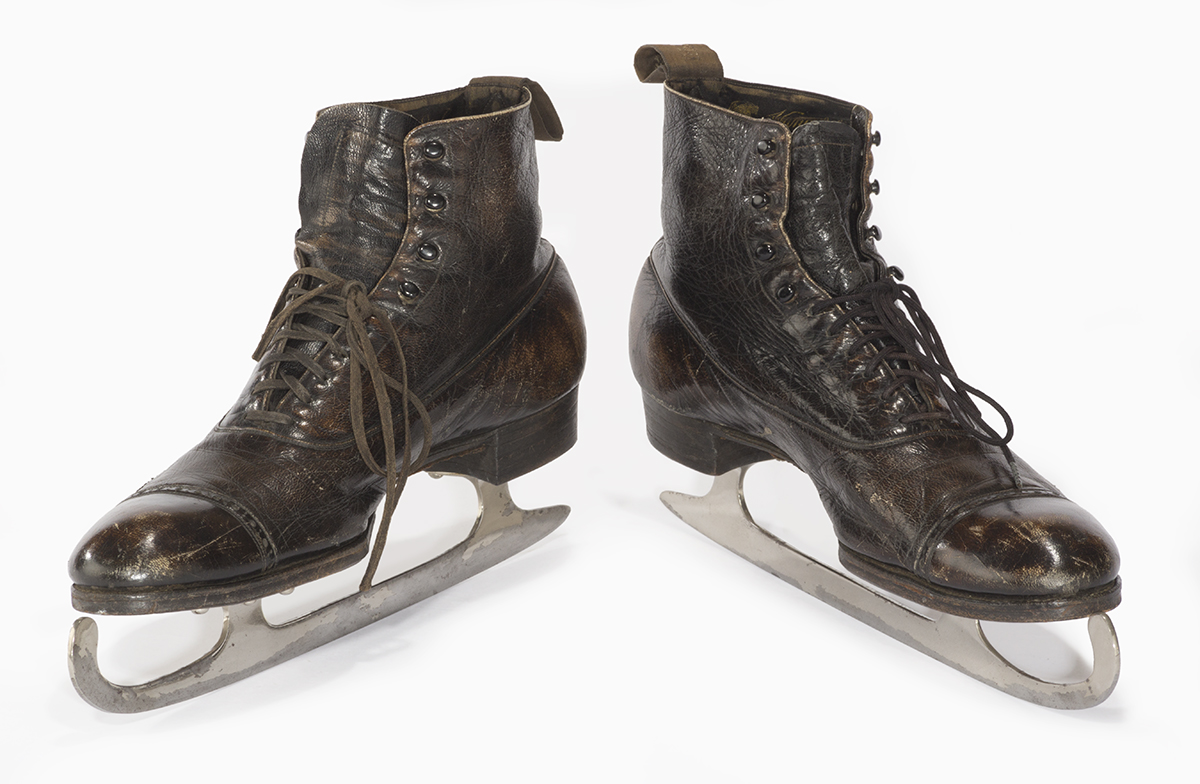
These all-in-one boot skates belonged to Henry Ford. He enjoyed skating on a frozen pond on his Fair Lane property in Dearborn, Michigan / THF166350
Today, figure skates combine slim leather boots with toe picks for spins and jumps. Hockey skates have shorter blades for quick maneuvering, with padded foot and ankle protection. Speed skates feature longer blades and a more streamlined boot profile to decrease wind resistance.
The skates of the past led to the skates of today. And the skates of the future will continue to evolve as innovative technologies, designs, and materials are developed and implemented.
Aimee Burpee is Associate Curator at The Henry Ford

